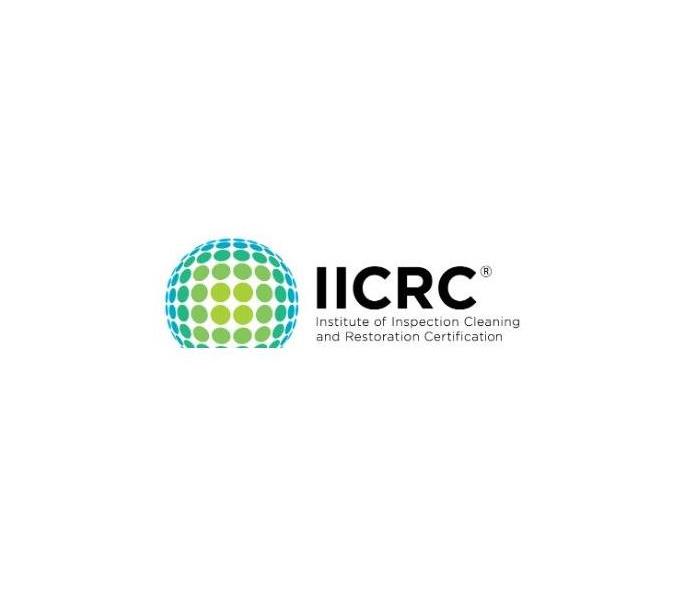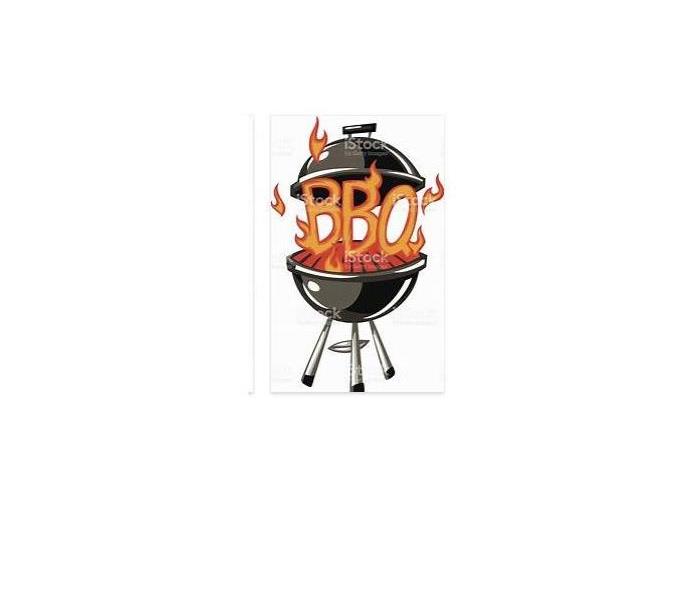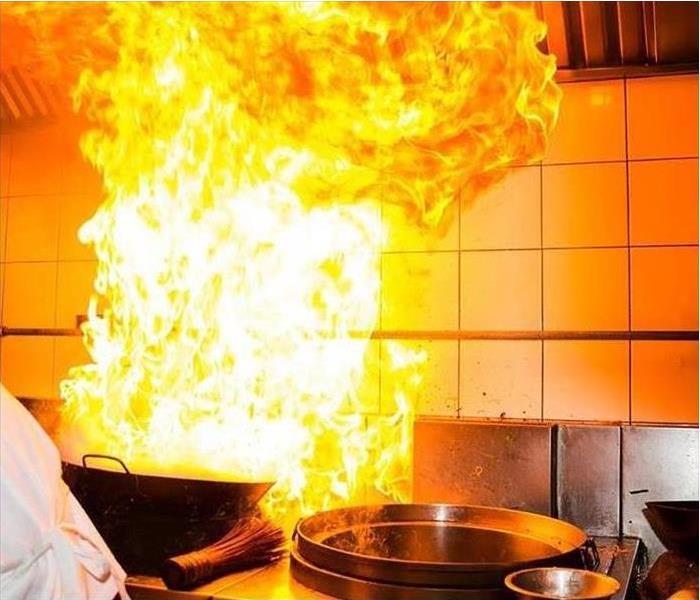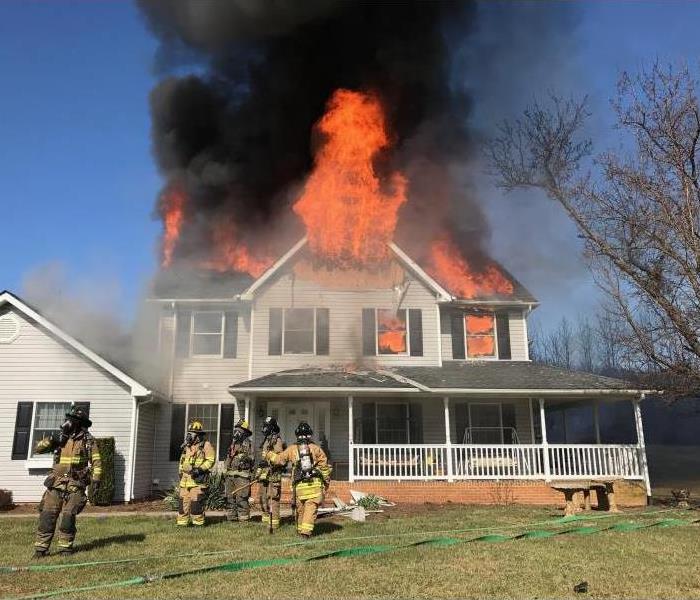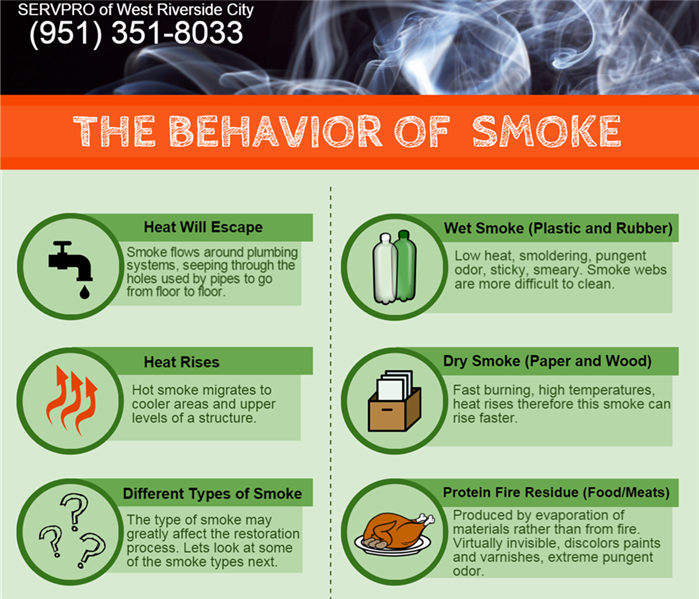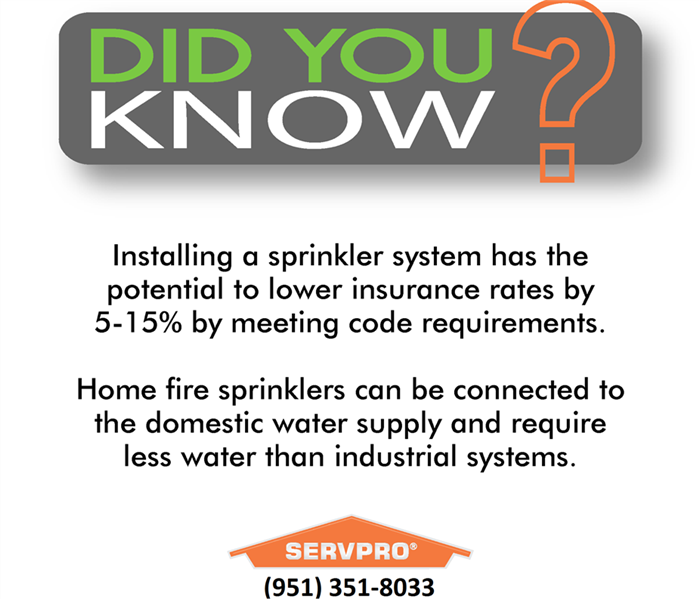Recent Fire Damage Posts
Is Your Riverside Home Clothes Dryer Hiding Something
1/8/2025 (Permalink)
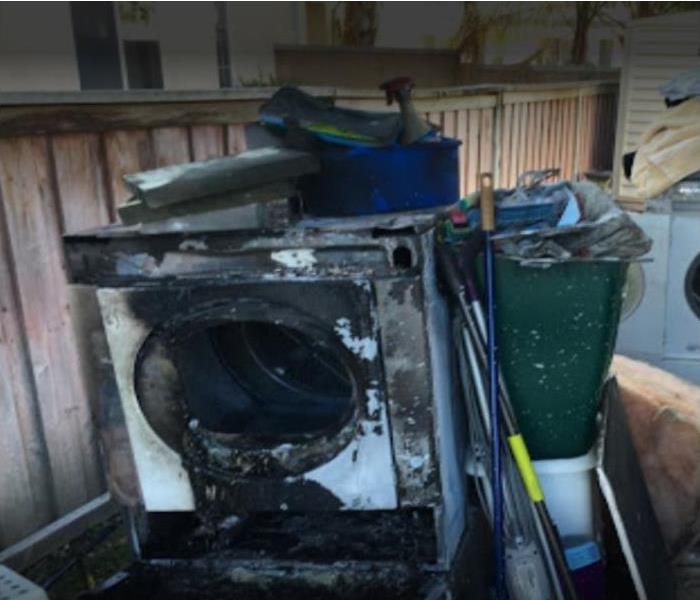 If clothes are still damp after a normal cycle, the lint screen or exhaust vent may be blocked. Hire a professional to clean your dryer and dryer duct
If clothes are still damp after a normal cycle, the lint screen or exhaust vent may be blocked. Hire a professional to clean your dryer and dryer duct
Do you clean your lint trap every time you use your clothes dryer?
The dryer duct is the length of tubing that connects your dryer to an exterior wall where hot air exhausts can be released. This is not the lint screen (the thing you pull out that traps all the hair/lint). Lint screens are usually very easy to access and usually can be found on top of the dryer or right inside the dryer.
Did you know that dryers can cause a home fire?
The highest percentage of home dryer fires stem from the following:
Failure to adequately clean the dryer (32%)Mechanical failure or malfunction (27%)Electrical failure or malfunction (16%)Accordingly, the items most likely to ignite first in a dryer fire are as follows:
Dust, fiber and lint (27%)Clothing (25%)Appliance housing or casing (12%)Here are some tips to prevent dryer fires:
Installation
Have your clothes dryer installed by a professional.Make sure the correct electrical plug and outlet are used and that the dryer is connected properly.Read manufacturers' instructions and warnings in use and care manuals that come with new dryers.Cleaning
Clean the lint filter before and after each load of laundry. Don’t forget to clean the back of the dryer where lint can build up. In addition, clean the lint filter with a nylon brush at least every six months or more often if it becomes clogged.Clean lint out of the vent pipe every three months.Have your dryer cleaned regularly by a professional, especially if it is taking longer than normal for clothes to dry.Maintenance
Inspect the venting system behind the dryer to ensure it is not damaged or restricted.Put a covering on outside wall dampers to keep out rain, snow and dirt.Make sure the outdoor vent covering opens when the dryer is on.Replace coiled-wire foil or plastic venting with rigid, non-ribbed metal duct.Have gas-powered dryers inspected every year by a professional to ensure that the gas line and connection are together and free of leaks.Check regularly to make sure nests of small animals and insects are not blocking the outside vent.Keep the area around the clothes dryer free of items that can burn.If you will be away from home for an extended time, unplug or disconnect the dryer.Source: prevent home fires
About SERVPRO of West Riverside City
SERVPRO of West Riverside City specializes in the cleanup and restoration of residential and commercial property after a fire, smoke or water damage event. Our staff is highly trained in property damage restoration. From initial and ongoing training at SERVPRO’s corporate training facility to regular IICRC-industry certification, rest assured our staff is equipped with the knowledge to restore your property.
If you need help with cleaning out your home or dryer vent call the Professionals at SERVPRO of West Riverside City 24/7 951.351.8033
Tips for Making a Claim After a Fire
8/12/2024 (Permalink)
When a fire damages your home in Riverside, CA, you may not be in the right frame of mind for making good decisions.
The decisions you make regarding your fire insurance claim, however, can affect how much of the fire restoration is covered by your insurer. Here are three tips to help you think through the process rationally and hopefully get the settlement you need to restore your home.
1. Call Insurance Company
One of the first calls you make after a fire has ravaged your home is to the insurance company. Timely reporting is essential to getting your claim processed and approved. As soon as the company receives your call, an assessor can be sent to review the damage and substantiate your claim.
2. Call a Professional Restoration Company
After a fire, your home is likely permeated with the odor of smoke and soot damage. Firefighters probably had to use a lot of water to put out the fire, resulting in water damage as well. Certified fire restoration specialists offer both smoke cleaning and water damage remediation to fix the problems in your home. They often offer board-up services to secure the house during the restoration process, and they can give you an estimate on what the repairs are going to cost, which can back up your claim with the insurance company.
3. Don't Touch Anything
Once you have made the necessary calls and the waiting begins, you may be tempted to start cleaning up the damage yourself. Fight the urge to do so. The insurance agent that comes to assess the damage needs to see it as it is, and without the knowledge and skills of the specialists, you may cause more damage. While you wait, it is a good idea to take pictures of the damage as long as it is safe to do so.
You may feel powerless when your home suffers fire damage. By calling the appropriate professionals and waiting on their guidance, however, you can speed up the fire restoration process.
Contact SERVPRO of West Riverside City
When Fire Damage Strikes Your Riverside Home
7/31/2023 (Permalink)
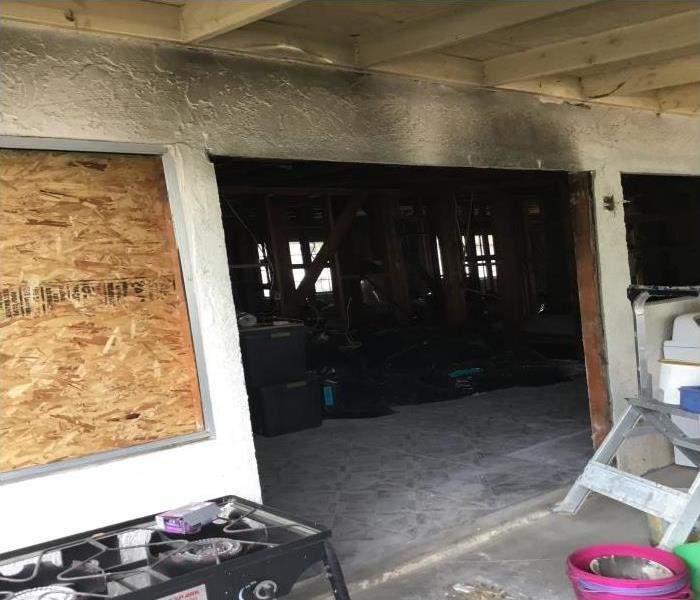 Board up damaged windows after a fire protects your home from further damage.
Board up damaged windows after a fire protects your home from further damage.
Did you know that some insurance companies deny at least part of a fire insurance claim if it finds that a property owner did not try to protect their property from secondary damage?
This can be avoided by hiring SERVPRO of West Riverside city to do emergency board up and roof tarping.
After fire damage, many properties experience damaged roofs, windows, doors, and even damaged outer walls. This type of damage makes a building susceptible to secondary damage. Weather can come in and cause water damage and mold. Easy access also makes it easy for theft to occur.
For these reasons, we recommend emergency fire damage services as soon as the fire department has left.
We can:
- Attach a weatherproof roof tarp.
- Board up damaged doors, windows, and outer walls.
- Perform an emergency pack out
After your property is secure, we can inspect your property and begin fire damage cleanup and remediation services as well as rebuilding your property.
Call 951-351-8033
Riverside Residents, Are You Aware of Travel Trailer Fires?
7/20/2023 (Permalink)
Motor homes, campers, and recreational vehicles are used for living and traveling. Each year, fires in them cause deaths, injuries, and millions of dollars in damages. Fires can start in the kitchen. They can start in the engine area. Sometimes the fires are electrical. With a few simple safety tips you can help prevent these fires from happening.
Most people do not realize that every year there are several hundred fires caused by electrical and cook top stoves in travel trailers. These fires can be anywhere from a small amount of soot to the extreme loss. Let SERVPRO of West Riverside city come out to perform a free estimate today.
Here are safety Tips from NFPA:
SAFETY TIPS
• Install smoke alarms. Make sure they work.
• Stay in the kitchen while you cook. Keep anything that can catch fire away from the stovetop.
• Only use one heat-producing appliance plugged into a receptacle outlet at a time. Major appliances should be plugged directly into a wall receptacle outlet.
• Refrigerators, furnaces, ovens and stovetops use propane. Check them for leaks. Keep an updated gas leak detector on board.
• Have your propane system inspected to make sure it still works properly.
• Know two ways out. Make sure windows open easily.
• Have everyone practice the home fire escape plan.
• Do not keep camping heaters and lanterns on while sleeping.
• Before setting up a campfire, make sure it is allowed.
• If campfires are allowed, they need to be at least 25 feet away from anything that can burn.
• Have your vehicle serviced by a qualified mechanic.
• Keep a portable fire extinguisher on board. Only adults who know how to operate it should use it. Only use it if the fire is small and can be contained. Make sure everyone else is leaving. Make sure someone is calling the fire department.
Most of these fires can be cleaned to pre loss condition if the owner acts fast. The fire Extinguisher dust can penetrate every inch of a trailer making it very difficult to restore. Trailers need to be mitigated professionally by SERVPRO of West Riverside city.
Contact SERVPRO of West Riverside city 951-351-8033 to help with the restoration process after your trailer fire loss so we can get you back on the road and on with your travels.
Fire or Smoke Damages to your Riverside Home or Business
7/18/2023 (Permalink)
 Fire is devastating, we have helped families through this difficult process.
Fire is devastating, we have helped families through this difficult process.
Did you know? Hot smoke migrates to cooler areas.
Smoke migrates to upper levels of a structure.
Smoke flows through plumbing systems, using holes around pipes to go floor to floor.
The type of smoke will greatly affect the restoration process.
Even what seems to be a small fire can cause odors for years to come if the affected areas are not properly cleaned and deodorized or if the burned material is not addressed properly and removed.
Fire, smoke and soot damage in your home or business can create unpleasant and potentially permanent problems if not addressed properly.
As various materials burn, the smoke produced travels throughout the structure, leaving odorous residues and deposits on surfaces and in hard-to-reach places. Unless fast, professional action is taken, these residues and deposits can cause permanent damage to contents and may result in resurfacing odors.
Our SERVPRO team members know how to handle a fire loss and have received the proper training needed to address your loss.
SERVPRO is a preferred vendor on all of your major insurance company's lists.
Contact us today at : 951-351-8033
What is the Difference Between a Protein Fire and Typical Fire?
4/18/2022 (Permalink)
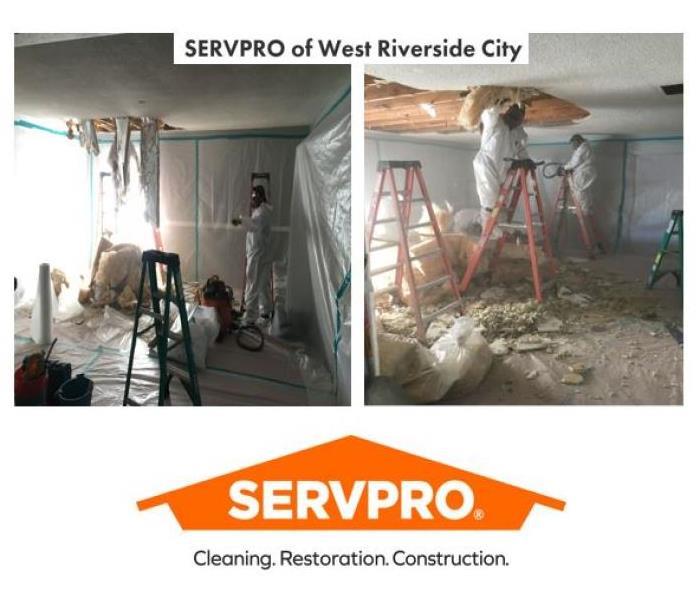 A protein fire caused the damage in this Riverside home. The smell permeated into the insulation. SERVPRO of West Riverside city was called to help!
A protein fire caused the damage in this Riverside home. The smell permeated into the insulation. SERVPRO of West Riverside city was called to help!
You're cooking a ribeye on the stove, you get distracted and forget you have it cooking.
Wait! What's that smell? You've burnt the rib eye that you left unattended in the pan!
Protein Fire occurs when the decomposition of animal fats from beef, poultry, fish among others produces a fine clear mist, which has a very obnoxious odor that is capable of penetrating even the smallest of areas.
Many homeowners may think a home fire is a home fire but there is a big difference between protein fires versus typical fires. Many homeowners underestimate the damage of a protein fire because they don’t see the “typical” black smoke residue commonly associated with home fires. A protein fire produces a fine mist that has a rancid strong odor that can also compromise structural materials and contents in the home. These protein residues can penetrate cabinets, drawers, air ducts, furniture and clothing. A quick fix cleanup will not adequately remove the mist and odors as the proper cleaning steps are required to remove this odor from the structure and contents. It takes extensive cleaning of walls, floors, ceiling and contents of the home to rid the home of this offensive odor.
How Does the Fire Start?
It’s actually not the meat that catches fire but the grease. As the meat slowly cooks in the pan, the sides get coated with grease, which is what catches fire first. The burnt meat adds to the catalyst and that’s how the flame rises. Grease fire can quickly spread all over the stove if the knobs and other areas are covered with grease too. The soot slowly starts to cover the walls and floor which makes the tiles slippery and greasy.
When you enter the kitchen, the smoke smell goes through you and folds you in its odor. Your clothing smells like smoke, as well as your hair. The smoke smell permeates the house for days.
What Are the Signs of a Protein Fire?
The signs of protein fires may after burning food, but they also will build up over time.
- Persistent meat or grease smells that become rancid over time
- Sticky surfaces that are nearly impossible to clean
- Yellowish to brown stains that form drip-like patterns
- Brown or black soot stain that seems to appear after cooking
There may not be any noticeable damage, but there might be a foul odor that you just can’t seem to get rid of, no matter how many times you Febreeze! This odor permeates furniture and structures in your home even more so than other fires. Since protein fires usually occur in a small space of the kitchen, the odor can be pushed into floorboards, cracks in the wall — even electrical outlets! No wonder it’s such a frustrating and confusing mess.
To prevent a protein fire in your home, make sure that you don’t leave foods such as eggs, meat or beans on the stove when you are not home and make sure to keep these foods from burning or boiling over.
You Need Professional Assistance
Because of the way the residue penetrates into porous materials, standard cleaning job won’t do. You need a thorough cleaning. Only specialized cleaners will break up the residue and you need special cleaning techniques to get deep enough to scrub that smell away. In some cases, even that may not be enough, so it’s necessary to apply a sealing agent. You may also need to repaint tainted surfaces. The process is lengthy, taking several days and multiple cleanings to completely remove the scent.
Exercise Kitchen Safety
The best way to deal with a protein fire is to avoid having one in the first place. For that, you just need to follow some basic kitchen safety rules.
Remember to set a timer whenever you cook something. It’s very easy to forget something in the oven, especially if you get distracted. A timer with a loud alarm will save you from this mistake.
Restoration will use very specific techniques when restoring your home and belongings after a protein fire. Our technicians are professionally trained, with unique products and techniques. Using everyday household cleaners will not remove the residue. The products that we use and their application techniques are implemented in stages to ensure that everything in your home are thoroughly cleaned. This process will possibly take multiple days, but in the end, your home will be restored back to how it was. Fresh and no more rancid smell.
Contact SERVPRO of West Riverside City, we have the experience and knowledge to correctly restore your home!
Call us at 951-351-8033
Extension Cords Can Be the Most Dangerous Piece of Equipment
4/13/2022 (Permalink)
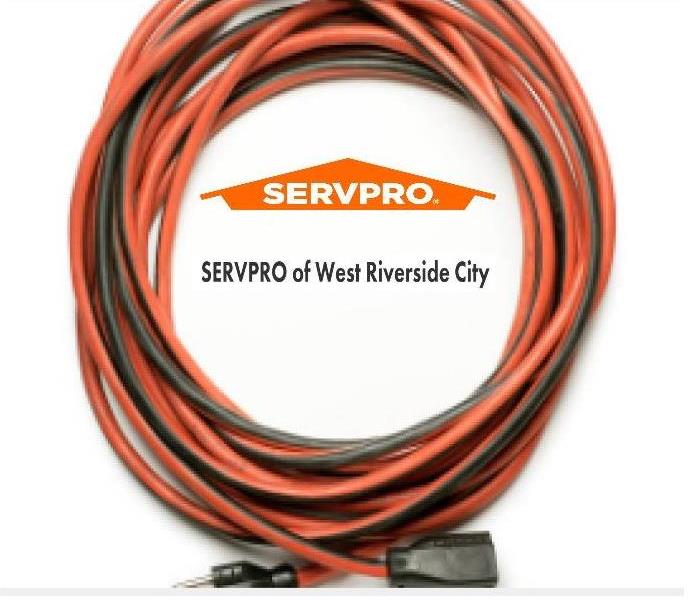 Did you know the extension cord is one of the most abused and misused pieces of equipment on a job?
Did you know the extension cord is one of the most abused and misused pieces of equipment on a job?
One of the most common pieces of equipment used in mitigation work, besides air-movers and dehumidifiers, is an extension cord.
They are the easiest way to provide electrical power to a piece of equipment with a cord too short to reach an outlet. But, did you know the extension cord is one of the most abused and misused pieces of equipment on a job?
Have you looked over some water mitigation teams and noticed extension cords that were plugged into an outlet? Were these cords rolled up, laying on the floor? What if it was a 100 feet of cord? My first thought is—my, that is a trip hazard. Why was such a long extension cord being used for such a short distance?
When a long extension cord is used, this will cause a drop in voltage to the piece of equipment being powered. It will also overload the extension cord. And too, I am sure we have all seen the extension cord that is curled up like an old phone cord. If so, this is a cord that has been overloaded and should be replaced.
By OSHA standards, the maximum length of an extension cord is 100 feet. There are three basic types of extension cords—light-duty, medium-duty and heavy-duty.
Light Duty - 25-feet light-duty cables typically come—18 AWG. 50-foot cords—16 AWG, and 100-foot cords—14 AWG. Most light-duty extension cords do not come with a grounding wire and should not be used on a job site.Medium Duty – 25-feet medium-duty extension cords recommend a16 AWG. A 50-foot cord—14 AWG, and a 100-foot cord—12 AWG.Heavy Duty – 25 ft. heavy-duty extension cords recommend 14 AWG. 50- foot cords —12 AWG and a 100-ft. cord—10 AWG.AWG stands for American Wire Gauge. This is the US standard measure for the diameter of electrical conductors. The higher the AWG number is, the smaller the wire diameter is.
What are some common mistakes made when using extension cords?
Plugging one into the other –The maximum length of an extension cord is 100 ft. by OSHA standards. This doesn’t mean to plug two 50 ft. cords together to reach the distances needed. Use the correct length and AWG needed for the job. Daisy-chaining extension cords could lead to overheating and cause a fire.
Trip Hazards – People can trip over extension cords if not properly placed around the walls. They should be placed out of high foot traffic areas. Never attach extension cords with staples or nails.
Not checking the power rating – If you are dealing with extension cords, you should know the amperage rating of your equipment. Each piece of equipment requires a certain amount of power. The manufacturer describes this along with the amperage rating. Each extension cord can only handle a particular amount of power. Make sure you always match the equipment cord to the same AWG of the extension cord or larger.
Not inspecting – Due to high use and high abuse, extension cords should be visually inspected for damage prior to each use. Look for external defects such as deformed or missing pins, missing grounding pins, loose plug or receptacle ends, broken plug head, uses of duct or electrical tape, damage to outer jacket or insulation, and pinched or crushed outer jacket.
Repairing cords – Any damaged extension cords should be replaced and never repaired. If damaged, remove from service and destroy.
Remember—before setting up your next job, be mindful of the size and how much equipment you are plugging into the extension cord you are using. It’s worth taking the time to properly inspect.
Cleaning Up After a Fire: 5 Things to Throw Away
4/4/2022 (Permalink)
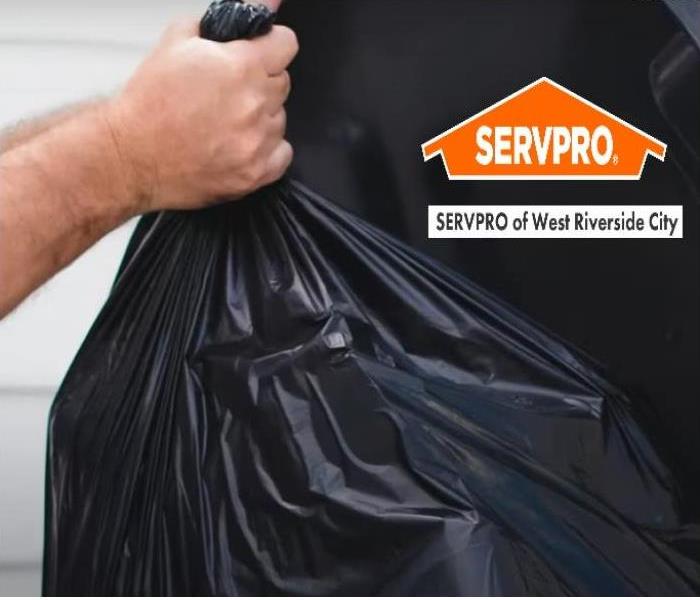 A hard pill to swallow comes when we realize that certain cherished items may have to go away
A hard pill to swallow comes when we realize that certain cherished items may have to go away
We all have a place we call home, where we retire at the end of a hard day's work.
However, the dangers of fires, natural catastrophes and theft remain closer than we may think. When a fire breaks out, the cleaning up process forms a key factor to recovery and healing from the traumatic experience. A hard pill to swallow comes when we realize that certain cherished items may have to go away!
Medication
When a fire razes your home, any medicine present may absorb the high temperature and change the chemical components. The medicine also absorbs the soot and the contents of the fire extinguisher. Ingesting smoke and the contents of the fire extinguisher may expose you and your family to health complications. There are no buts on medications when it comes to choosing what to throw away after a fire.
Food and Other Consumables
The smoke from the fire and fire extinguisher chemicals contaminate any food products. Food products include perishable and non-perishable food products.
Exposure to heat also alters the chemical elements of the food items, including the containers used for storing the food. Cloth packaging, metal tins, cardboard and plastics all change their chemical composition after exposure to high heat levels. Therefore, do not compromise on health at any standard.
Food stored in the freezer may have a slight chance of non-contamination, but it is better to be safe, discard the food. The trauma after a fire coupled with health complications from ingesting contaminated food may weigh down on your recovery process.
Cosmetic Products
The standard while deciding what to throw away after a fire should focus on any products of a chemical nature. Cosmetic products such as make-up, oil products, perfumes and hair extensions have a chemical component. The high-temperature exposure during the fire may alter their chemical composition. Warped casings show that the fire contaminated the products. Fire extinguisher chemicals and soot add another chemical component into the products. Applying any of these contaminated products to your skin may result in an allergic reaction that may add to your woes.
Clothing Material
Any clothes and bedding in the house catch fire. Thus, sort out all the burnt garments and throw them away. Some clothes may have escaped the wrath of the fire but may have soot and fire extinguisher chemicals on their surface. If the clothes belong to children, precaution dictates that you discard them too. However, the use of the appropriate detergents may help to rehabilitate burnt clothes and bedding.
Burnt Electrical Equipment
Electrical equipment within the house has power cords and wiring that may burn during a fire. Electrical equipment that show signs of damage qualifies in the things to throw away after a fire. Compromised electrical equipment could result in another fire due to short circuits. Equipment includes computers, coffee makers, laundry machine, iron box and television sets.
Recovering from the trauma after a fire occurs over some time. The healing process may take time and patience from your side. We at SERVPRO of West Denver understand your pain at this trying time and wish to walk you through the healing process. Let us help you rebuild your new home. We help in the clean-up process and follow up on the tiring process of the insurance claim. To get started, contact us today!
Residents Experience Fire Damage, What To Do While Waiting For Your Contractor
3/3/2022 (Permalink)
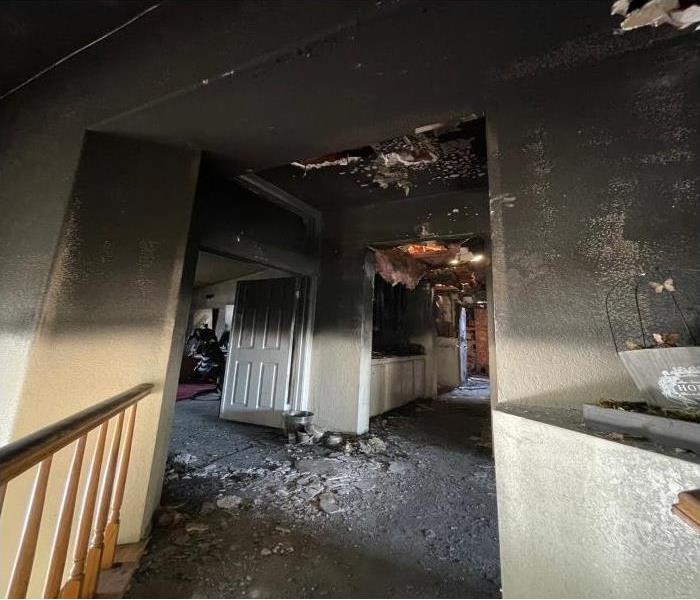 After fire damage, SERVPRO helps Riverside county residents take control and restore their homes
After fire damage, SERVPRO helps Riverside county residents take control and restore their homes
Navigate the restoration process with ease by following SERVPRO’s four tips for preparing for fire restoration services while waiting for your contractor, from addressing safety concerns to minimizing the chance of further damage.
The first step in the fire restoration process should always be calling a trained professional. However, many homeowners find themselves at a loss for what to do after that.
The experts at SERVPRO put together this list of things to do while waiting for a fire restoration contractor to help with that. They also stress that no one should enter the building until it has been cleared for entry by the fire department.
SERVPRO of West Riverside City is a local leader in the fire damage restoration industry. In addition to fire restoration, they offer a wide range of other emergency restoration services, such as water removal and mold remediation.
Fire Damage Restoration Tips: What to Do While Waiting for Your Contractor
#1: Start an Insurance Claim
While the fire restoration contractor will likely help manage the insurance claims process, it helps to notify the applicable insurance company of the fire as soon as possible and open a claim. Likewise, it's vital to take pictures of all the damage before moving anything or beginning any clean-up efforts. Detailed documentation is key to a successful claim.
#2: Air Out the House for Mold and Mildew
Firefighters often use large amounts of water and sometimes even chemicals to put out house fires. A problematic side effect can come in the form of mold and mildew that develops in dark and damp areas. These fungi can compromise the internal strength of the house while also posing potential health effects.
Mold should only be removed by a trained professional due to the risk of exposure to harmful spores. Instead, leave it alone and open the windows to help air out the space. This step may also help with humidity levels.
#3: Only Move Around the House if Necessary
The main concern with initiating cleaning is the possibility of exacerbating any damage. This also holds true for soot which can stick to shoe soles and transfer to other surfaces.
Avoid spreading unnecessary stains and creating more work by limiting movement throughout the space. To this end, it may be prudent to focus on areas further from the damage and leave more significant damage to the fire restoration contractor.
#4: Inspect and Clean Personal Items
Smoke can affect clothing and other personal items in addition to interior surfaces. Avoid loading affected clothing in the washing machine as soot and other small particles can build up and cause clogs. Instead, check the local area for dry cleaners that can handle fire-damaged clothing.
Kitchen items may also require attention if the space is still inhabitable. Try soaking any dishes, utensils, and other kitchen gadgets in water and bleach to remove smoke damage. Do not consume any food or ingredients that were near the fire or suppression efforts, whether it remains intact or not.
About SERVPRO
After fire damage, SERVPRO helps Riverside county residents take control and restore their homes. For more information on fire damage restoration services in the Riverside area, call SERVPRO today at (951)351-8033 for a fast and free quote.
With Chilly Winter Weather, Reduce the Risk of Chimney Fires
2/24/2022 (Permalink)
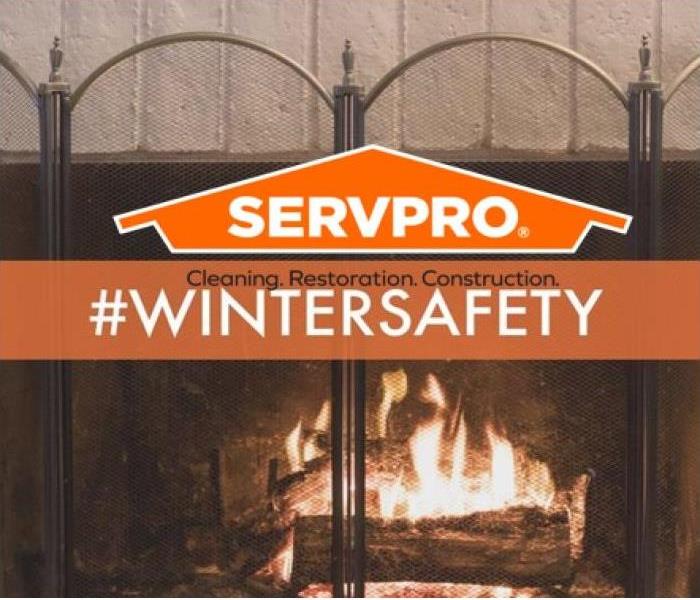 Fire or smoke damage can be an incredibly stressful event, be sure to take the appropriate measures in cleaning and maintaining your fireplace.
Fire or smoke damage can be an incredibly stressful event, be sure to take the appropriate measures in cleaning and maintaining your fireplace.
There is nothing quite like the warmth and glow of a wood burning fire.
Fire is one of humanities oldest tools. It has the power to heat our bodies, cook our foods, refine our metals and light the darkness. We are connected to fire at a primal level and deep down we are all mystified when we see the flames dancing between logs. Nowadays we may be lucky enough to bring that joy inside but the comfort of a cozy indoor fire brings with it, plenty of danger, especially if the fireplace and chimney are not properly inspected and maintained. Here are a few tips to keep your house and family safe from the danger of an indoor fire:
Here are a few tips to keep your house and family safe from the danger of an indoor fire:
- Inspection
According to The National Fire Protection Association, “Chimneys, fireplaces, and vents shall be inspected at least once a year for soundness, freedom from deposits, and correct clearances. Cleaning, maintenance, and repairs shall be done if necessary.” An inspector will come and make sure your fireplace is safe to use and let you know if there are any repairs necessary. If you haven’t used your fireplace in a long time, birds or other creatures may have built nests that could clog your flue or chimney chamber. Winter freeze cycles, inclement weather, and moisture combine to take an annual toll on masonry and liner materials. Year in and year out these elements can cause deterioration that will eventually require attention. Seasonal wear and tear that is left unchecked will affect the performance of your system and the longer the defects go without being addressed, the more expensive the repairs are likely to be. That is why staying on top of your systems is not only the smartest and safest choice but the most cost-effective too. - Chimney cleaning
The best practice is to keep things simple and safe. Make sure to clean the fireplace regularly and know if it’s well built. It is also a good idea to have a professional initially inspect the fireplace and chimney even if you plan to clean and maintain it yourself. The Chimney Safety Institute recommends cleaning the chimney when creosote is 1/4 inch or thicker on the chimney walls or there is visible build up in the system. A chimney sweeping company will take their time to make sure they clean everything and keep your house soot free while doing it. The best time to schedule a cleaning is at the end of the indoor fire season as acids in the creosote, or humidity combined with creosote, can both damage the fireplace mortar. After an initial professional cleaning you should, with the right knowledge, be able to clean and maintain it yourself. Of interest… after cleaning your own fireplace, you could dispose of the ashes and creosote by sprinkling them on flowerbeds. They are a great source of calcium and other nutrients. - Chimney cap
These are a small but important piece of your chimney. Having a chimney cap installed can prevent objects, rain, and snow from falling into your chimney reducing downdrafts which lower the performance of your fireplace. These caps have side vents so smoke escapes and the mesh around the cap sides acts as a spark arrester. Chimney caps also prevent animals and other unwanted guests from making their home in your chimney during the spring and summer months. Another tip is to trim trees back that surrounds the chimney and make sure there is no debris building up on our around it. All in all, even though a chimney cap is a small and generally inexpensive piece of equipment, it can prevent numerous issues from happening. It might also save you thousands of dollars in chimney repairs or damage expense.
SERVPRO of West Riverside City offers these tips from Federal Emergency Management Agency for preventing creosote buildup that can cause chimney fires:
Limited air supply and unseasoned wood encourage the buildup of creosote. To avoid that buildup, do not restrict the air supply by:
- Closing the glass doors
- Not opening the damper wide enough
- The longer the smoke is in the flue, the more likely it is that creosote will form
- By closing down the stove damper or air inlets on a wood stove too soon or too much
- Do not burn unseasoned wood
- In the case of wood stoves, overloading the firebox with wood in an attempt to get a longer burn time also contributes to creosote buildup
Fireplace and Woodstove Safety
- Keep a glass or metal screen in front of the fireplace to prevent embers or sparks from jumping out
- Do not burn paper in your fireplace or woodstove
- Put ashes in a metal container with a lid, outside, at least three feet from your home
- Put the fire out before you go to sleep or leave your home
Experiencing fire or smoke damage can be an incredibly stressful event so be sure to take the appropriate measures in cleaning and maintaining your fireplace and chimney. SERVPRO of West Riverside City specializes in water restoration as well as fire and/or smoke damage and we will do our best to get you and your family back on the couch for a cozy, crackling fire on that cold winter evening.
Call Us!
When Riverside residents and businesses have fire damage, they can trust SERVPRO of West Riverside City to restore the damage, “Like it never even happened.” Call us today at 951-351-8033.
Franchises are independently owned and operated.
Understanding the Temperature of Fire Can Help During a Disaster
12/30/2021 (Permalink)
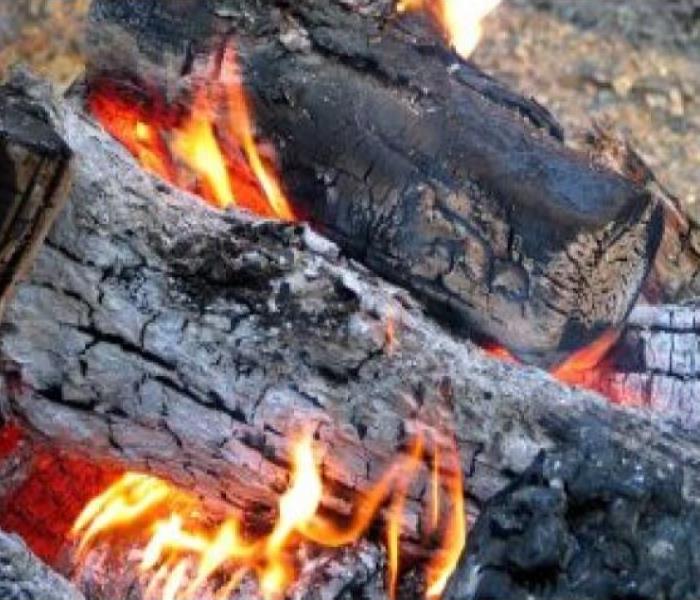 Bonfire – The temperature of a bonfire gradually heats up to around 1112°F, but bonfires can reach 1832-2012°F.
Bonfire – The temperature of a bonfire gradually heats up to around 1112°F, but bonfires can reach 1832-2012°F.
What is the Temperature of Fire?
Fire is versatile and dangerous. No matter what kind of industry you belong to, a working knowledge of the properties of fire is an important part of fire safety. The temperature of fire varies depending on the source and kind of fire you’re dealing with.
Understanding the nuances of fire temperature will inform your overall knowledge of fire and how it works, so in this blog we’re looking at the temperature of fire and how you can identify it.
Temperature and color
The two most distinguishing properties of fire are heat and color. The color of a flame is directly influenced by the temperature, so you should be able to estimate the temperature of a fire by identifying the color of the flames.
Fire is a result of combustion – a chemical reaction between a fuel and oxygen – and when the reaction produces enough heat, flames are formed. Flames themselves change color over time, and will usually have multiple colors in different parts of the flame.
The hottest part of the flame is the base, so this typically burns with a different color to the outer edges or the rest of the flame body. Blue flames are the hottest, followed by white. After that, yellow, orange and red are the common colors you’ll see in most fires.
It’s interesting to note that, despite the common use of blue as a cold color, and red as a hot color – as they are on taps, for instance – it’s the opposite for fire. Red is usually seen on the outer edge of the flame, where the temperature is lower, while blue is the fiercest, hottest temperature.
Fire temperature
From- firefighterinsider.com
Of course, just because there is a hierarchy of temperature for fire, that doesn’t mean that red flames are in any way cold. The fact that you can see flames at all means that the combustion rate is high, so the fuel is burning at a very high temperature.
Red flames, while weaker, can still range from 977°F to 1832°F. The more faint the color, the lower the temperature. A more vibrant red, something closer to orange, will hit the higher end of the scale measuring nearer the 1832°F mark.
Orange flames range from around 2012°F to 2192°F.
White flames are hotter, measuring 2372°F to about 2732°F. The brighter the white, the higher the temperature.
Blue flames, or flames with a blue base, you can expect the temperature to rise dramatically, hitting roughly 4532°F. As you might expect, gas burning fires reach higher temperatures than materials such as wood, paper or textiles, so businesses which store gas tanks such as propane, for example, are most likely to see fires that reach the highest possible temperatures.
Temperature examples
Candle flame – The hottest part of a candle flame burns at around 2552°F, while the average temperature is usually 1832°F.
Wood fire – A household wood fire burns at around 1112°F. Temperature can change depending on the type of wood and its condition.
Bonfire – The temperature of a bonfire gradually heats up to around 1112°F, but bonfires can reach 1832-2012°F.
Burning match – For such a small flame, a household match burns at around 1112-1472°F.
Propane torch – Combustion of propane and air is roughly 3452°F. A butane fire will have a similar temperature.
If you experience a fire in your home or business, SERVPRO of West Riverside City has the knowledge and experience to handle smoke damage from a nearby fire or commercial property containing smoke, soot and water damage. Home or office fires as devastating as they are, we can make it, "Like it never even happened."
Office-951-351-8033
We are open 24/7 to take those emergency calls!
Do You Know What the Top Causes of Fire are in December?
12/20/2021 (Permalink)
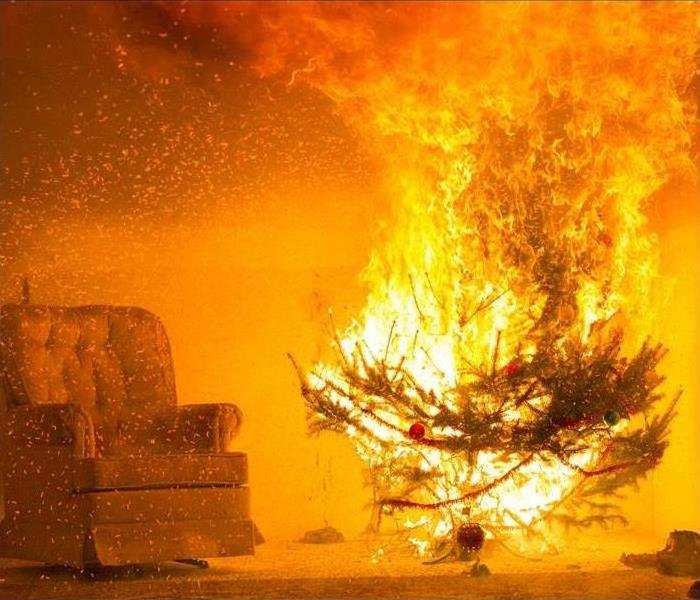 Constant watering keeps trees fresher longer, but the moment the tree appears to drop its needles, it’s a sign that it is drying out.
Constant watering keeps trees fresher longer, but the moment the tree appears to drop its needles, it’s a sign that it is drying out.
Fire damage restoration specialist of SERVPRO of West Riverside City recommend the importance of keeping safety top of mind with a small family gathering as it is with a large holiday party.
Many enjoy bringing the glow of the holiday season to their homes with Christmas trees or menorahs and candlelight, but statistics from the U.S. Fire Administration show how easy it is for home decorating to turn into a home disaster.
Here are are few areas to be watchful of:
- The top three days for home candle fires are Christmas Day, New Year’s Day and New Year’s Eve. More than half of the home decoration fires in December are started by candles.
- A heat source too close to the Christmas tree causes one in every four winter fires. On average, one of every 52 reported home Christmas tree fires resulted in death.
It is also important to follow manufacturers’ guidelines for holiday lighting. According to the National Fire Protection Association, electrical distribution or lighting equipment was involved in 44 percent of home Christmas tree fires.
Only use decorations that are flame-retardant or not flammable, check holiday lights each year for frayed wires or excessive wear and don’t link more than three strands of holiday lights.
- Water your tree daily. Constant watering keeps trees fresher longer, but the moment the tree appears to drop its needles, it’s a sign that it is drying out. From the moment a spark ignites a Christmas tree, it can take only a matter of minutes before noxious smoke and scorching heat fill the entire room, igniting everything within it. Seconds later, the fire can travel up a staircase and perhaps make escape virtually impossible for anyone on the second floor of your home.
For more fire prevention and fire safety tips and information about fire and water damage restoration services, visit SERVPRO of West Riverside City. For more information on SERVPRO of West Riverside City, contact us at 951-351-8033.
Did you know that Christmas Day is the Peak Day for Candle Fires?
12/15/2021 (Permalink)
 While candles are often used for giving off a warm, romantic light and an appealing aroma, they can cause a candle fire if used incorrectly.
While candles are often used for giving off a warm, romantic light and an appealing aroma, they can cause a candle fire if used incorrectly.
Millions of decorative candles are sold every year. They bring a soothing ambiance and different aromas for the rooms in your home.
Are Candles a Fire Hazard?
Candles might seem harmless on the surface until you look at how significant their damages can and have been in U.S. homes. FEMA estimates that there are more than 15.000 home candle fires every year, many resulting in injury for death.
Candle Fire Safety Tips
Here are a few tips to follow to reduce your risk of a fire in your home while your candle is burning:
- Burning candles should never be unattended.
- Candles should never be under shelves or other enclosed spaces.
- Keep candles at least 12 inches from anything that can burn.
- Candles should never be placed where children and pets can knock it over.
- To prevent uneven or rapid burning and excessive dripping avoid drafts, vents or air currents.
- Always put candles on a heat resistant surface.
- Use a suitable candle holder sturdy enough to avoid being easily knocked over.
- NEVER move or touch a candle while it is burning or while the wax is liquefied.
- Make sure that you have a working smoke detector in every room where you burn candles.
- Extinguish candles with a candle snuffer rather than blowing them out, a hot was can splatter.
What To Do if a Fire Starts
If a candle fire ever happens in your home in Riverside, CA, you need to know how to properly extinguish it. When putting out a candle fire, you should never use water, which causes it to spread. If the wax inside the candle catches fire, grab a cover to remove oxygen from the candle. If the flames spread to other parts of your home and get out of control, quickly contact the fire department and evacuate your home. If any fire damage occurs or your home is in need of smoke cleanup services, a fire damage cleanup company can help restore your home back to its original condition.
Candle Alternatives
The best way to prevent candles from causing a fire in your home is to keep them out of your house entirely. There are many candle alternatives to consider including:
- Incense
- Flameless candle
- Essential oil diffuser
- Wax warmer
- Oil warmer
- Stick diffuser
While candles are often used for giving off a warm, romantic light and an appealing aroma, they can cause a candle fire if used incorrectly. It is important to always use candles responsibly or to try out any of the candle alternatives listed in this guide. Visit SERVPRO of West Riverside -Fire Damage for more information on fire loss.
Following a Candle Fire - Fire Restoration
Following these safety tips when you’re enjoying the candle aromas in your home, can lower your risk for a home fire in the future. If candles do happen to cause a home fire and you’re in need of fire restoration solutions, call SERVPRO of West Riverside City at (951)351-8033. Our technicians will be respectful of your home and work with you to put your home back to home sweet home again.
Burned Turkeys Can Happen... Home Damage Doesn't Have To Happen!
11/22/2021 (Permalink)
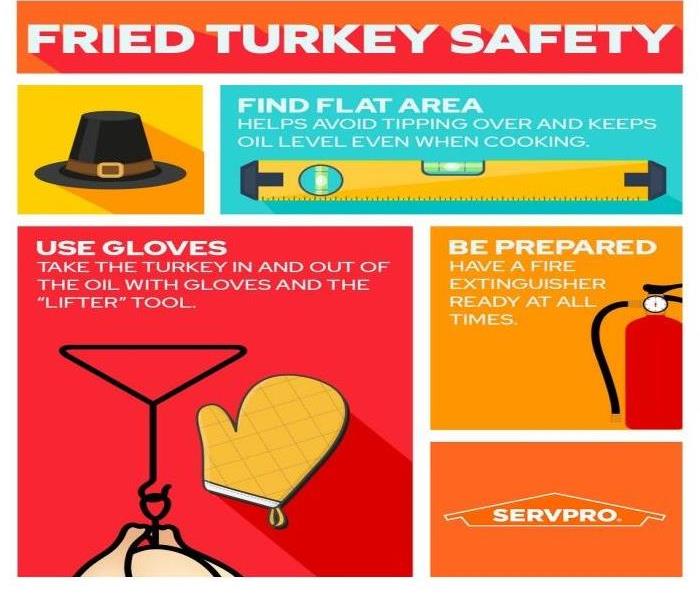 Despite hazards, if you still plan on using a turkey fryer, please follow these safety guidelines.
Despite hazards, if you still plan on using a turkey fryer, please follow these safety guidelines.
November is a month filled with food, family and football, there is also another attribute that may surprise you.
According to the NFPA (National Fire Protection Association), Thanksgiving is the peak day of the year in which home fires occur. The NFPA says that "between 2015 and 2019, cooking was the leading cause of reported home structure fires and civilian fire injuries - as well as the second-leading cause of civilian fire deaths. On Thanksgiving Day in 2019 alone, around 1,400 home cooking fires were reported to U.S. fire departments, which is a 228 percent increase over the daily average."
In order to avoid any potential fire damage or injury, browse these simple guidelines to ensure you have a safe holiday season.
- Stay in the kitchen when you are cooking, even a quick step away can lead to an accident.
- Stay in the home when cooking your turkey and check on it frequently.
- Keep children away from the stove. The stove will be hot, and kids should stay 3 feet away.
- Make sure kids stay away from hot food and liquids. The steam or splash from vegetables, gravy or coffee could cause serious burns.
- Wear protective gear when using indoor fryers.
- Ensure floor and kitchen area is clear of clutter and kiddos, so you don't accidentally trip.
- Keep a lid and fire extinguisher nearby to smother cooking fires.
- Avoid the use of outdoor, gas-fueled turkey fryers, especially indoors or in the garage area.
- Make sure your smoke alarms are working. Test them by pushing the test button.
What about outdoor deep fryers?
The National Fire Protection Association (NFPA) discourages the use of outdoor, gas-fueled turkey fryers, which can lead to devastating burns, destruction of property, and other injuries. Additionally, Underwriters Laboratories (UL), the organization that certifies safe products, does not certify these types of fryers with its UL label. Both organizations discourage the use of open-flame fryers due to the following:
- Turkey fryers tip easily, spilling their contents, and causing oil to ignite.
- Overfilling the fryer is common. The oil spills out of the pot when the turkey is placed in the fryer, engulfing the whole unit in flames.
- With no thermostat controls, the oil is prone to overheating to the combustion point.
- The handles and lid get extremely hot, which can cause severe burns.
- Since the unit is designed for outdoor use, rain or snow can fall on the unit, splattering the oil and converting the water to scalding steam.
Despite these hazards, if you still plan on using a turkey fryer, please follow these safety guidelines:
- Always use the fryer outdoors on a flat surface, safely away from structures, wooden decks, and covered patios. No matter what, DO NOT be tempted to use the fryer in a garage.
- Have the correct kind of fire extinguisher nearby and ready to use.
- To ensure you are using the right amount of oil, place a thawed turkey in the fry pot and add enough water to cover the bird by ½". Remove the turkey and mark the water level. Dump the water and thoroughly dry the pot and turkey. Fill the pot with oil to the marked level.
- Do not leave the fryer unattended. Monitor the temperature of the oil with a thermometer to prevent the oil from overheating and catching fire. If the oil begins to smoke, immediately turn the gas off.
- Ensure the turkey is COMPLETELY THAWED to prevent a fire or explosion hazard.
- Raise and lower the turkey slowly to prevent oil splatter, burns, and fire.
- Keep children and pets away from the fryer to prevent tipping, even after the turkey is done. The oil is dangerously hot for hours.
- Use your safety tools: Oven mitts, gloves, and safety goggles.
- Stand upwind of the propane tank and fryer so heat blows away from you.
In case you're still wondering, Thanksgiving is the peak day for home cooking fires. The day has three times the average number of reported home structure fires involved with cooking equipment. Please be careful this holiday season.
Contact SERVPRO to assist with damage caused by cooking this holiday season.
SERVPRO of West Riverside City
Phone 951-351-8033
We Are in the Midst of Wild Fire Season- Are You Ready?
8/16/2021 (Permalink)
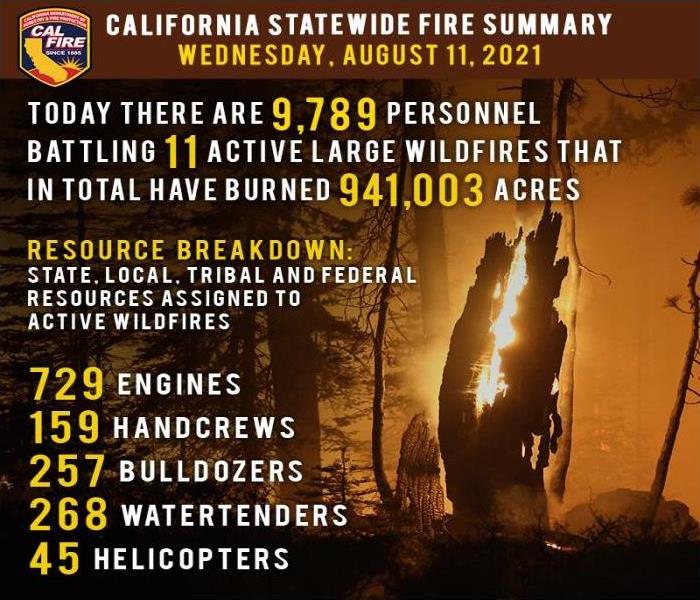 More than 9,700 personnel continue to fight 11 major wildfires/complexes in California.
More than 9,700 personnel continue to fight 11 major wildfires/complexes in California.
More than 9,700 personnel continue to fight 11 major wildfires/complexes in California.
We all have a responsibility to prevent wildfires through proper maintenance and use of campfires, vehicles, outdoor equipment and more.
Recognize Warnings and Alerts
- Have several ways to receive alerts. Download the FEMA app and receive real-time alerts from the National Weather Service for up to five locations nationwide. Sign up for community alerts in your area and be aware of the Emergency Alert System (EAS) and Wireless Emergency Alert (WEA)- which requires no-sign up.
- Sign up for email updates and follow the latest guidelines about coronavirus from the Centers for Disease Control and Prevention (CDC) and your local authorities to prevent the spread of COVID-19.
- Pay attention to air quality alerts.
Make an Emergency Plan
- Make sure everyone in your household knows and understands what to do if you need to quickly evacuate.
Review Important Documents
Strengthen your Home
- Use fire-resistant materials to build, renovate or make repairs.
- Find an outdoor water source with a hose that can reach any area of your property.
- Create a fire-resistant zone that is free of leaves, debris or flammable materials for at least 30 feet from your home.
- Designate a room that can be closed off from outside air. Close all doors and windows. Set up a portable air cleaner to keep indoor pollution levels low when smoky conditions exist.
Know your Evacuation Zone
- You may have to evacuate quickly due to a wildfire. Learn your evacuation routes, practice with household, pets, and identify where you will go.
- If you must evacuate to a public shelter, try to bring items that can help protect you and others in the shelter from COVID-19, such as hand sanitizer, cleaning materials, and two masks per person. Children under 2 years old and people who have trouble breathing should not wear masks.
- Follow the instructions from local authorities. They will provide the latest recommendations based on the threat to your community and appropriate safety measures.
Gather Supplies
- Have enough supplies for your household, include medication, disinfectant supplies, masks, pet supplies in your go bag or car trunk. Being prepared allows you to address smaller medical issues at home, alleviating the burden on urgent care centers and hospitals.
- Being prepared allows you to avoid unnecessary excursions and to address minor medical issues at home, alleviating the burden on urgent care centers and hospitals.
- Remember that not everyone can afford to respond by stocking up on necessities. For those who can afford it, making essential purchases and slowly building up supplies in advance will allow for longer time periods between shopping trips. This helps to protect those who are unable to procure essentials in advance of the pandemic and must shop more frequently. In addition, consider avoiding WIC-labeled products so that those who rely on these products can access them.
- If you already have one at home, set aside a respirator, like an N95 respirator, to keep smoke particles out of the air you breathe. Respirators are not meant to fit children. Due to COVID-19, it may be difficult to find respirators. While cloth masks, surgical masks, and dust masks provide protection from exposure to COVID-19, they will not protect you from smoke inhalation. To ensure that healthcare workers have access to N95 respirators, it is best to limit your exposure to smoke rather than buy respirators.
- Be cautious when carrying flammable or combustible household products that can cause fires or explosions if handled wrong, such as aerosols, cooking oils, rubbing alcohol, and hand sanitizer.
- If you already have an N95 mask, use this to protect yourself from smoke inhalation. N95 masks also protect against the spread of COVID-19, however they should be reserved for healthcare workers. If are in a public cleaner air space or shelter, use a mask to help slow the spread of COVID-19.
- Keep your cell phone charged when wildfires could be in your area. Purchase backup charging devices to power electronics.
3 Steps to Prevent a Lint Fire in your Riverside Home
7/26/2021 (Permalink)
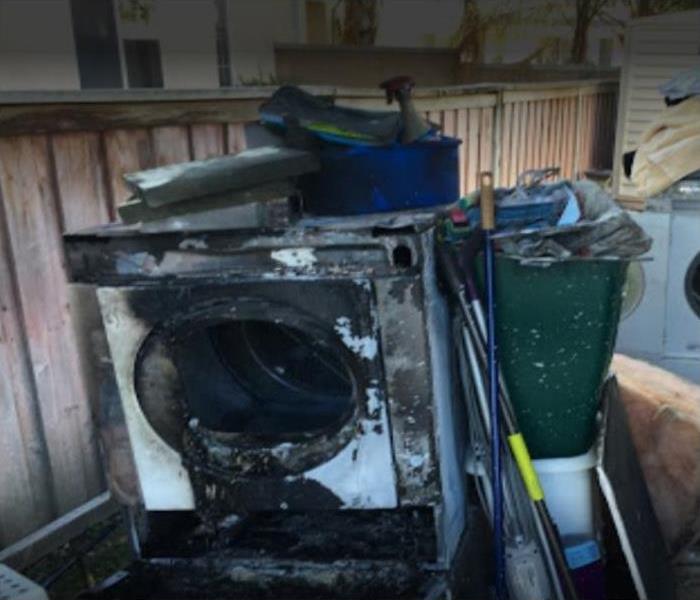 Lint was the cause of this fire. SERVPRO of West Riverside City was there to take care of the smoke, soot, and fire damage!
Lint was the cause of this fire. SERVPRO of West Riverside City was there to take care of the smoke, soot, and fire damage!
Three Steps To Prevent A Dryer Fire
Many homeowners in Riverside, are unaware that lint accumulates poses a dangerous fire hazard. Each time the dryer is used, it releases clothes particles that accumulate inside and around the dryer. When its accumulation is neglected, all it takes is a spark to begin a lint fire. Lint is highly combustible and is made up of:
- Cotton
- Wool
- Synthetic fibers from dryer sheets
Here are three steps you can take to prevent a dryer fire.
- Clean the Dryer Vent and Ensure Proper Ventilation
The hose connection on your dryer leads most of the lint through a pipe to the outside air. When the vent is covered by a mesh screen, the lint will accumulate, forming a combustible blockage. To ensure proper ventilation, make sure the damper is not covered by a mesh screen and that it is opening properly.
- Check Behind the Dryer for Lint
It is easy to miss the lint behind the dryer because of how well hidden it can be. Often, this is a sign that the hose and vent are clogged. Using a vacuum to clean lint behind the dryer could prevent a lint fire. When this begins to happen, it is recommended to hire a professional service to clean your dryer vents.
- Clean the Lint Filter Housing
Along with cleaning the lint filter after each use, clean its housing regularly to prevent lint inside of the dryer. One of the most common causes of dryer fires is lint trapped in the filter housing and the hidden corners of the dryer. Use a small brush and a vacuum cleaner to remove the hidden lint.
You can prevent a house fire by taking precautionary measures with flammable substances. Cleaning your dryer and having it serviced by a professional can keep your house safe from fire damage. If you have experienced a lint fire in your home, call a professional fire damage restoration service to clean and restore your property.
Contact SERVPRO of West Riverside City, we are experienced in these types of fires and can help!
951-351-8033
Follow us on Social Media for tips and updates!
SERVPRO of West Riverside Facebook
SERVPRO of West Riverside Instagram
SERVPRO of West Riverside twitter
Are Fireworks Legal in Riverside?
6/30/2021 (Permalink)
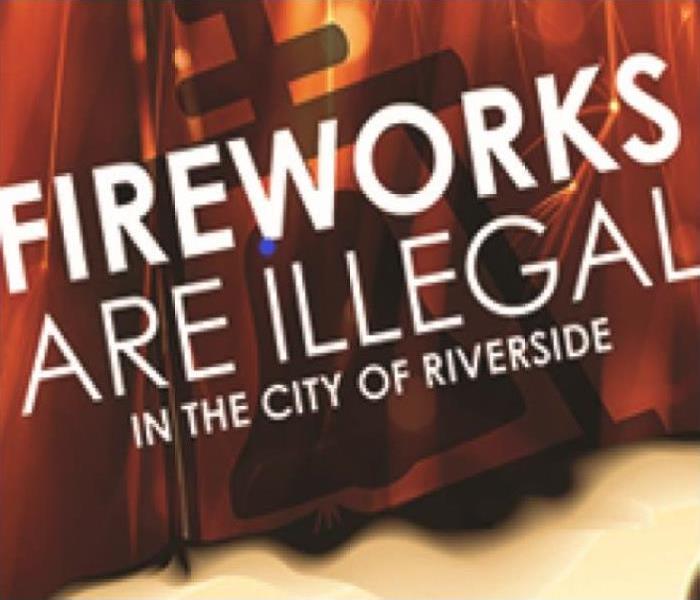 Fireworks cause injuries, spark fires that can endanger firefighters, creates stress for veterans with PTSD, and terrify animals.
Fireworks cause injuries, spark fires that can endanger firefighters, creates stress for veterans with PTSD, and terrify animals.
Every year, about 10,000 people are treated for injuries in hospital emergency departments due to the mishandling of live, misfired and waste consumer fireworks - CPSC 2019 Fireworks Annual Report.
In addition, fires resulting from fireworks cause over $100 million in direct property damage- NFPA. Many U.S. cities are seeing a surge in consumer fireworks usage by the public in 2020.
With the July 4th holiday fast approaching, the City of Riverside is reminding residents that all fireworks are illegal within the city limits, and anyone found using illegal fireworks is subject to a $1,000 fine.
Riverside has been working for several years to reduce the usage of fireworks in the city. Fireworks cause injuries in adults and children, spark fires that can endanger firefighters and the public, create stress for veterans with PTSD, and terrify many animals. Just last year, the City of Riverside confiscated 3,856 pounds of fireworks, wrote 145 citations for fireworks, and received nearly 900 fireworks-related calls.
The City continually promotes an anti-fireworks message in hopes that residents will refrain from purchasing fireworks when they become available in neighboring counties shortly before the holiday. Websites, billboards, electronic parking meters all display the “Fireworks Are Illegal” message, and city officials are monitoring websites for fireworks being offered for sale.
City officials have sent warning letters to people who have received citations and to addresses that were identified as fireworks sites by people who called the City’s 311 line. Calls to 311 regarding specific addresses where fireworks are being used can be made anonymously. RiversideCA.gov
In March 2021, approximately 20 miles from Riverside in the city of Ontario, a massive explosion from a large stash of fireworks took place. Two people and a dog were killed due to the explosion. It injured people and animals and damaged 80 homes.
What can we do to minimize fires and injuries from fireworks?
- The best way to stay safe from fireworks is to not use them. Instead, attend a public fireworks display put on by professionals.
- Fireworks are dangerous to people and pets. Using them puts your property at risk.
- Hand-held sparklers burn at 1,200 F. Remember, wood ignites at 356 F and burns at 575 F.
Riverside county Sheriff's department, City of Riverside, and Riverside county Fire Department all urge:
ALL fireworks, including sparklers, are illegal in Riverside County.
All fireworks are illegal because they cause serious injuries and very often, cause fires.
Those caught with illegal fireworks will be subject to fines, citation and/or arrest; including confiscation of all illegal fireworks. We urge you to leave the fireworks to the professionals!
Preparing Homes and Communities for the 2021 Wildfire Season
5/19/2021 (Permalink)
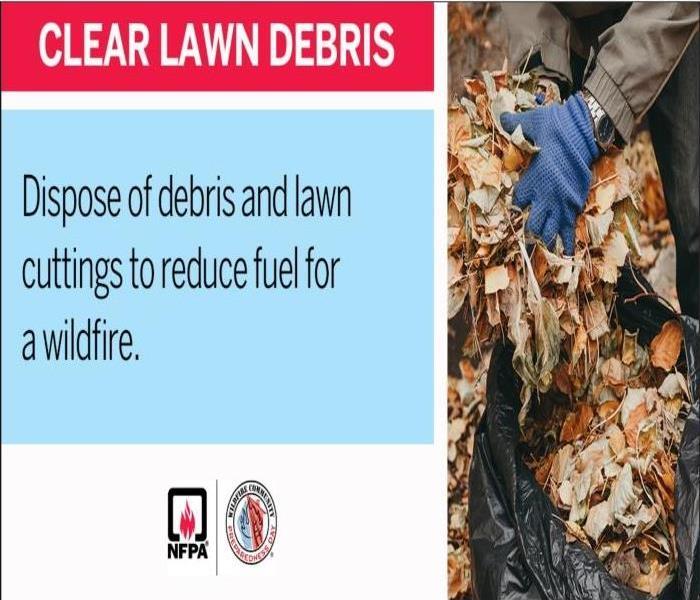 Tip from StateFarm and NFPA: Raking and removing pine needles and dry leaves within a minimum of 3 to 5 feet of a home’s foundation.
Tip from StateFarm and NFPA: Raking and removing pine needles and dry leaves within a minimum of 3 to 5 feet of a home’s foundation.
The National Fire Protection Association (NFPA) and State Farm are helping communities take steps toward safety with Last year, 58,950 wildfires burned over 10.2 million acres of land in the United States, resulting in loss of homes, business, and even lives.
Given that in-person gatherings are limited or on-hold in many places, this year’s Prep Day is focused on what residents can do on and around their home to help protect against the threat of wildfires.
Here are tips from StateFarm and NFPA.
To create defensible space and reduce your risk:
- Raking and removing pine needles and dry leaves within a minimum of 3 to 5 feet of a home’s foundation. As time permits, continue up to a 30-foot distance around the home. Dispose of collected debris in appropriate trash receptacles.
- Cleaning pine needles from roof and gutters and paying attention to maintaining the home ignition zone.
- Getting out your measuring tape and seeing how close wood piles are located to the home. If closer than 30 feet, they need to be relocated and moved at least 30’ away from structures.
- Sweeping porches and decks clearing them of leaves and pine needles. Raking under decks, porches, sheds and play structures.
- Removing items stored under decks and porches and relocating them to a storage shed, garage, or basement. Gasoline cans and portable propane tanks should never be stored indoors and should be located away from the home.
- Posting and sharing Facebook and Twitter messages with tips and best practices with others in your community. (See sample posts from NFPA here.)
State Farm also recommends policyholders:
- Review your insurance policy to make sure you’re covered in the event of a wildfire
- Create a home inventory to assist in the claims process
- Create a disaster preparedness plan that includes your pets and animals
For more resources and information about national Wildfire Community Preparedness Day including videos and tip sheets, visit www.wildfireprepday.org.
Answered: Your Most Burning Questions About Fire Damage in Riverside
4/21/2021 (Permalink)
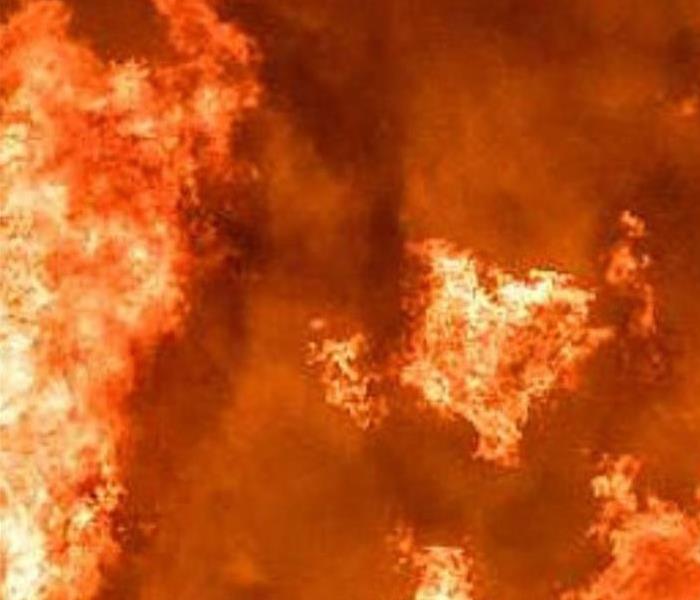 SERVPRO of West Riverside City has the proper training and tools to return a home to preloss condition.
SERVPRO of West Riverside City has the proper training and tools to return a home to preloss condition.
Odor Removal in Your Riverside Home
While there are many lingering effects after a fire loss incident in Riverside homes that property owners can overcome with elbow grease and the right focused cleaning efforts, there are other symptoms that ensure that returning a house to preloss condition is a significant challenge. Odor damages, for example, can spread far beyond an ignition source to affect multiple areas of a home, even rooms otherwise unaffected by the disaster. Reducing or eliminating the presence of these harsh scents often requires a higher grade of cleaning agent and units designed for deodorization in the restoration industry.
When overcoming fire damages in Riverside homes like lingering odors, SERVPRO professionals like ours must utilize multiple pieces of equipment. The best approach for professional deodorization gets determined by the severity of the condition, the affected materials, and the timeline to protect the rest of the household. While there are multiple units and approaches available to our professionals, the most commonly used by our team are:
Hydroxyl Generators These machines utilize both an onboard HEPA filtering system and produce free radicals to break down the molecular structure of foul odors on contact. These units are safe to use around people, pets, and softer materials.
Ozone Machines These units (and the larger chambers at SERVPRO facilities) produce a gas comprised of three oxygen atoms. These irregular compounds bond with odor molecules to neutralize them. This practice is not safe to use around humans and pets.
Thermal Foggers As you might expect from the name, thermal foggers generate heat which vaporizes a compound the fogger can use. In these applications, the fogging solution is a highly effective deodorization agent. This practice is ideal for open areas and softer materials.
Material Removal/CleaningCleaning can help to noticeably reduce the presence of harsh odors in a fire-damaged area of your home. It is always the last resort of our SERVPRO professionals to allow for material removal and later replacement, and this decision only gets made with areas too severely damaged to preserve.
While there are some aspects of fire damage that homeowners can address on their own when first responders leave the scene, symptoms like odors pose a much more challenging obstacle to overcome.
Let our SERVPRO of Riverside team help you make it “Like it never even happened.”
Give us a call at (951) 351-8033.
Does SERVPRO Work with Homeowners Insurance Company After a Fire?
4/21/2021 (Permalink)
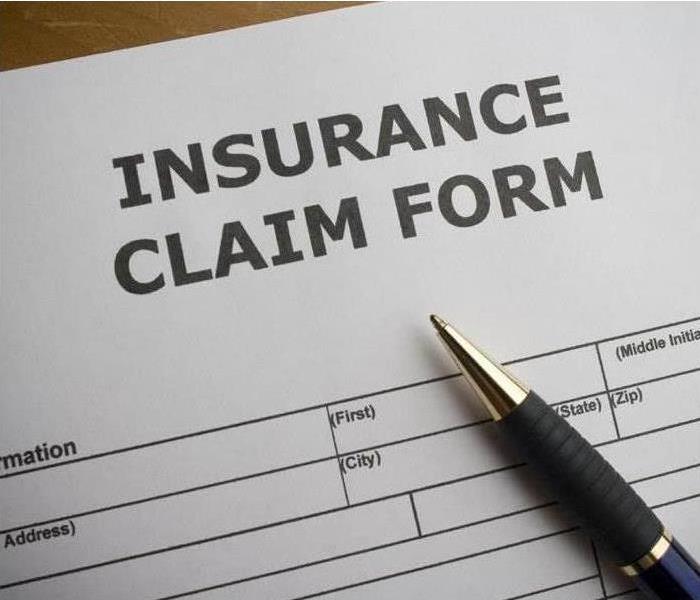 At SERVPRO, our services go beyond fire cleanup in Riverside. What we do is designed to assist all parties involved!
At SERVPRO, our services go beyond fire cleanup in Riverside. What we do is designed to assist all parties involved!
Riverside Homeowners Can Trust SERVPRO to Work Closely with Insurance Companies.
The leading cause of fire-related deaths, injuries, and property loss is residential fires. Most of these homes, thankfully, are covered by homeowner’s insurance. When it comes to assisting Riverside residents with fire claims, a professional restoration company is vital.
How Does SERVPRO Assist Both the Homeowner and the Insurance Company?
Whenever a fire has occurred, the insurance company works with the owners to decide the extent of the loss. This process involves the homeowner, insurance company, insurance adjuster, and the restoration company. In many cases, the insurance company requires a professional company to work with them to ensure that everything gets done professionally. At SERVPRO, our services go beyond fire cleanup in Riverside. What we do is designed to assist all parties involved and includes:
Minimal loss prevention - By providing immediate fire mitigation, more can be salvaged. Prompt action reduces secondary damage and property loss. Scoping information – The details we provide during the initial scope allow the insurance agent to review inspections and reports. He then can prioritize items on the work schedule. Assessing restoration needs – Our technicians help the insurance adjuster and owner decide what gets cleaned and what needs to be declared a loss. Working with adjusters – Our professional teams provide scoping, testing, and loss details that save the insurance adjuster time. Managing the restoration job –When our technicians handle the various aspects of restoration, the insurance company and homeowner do not need to waste time on minor, time-consuming tasks. Restore instead of replace – Our goal is always to restore instead of replacing whenever possible. This saves everyone time and money. Customer satisfaction – we know how a fire can impact your home. If possible, we restore your home to preloss condition.SERVPRO provides an invaluable service by working closely with residents and their insurance companies. As our company works closely with the adjuster, the stress is taken off the homeowner. The agent’s job goes smoother due to the detailed information we provide early in the process. When our Green Team provides fire cleanup services, we are doing more than cleaning – we are helping you get your life back on track.
Contact SERVPRO of West Riverside City at (951) 351-8033 for professional fire cleanup services.
We’re Faster To Any Size Disaster.
Why Should I Agree to a Pack-Out of My Riverside Home After a Fire?
3/31/2021 (Permalink)
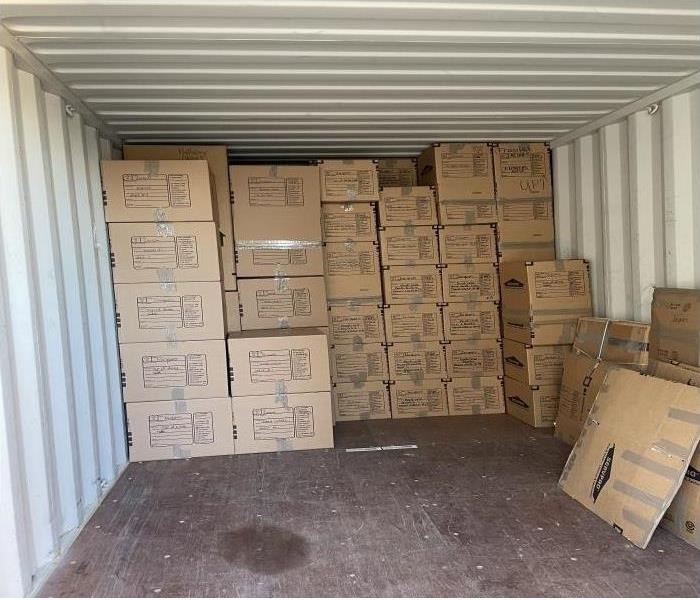 Removal of furniture and personal possessions allows our Technicians to focus on structural components and fixtures damaged by the fire.
Removal of furniture and personal possessions allows our Technicians to focus on structural components and fixtures damaged by the fire.
Professional Pack-Outs Managed by SERVPRO Significantly Improve the Outcomes for Fire Damaged Riverside Residences and the Contents of the Homes
The aftermath of an Riverside household fire is hectic at best and often devastating for you and your family. Understandably, you feel panicked and out of control. When the restoration company you choose suggests a pack-out of most or all of your furnishings, household goods, and personal possessions, you might feel unsure, unwilling to allow what feels like an even more intense disrupting of your life.
What Is the Point of a Pack-Out?
Choosing pursuit of a partial or complete pack-out of the movable property in your fire damaged Riverside home has positive outcomes for both the items moved and the spaces cleared in your dwelling.
How Does a Pack Out Benefit the Items Moved?
The articles packed up and transported away from the fire damaged spaces in Riverside avoid additional harm from firefighting water and soot deposit.Our home contents specialists assess the damage to each item and make recommendations based on our fire damage restoration resources, preventing you from the expense and emotional loss of discarding possessions we safely can bring back to function and appearance. Your possessions are safe and secure in a storage area after restoration. The system we use to track the items allows us to locate and return individual items as you need them.How Does a Pack Out Streamline Mitigation and Remediation Efforts in Your Home?
Removal of furniture and personal possessions allows our Water Damage Restoration Technicians (WRT) and Fire and Smoke Restoration Technicians (FSRT) to focus on structural components and fixtures damaged by the fire.Moving out water and soot damaged items reduces the moisture, residue, and odor load in your home, increasing the effectiveness of the interventions our on-site technicians employ to manage these issues. What Safeguards Are in Place to Account for Packed Out Articles?
Technicians use protective wrap on large pieces and sturdy boxes for loose, smaller articles. We encourage you to identify the things you might need returned as soon as possible after processing rather than when your home is ready to pack back, such as:
Particular types of clothingBooks and paperworkElectronicsTools and equipmentTreasured items, such as a child's favorite toy or blanketWhat Happens During Processing of Fire Damaged Contents?
Every item is considered individually as its needs can vary from other damaged articles. Our employees assess each piece of packed out property to determine:
Characteristics of its materials--solid, permeable, washable, dry cleanable, colorfastnessCondition--previous damage, soil levels, moisture levels, noticeable odorsTypes of soiling--oil-based, water-basedEvidence of mold, mildew, other microbial growthWe choose cleaning products and methods on an individualized basis, using our Institute of Inspection, Cleaning and Restoration Certification (IICRC) training and experience:
Technicians pre-test the efficacy of the selected product and method.If pre-testing indicates the approach chosen is successful, we proceed to clean, dry, disinfect, and deodorize the items.After processing, the items are packed and stored securely, awaiting the completion of on-site fire damage remediation at your home.Does SERVPRO Help with Insurance Claims?
Many insurance companies suggest working with a reliable and reputable fire damage restoration company, and you might select us because of a recommendation from your carrier. The professional assessment our employees complete and updates recorded outline whether chosen interventions succeed in returning contents to preloss condition. This information forms the basis for your claims' coverage. Our documentation supports your requests for restoration compensation or replacement if we cannot restore an item to previous functionality.
Who Takes Responsibility for Reuniting the Processed Contents with My Fire Damage Restored Home?
Our protocol includes a professional pack back of your property when your dwelling is ready. The same care used when we moved items to our production facility makes the move back respectful and comprehensive. We appreciate how stressful the aftermath of a household fire feels and make every effort to streamline the process for you and your family as you return to your restored abode.
The team at SERVPRO of West Riverside City is ready to muster all our resources to transform your home and its contents to "Like it never even happened." Call us at (951) 351-8033 to begin the partnership with our experts that returns normalcy to your life after fire damage.
Limiting Loss For Veterinary Clinics in Riverside
3/24/2021 (Permalink)
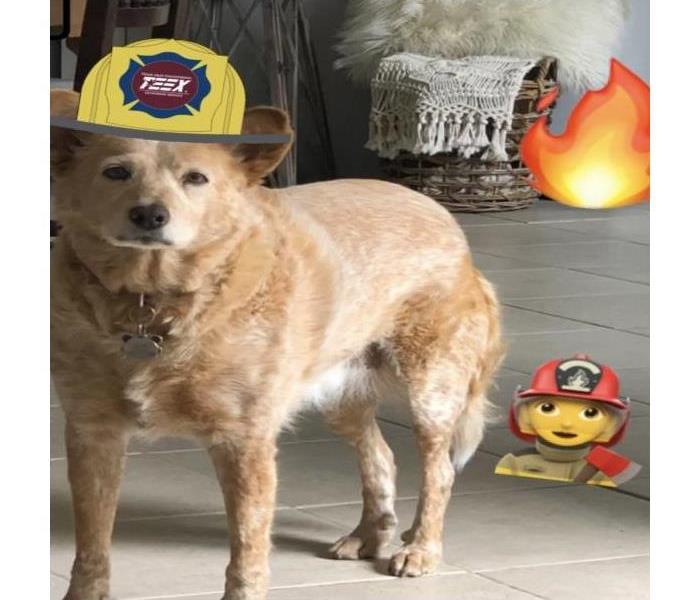 One way to protect your clinic is with a FREE Emergency Response Profile. Contact us 951-351-8033
One way to protect your clinic is with a FREE Emergency Response Profile. Contact us 951-351-8033
Our Trained SERVPRO Technicians Focus on Recovery and Not Just Replacement
Modern small animal clinics feature a growing array of electronic equipment to diagnose and treat their patients. As with other electricity-powered machines, veterinary medical tools have the potential to start fires through improperly wired connections or faulty or overloaded circuits. No matter the cause, SERVPRO restores your animal hospital after a fire.
One of the diagnostic devices catches fire, and commercial fire damage spreads through your Amherst veterinary clinic. Unfortunately for you and your patients, smoldering wiring ends office hours. Your staff stopped the fire quickly with a chemical extinguisher, but a thick and unpleasant smelling smoke moved throughout your facility, including surgical suites and recovery areas. Our highly-qualified technicians know how to clean up the fire residues completely and safely, and restore fresh ventilation so that your business of caring for animals continues.
The SERVPRO crew arrives and ensures the clinic HVAC system halts operation. Our experts inspect the ductwork and arrange for a thorough cleaning, removing as much soot as possible using brushes and powerful vacuums. Areas impossible to clean are sealed using professional products and techniques learned in Institute of Inspection, Cleaning, and Restoration Certification (IICRC) approved courses our workers attend.
Surfaces covered with smoky and chemical extinguisher residues receive treatment appropriate to the characteristics of the coating deposited by the fire. Our crews use a systematic approach, spraying and wiping away the debris or carefully employing abrasive methods when the soot is sticky and difficult to remove. We understand your exam and treatment rooms must be sanitized, and your boarding kennels, offices, and lobby spaces require a restoration to preloss condition.
SERVPRO deodorization experts use one or more strategies to eliminate smoky smells. Animals are sensitive to the disturbing aroma left after a fire, necessitating comprehensive deodorization. We recommend removal of the damaged equipment wiring as a first step and then use airborne deodorants. Thermal fogging, a procedure that requires a certified technician to complete, replicates the way the odors first pervaded and neutralizes them.
The medications and foods your office stocked before the fire are likely to be compromised by the smoke damage. We work with your insurer to make hard decisions about the supplies and treatments to be discarded. Our pledge is to have you back to caring for the community’s pet population swiftly.
SERVPRO of West Riverside City helps you sort out the challenges an equipment fire poses for your veterinary practice. Call us at (951) 351-8033 as soon as your clinic is cleared by local authorities for fire restoration works.
Riverside Fire Safety with your Children
12/23/2020 (Permalink)
 Create an escape route by mapping out your home on paper. It’s important to know and understand all the possible points of escape.
Create an escape route by mapping out your home on paper. It’s important to know and understand all the possible points of escape.
Most schools teach children about fire safety but have you had the opportunity to discuss the ins and outs with your child about your own fire safety plan in your home?
It’s one of the most important discussions we should have and often do not have with our children. It’s actually a conversation that needs to be discussed multiple times, I would recommend once a month. It can be overwhelming and quite frankly a little scary for our children. If you have babies, it's important for you and your partner to have a plan for a child who is immobile. I have put together a few starter points to have with your family to help keep them safe in case of an emergency. Our goal here at SERVPRO is to help you in times of need. We want your family to be whole and happy.
Create an escape route by mapping out your home on paper. It’s important to know and understand all the possible points of escape.Have a plan to meet in a specific spot outside the home if your child needs to escape separately from you. If a neighbor or friend's home is close by, I recommend using their property. Again, be sure to use a meeting spot that is close without having to cross a street. Your child may be disoriented or confused from all the smoke and not able to cross a street safely.Outline the Stop Drop and Roll procedure. This is taught in schools but it’s important to reiterate this information in relation to your home.Review general Do’s and Don’ts of fire safety. This would include information like having them touch a doorknob to see if it is warm or hot, if so, they should seek escape through a window or know how to call 911. Be sure they are aware of their address and how to explain where their room is to someone from the outside, i.e., “my bedroom window is on the second floor on the west side of the house”. If your child is too small to be able to escape on their own, it’s a good idea to teach them to go to a certain corner of their room, tell them not to hide, and stay close to the floor. This will help if you or a firefighter find them easily to rescue them. Discuss the importance of smoke alarms and carbon monoxide alarms. Have your children help you test them. It’s important for your child to hear them and know what to expect. If your child has never heard the alarm, it’s difficult for them to comprehend what is happening if an emergency were to arise at night or when you may not be by their side.Reassure your child. Family support and emotional support are incredibly important. Having a regular meeting (once per month) will help your child gain confidence in what he or she may need to do to protect themselves. It is a scary situation but being well informed will help you all find safety. At the end of the day, SERVPRO of West Riverside City is Here to Help in any disaster. We are your fire and water restoration company. We will bring our decades of experience to you and your home and make it "Like it never even happened."
As always, if disaster strikes, SERVPRO of West Riverside City can be reached 24/7 at 951-351-8033.
7 CHRISTMAS TREE SAFETY TIPS TO KEEP YOUR FAMILY SAFE
12/2/2020 (Permalink)
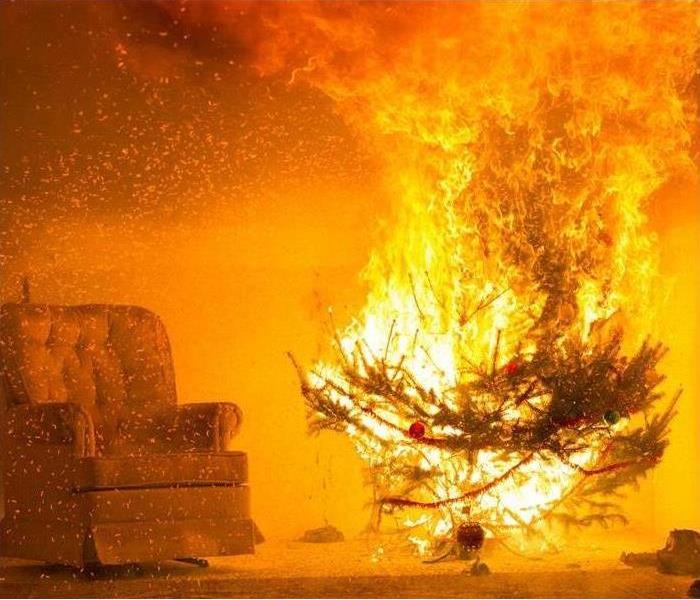 Avoid a dangerous situation with your Christmas tree by following 7 key steps!
Avoid a dangerous situation with your Christmas tree by following 7 key steps!
For a wonderful while, it’s the most beautiful decoration in your home it may be tall, short, slender or plump, the Christmas tree stands at the center of holiday celebrations. It also stands as a seasonal addition to the house that needs to be treated with special care.
As you make plans to bring home this year’s fir or spruce, are you checking your Christmas tree fire safety list?
We offer this guide for keeping your Christmas tree safe based on our years of experience as Riverside's most trusted fire cleanup company. We want you to celebrate the season with the security that comes from knowing your home is safe for the holidays.
According to the National Fire Prevention Association, Christmas tree fires cause property damage totaling more than $14 million annually. That figure can’t account for the heartbreak of a house fire over the holidays. These seven simple tips can keep your home and family safe while you all enjoy the Christmas tree’s bright lights and warm glow.
1. CHECK FOR FRESHNESS
Look for a tree with soft, green needles, and confirm its freshness by closing your hand over a bough and gently pulling down. If needles fall off at your touch, the tree is already beginning to dry out, and that can pose a fire hazard.
2. GIVE IT A STABLE STAND
Safely show off your Christmas tree in a sturdy, weighted stand with screw-in stabilizers that help anchor its weight. A large stand also holds plenty of water for keeping a thirsty tree fresh inside your home.
3. STAND IT AWAY FROM HEAT
Make sure the tree is standing at least 3 feet away from any heat source including space heaters, radiators and the family fireplace. High temperatures, flames and embers are serious fire hazards around a Christmas tree.
4. WATCH THE KIDS
A beautiful tree can tempt little hands with pretty ornaments and inspire rowdy playtime around its base. Talk to the kids about home fire safety. Explain that running around close to the tree can topple it and start a fire.
5. WATCH PETS TOO
The family dog and cat can create Christmas tree fire hazards too. Discourage dangerous chewing and tangling accidents by hanging tree light strands and decorations above your pets’ playful reach.
6. TURN EVERYTHING OFF
Always unplug tree lights before you leave the house or go to bed for the night. Turn off nearby space heaters, extinguish candles, and make sure embers are out in the fireplace.
7. GIVE IT AN HONORABLE GOODBYE
When a Christmas tree stops taking up water and starts dropping needles, it becomes more of a fire hazard with each passing day. Give the tree an honorable goodbye at one of the recycling centers across Riverside.
HOW TO KEEP A CHRISTMAS TREE FROM DRYING OUT
This part of Christmas tree fire safety deserves special attention because it keeps your tree fresher through the holidays, and that reduces the risk of a house fire. Good tree maintenance starts before you set it up in its stand.
- Saw 2 inches off the bottom of the tree stump, but don’t peel back lower bark or drill holes in the trunk. • If you can’t put the tree in its stand right away, prop it up in a large water bucket, and check it daily. • Monitor the tree’s water level every couple of hours on the first day. Afterwards, top it off every 24 hours.
CAN CHRISTMAS LIGHTS CAUSE A FIRE?
We’re often asked about decorations this time of year, so we finish up our Christmas fire safety guide with important pointers about lights on the tree.
- Always purchase Christmas tree lights that carry the Underwriters Laboratory UL Seal. • Inspect strands for frayed wires and broken sockets, and toss anything that looks damaged. • Don’t overload the tree with older incandescent lights or run too many strands from one extension cord. • Don’t connect incandescent and LED strands together, and keep them on separate extension cords.
WE’RE ALWAYS HERE FOR YOU
This year, gather the family around for a quick review of Christmas tree safety strategies. Make sure everybody understands how important it is to follow the guidelines.
All of us here at SERVPRO of West Riverside City send our warmest wishes to you and your family. It’s our honor to serve and be a part of this wonderful community, and we really value your support. Our teams are always here for you, with the best fire damage cleanup and fire restoration services available.
Receiving an Emergency Alert to Evacuate Your Home, What Do You Take?
11/23/2020 (Permalink)
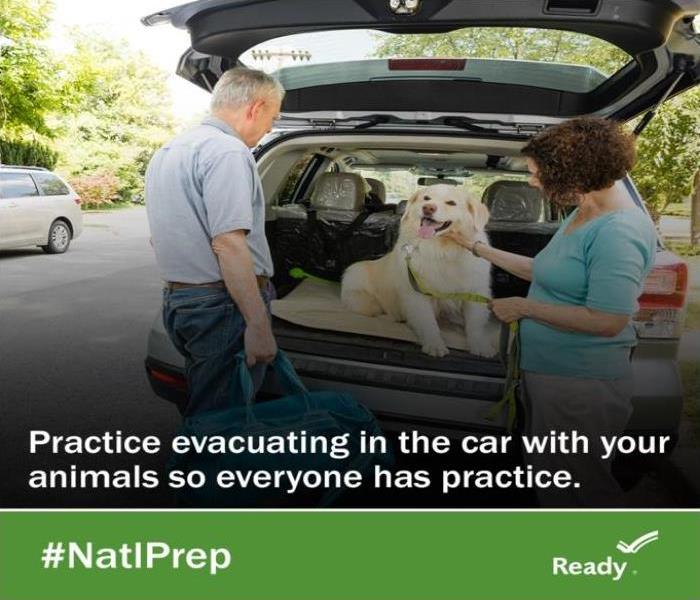 Grab the dog and put them into the car. If you plan to take your pets right before you leave, they might hide or struggle, slowing down your escape.
Grab the dog and put them into the car. If you plan to take your pets right before you leave, they might hide or struggle, slowing down your escape.
It's the end of October as I write this blog. My week started with an emergency alert on my device Monday late afternoon. It read, "Per San Bernardino County Sheriff Dept. - Fire in the Chino Hills State Park. Evacuation Warning in effect...
Potential threat to life and/or property…". Needless to say, my heart sank, and a bit of a rush and panic came over me. I gathered my thoughts and since I already had a to-go-bag packed, I felt a little bit at ease. My son and I had previously created an emergency evacuation plan of what to take, who to contact, and where to go. We used Ready.gov's printable card and had those already in our wallet containing important information. We reviewed our plan and confirmed what each of us were responsible for collecting. We kept everything ready to go by the front door, both cars ready to pull forward with full tank of gas! We went to bed feeling confident we were ready…until we received Emergency Evacuation Alert level 2. This one, received at 1am in the morning read, " Due to wildfire burning near LA, Orange, and San Bernardino County borders, an EVACUATION WARNING has been issued in the area south of Diamond Bar. Those in the area should Get Set for a potential evacuation by gathering loved ones supplies. Monitor local news, our social media channels and LA County.gov." I jumped up in a panic, made sure my son was aware of the alert and reviewed updates of the fire.
How did we know what to plan for or what to take? Ready.gov was the best tool. Below are the steps we took, and the plan we created based on our families needs.
Step 1: Put a plan together by discussing the questions below with your family, friends or household to start your emergency plan.
- How will I receive emergency alerts and warnings?
- What is my shelter plan?
- What is my evacuation route?
- What is my family/household communication plan?
- Do I need to update my emergency preparedness kit?
- Check with the Centers for Disease Control (CDC) and update my emergency plans due to Coronavirus.
- Get masks (for everyone over 2 years old), disinfectants, and check my sheltering plan.
Step 2: Consider specific needs in your household.
As you prepare your plan tailor your plans and supplies to your specific daily living needs and responsibilities. Discuss your needs and responsibilities and how people in the network can assist each other with communication, care of children, business, pets or specific needs like operating medical equipment. Create your own personal network for specific areas where you need assistance. Keep in mind some these factors when developing your plan:
- Different ages of members within your household
- Responsibilities for assisting others
- Locations frequented
- Dietary needs
- Medical needs including prescriptions and equipment
- Disabilities or access and functional needs including devices and equipment
- Languages spoken
- Cultural and religious considerations
- Pets or service animals
- Households with school-aged children
Step 3: Fill out a Family Emergency Plan
Download and fill out a family emergency plan or use it as a guide to create your own.
Step 4: Practice your plan with your family/household
Associated Content
This was also great article that I followed to some degree:
From these experiences, I’ve learned:
If you don’t have a mental list already thought out, in an emergency you may forget what’s important and grab stuff that’s not useful or is easily replaced.
The more you mentally rehearse the actions you’d take in a crisis, the more likely you’ll follow your plan in an actual emergency.
My emergency list begins with:
- Grab the dog and put them into the car. (If you plan to take your pets right before you leave, they might hide or struggle, slowing down your escape. If you’re not leaving soon, keep them in the bathroom nearest the door.)
- My purse. (It’s big and can hold a lot of stuff.)
- My laptop. (Fits in my purse.)
- My to-go bag containing clothes and toiletries. (I always keep one packed and ready.)
I have included more on my list, these were the first five items.
Every time there’s a fire in California, practice running through a scenario where you have to grab what’s on your list and race out the door.
You can also make a physical list — on paper or a digital one on your phone or tablet for easy access and mobility. Make a copy for each member of the family, designating which items they are in charge of.
PREPARE FOR AN EMERGENCY BEFORE THERE’S A CRISIS
In California, we’re supposed to have earthquake supplies on hand in case our state experiences “the big one.” I also started keeping an emergency stash in the trunk of my car. If you open my trunk, you’ll find:
Copies of important paperwork.
Pet food, dog leash, other pet supplies,
A pair of tennis shoes and sweats, as well as a change of clothing and shoes for work.
Basic toiletries.
First Aid Kit.
Flashlight.
Radio.
Snacks and water.
Blanket, towel, and small pillow.
A roll of toilet paper.
Extra laptop charger. (An extra phone charger stays in my purse.)
It’s important to keep visual documentation of your home and valuables for insurance purposes. Video your whole house and also open drawers and closets. Keep this record updated. Make sure you store a copy on a cloud service and multiple memory cards/external drives.
WHEN IN EVACUATION LEVEL TWO, DON’T DELAY PREPARING
At the second level of an evacuation request, there’s a good probability of the need to evacuate. Level three is an evacuation request — be ready to leave at a moment’s notice. Level four is immediate evacuation.
Load the car or cars and position them in the driveway headed out. Make sure the gas tank is full. If you never have to leave, then all you’ll have to do is unload the car and unpack. Yes, it’s a tedious job. But better than having to grab and go.
Stay informed through media about the progress of the fire and where to find safe evacuation routes. Watch for emergency personnel who may come by your home or be at certain checkpoints to give instructions regarding the evacuation.
Consider leaving at evacuation level two to avoid congested roads.
THINK OF PACKING IN TWO BATCHES
The first batch will cover the time you’ll stay at a shelter/hotel/with friends and relatives. The second batch is to pack as if you won’t have a home to return to.
BATCH ONE
Addresses staying in shelters. See her article for details. You can adapt the information to staying in hotels or with friends/family.)
BATCH TWO — PACKING AS IF YOU WON’T RETURN
Take important stuff you can’t live without, treasure, or will need.
Computers. (If you have a desktop, store information on a cloud or download what you need on flash drives.)
Valuables.
Jewelry.
Special photos.
Sentimental items.
Clothes for longer term, such as for work or winter coats.
Bring additional paperwork:
Legal documents — birth certificates, passport, social security cards, will, vehicle registration and ownership papers, marriage/divorce papers.
Financial records — bank account information, credit and debit cards, government benefits, retirement and investment account statements, tax returns, year-to-date receipts if you itemize expenses on your tax returns.
I encourage all households to sit together and create a plan. Check out Ready.gov and the referenced article. These are great tools to help you prepare your loved ones and ensure you have necessities and valuables in the event of an emergency.
Be safe California residents!!
Holiday Cooking Fire Safety Tips for Riverside Residents
11/9/2020 (Permalink)
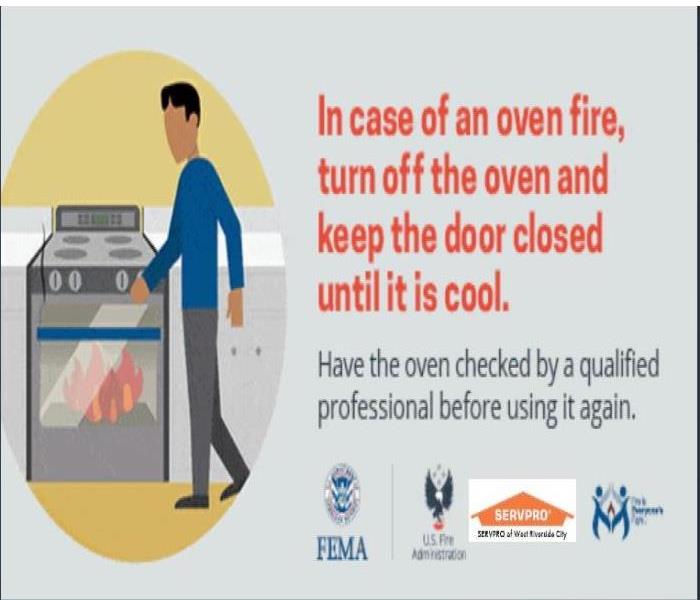 If an oven fire occurs, turn off the heat and keep the door closed.
If an oven fire occurs, turn off the heat and keep the door closed.
November is known for making a turkey feast, where family you haven’t seen in a while, gather and eat.
Although it’s a joyous and happy time, Thanksgiving is one of the worst days of the year for home fires. According to the National Fire Protection Association (USFA), the number of cooking fires on Thanksgiving day is three times as high than any other day of the year.
Stovetops and Ovens
Sometimes cooks can be distracted by their guests, cooking fires can easily be prevented by following a few simple precautions:
Remove food and grease buildup from burners, stovetop, and oven. Always start cooking with a clean stove and oven.Always stay in the kitchen while you’re cooking, don’t get distracted by trying to entertain your guests.Stay inside while cooking a turkey, set a timer, and check on it often.Keep a flame-resistant oven mitt, potholder, or lid nearby to smother any flames.Keep children away from the stove. It is recommended to use the back burners.If an oven fire occurs, turn off the heat and keep the door closed.Turkey Fryers
Never use a turkey fryer on a covered patio, garage, or indoors because it’s a fire hazard risk. Fryers can easily tip over, spilling scalding, hot oil onto anyone nearby, leading to fires, burns, or other serious injuries. Never overfill the oil in a fryer, many turkey fires happen while the oil is being heated. Here are some safety tips for using a turkey fryer:
Always read and follow the manufacturers guidelines.Completely thaw the turkey.Neve leave the fryer unattended.The oil will remain dangerously hot for hours, so keep children and pets away from the fryer.Only use the oil that is recommended. Different types of oil have different ignition temperatures.Allow two feet of space between the liquid propane tank and the fryer burner.Use well-insulated potholders or oven mitts, wear safety goggles to protect eyes from oil splatter.If oil starts smoking, immediately turn off the gas supply.Keep a fire extinguisher nearby.Never use water to extinguish a fire.Each year, from 2016 to 2018, fire departments in the United States responded to an estimated average of
189,300 cooking fires in residential buildings.
These fires caused an estimated:
170 Deaths
3,300 Injuries
$443 million in property loss
Cooking was, by far, the leading cause of all residential building fires and injuries.
Remember these safety tips so you and your family can have a safe and wonderful time together.
SERVPRO of West Riverside City is always ready for any emergency.
Keep our number handy:
951-351-8033
Steps to prevent Candle Fires in your Riverside Home
11/4/2020 (Permalink)
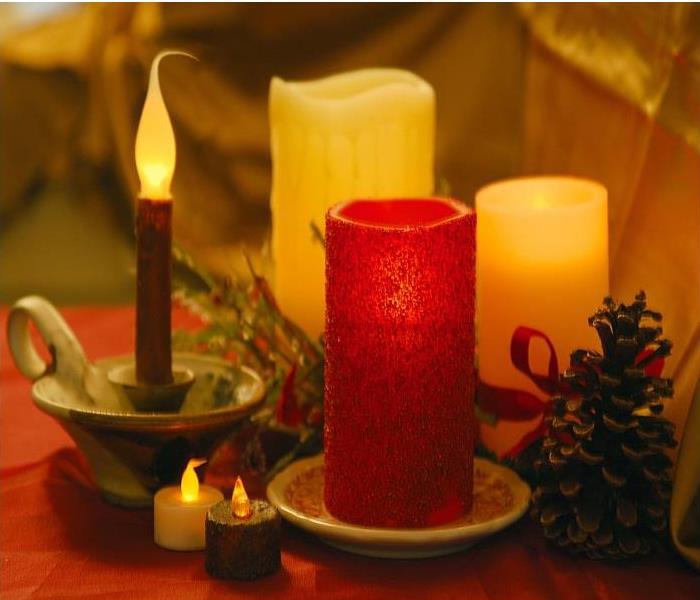 Think about using flameless candles in your home. They look and smell like real candles.
Think about using flameless candles in your home. They look and smell like real candles.
There is something calming about candles especially during the holiday season. They look pretty and enhance the ambiance in a room, they give off a fragrant smell that can be so luring, but they can also be the cause to a house fire.
December has been noted as the peak month of candle fires. According to the National Fire Protection Association, 3 out of every 5 candle fires started when they were placed near something that can burn, such as furniture, bedding, or decorations.
From 2014-2018, U.S. fire departments responded to an estimated 7,610 home structure fires that were started by candles per year. These fires caused an annual average of 81 deaths, 677 injuries and $278 million in direct property damage. NFPA Home Candle Fires Report
Review the tips below from NFPA to prevent house fires this holiday season:
DO pay attention to proximity. It’s important to make sure that you’re not burning a candle on or near anything that could catch fire. Keep candles at least 12 inches away from furniture, drapes, bedding, carpets, books, or any other flammable objects. Place burning candles at least 3 inches apart from one another so they don’t melt one another or burn improperly.
DON’T leave burning candles unattended. Try to restrict people and candles to one room in the house so the location of family members can always be accounted for and you can keep an eye on open flames. Extinguish all candles before going to bed or leaving a room.
DO place candles on a fire-resistant surface. Place a handle in its holder on a stable, nonflammable surface, such as a metal cookie sheet, frying pan or ceramic plate.
DON’T light a candle if you smell gas. If you smell gas inside or outside your home, immediately put out all open flames, shut off your gas supply, leave the area, get to a safe place, and call 911.
DO use pillar or container candles. Broader-based candles are a suitable option for power outages, as these are less likely to be accidentally knocked over. When possible, candles should be enclosed within glass hurricane holders or globes.
DON’T use candles as a search guide or night light. Avoid walking around with a candle. Dark rooms can increase the chance of tripping or brushing against a flammable item. Use a flashlight instead.
DO keep candles out of reach of children and pets. Place candles up high to avoid the risk of pets, children, or adults accidentally bumping candles over in the dark.
DO Light candles carefully. Keep your hair and any loose clothing away from the flame
DON'T let the candle burn all the way to the bottom; put it out before it gets too close to the container or holder
DON'T light a candle if oxygen is used in the home. Oxygen canisters should be kept at least five to 10 feet away from any open flame, which can be anything from a fire in a fireplace to a gas or a candle.
DO use a flashlight or battery-operated lighting instead of a candle during a power outage.
Candles and Kids
Think about using flameless candles in your home. They look and smell like real candles.
- Never leave a child alone in a room with a burning candle.
- Keep matches and lighters up high and out of children’s reach, in a locked cabinet.
Although candles can add to the décor in the room, however, they can also add danger. Remember candles are an open flame which means they can easily ignite. Create an environment that is safe for you during this holiday season, use alternatives to prevent any candle fires in homes like using flameless candles.
Here are some additional tips to prevent fires during the holiday season from Ready.Gov:
- Only use decorations that are flame-retardant or not flammable.
- Check holiday lights each year for frayed wires or excessive wear.
- Don’t link more than three strands of holiday lights.
- Never leave a burning candle unattended. Consider using battery-operated flameless candles.
- Keep your live Christmas tree away from heat sources and room exits.
- Water your live Christmas tree daily to keep it from becoming dry.
As always, remember SERVPRO of West Riverside City is here to help!
Follow us on Social Media for additional tips:
Facebook
Instagram
Twitter
What Is Considered Smoke Damage? A Simple List of the 5 Pesky Types
10/27/2020 (Permalink)
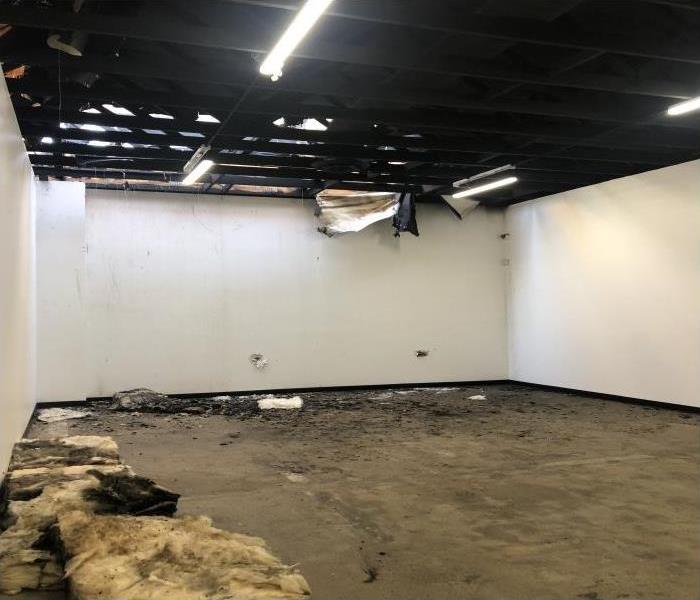 Riverside commercial building sustained smoke damage from a next door fire. SERVPRO of West Riverside was there to help!
Riverside commercial building sustained smoke damage from a next door fire. SERVPRO of West Riverside was there to help!
SERVPRO smoke damage repair specialists help homeowners identify what to include in their fire damage claim
Cleaning smoke damage is an extensive process. Depending on the size of the fire damage, cleanup can take days to months to perform. Worst-case scenarios require removing and replacing damaged drywall to make it “Like it never even happened.”
If your home has recently suffered from a fire loss, you may wonder what is considered smoke damage for insurance purposes.
Insurance companies have a strict set of protocols and documentation they require to qualify for coverage. This article will go into detail about the different types so you can know what to expect!
Smoke damage inspections.
After a fire occurs in your home, the first step is to contact a certified fire damage restoration professional, like SERVPRO. The following inspection will gauge the extent of the smoke damage.
During this inspection, the fire damage professional will determine which type of smoke damage has affected your home. There can be different types within different areas, depending on the nature of the fire damage.
SERVPRO bases our cleaning procedures based on the information identified during the soot and smoke damage testing.
The 5 types of smoke damage
Five types of smoke damage can affect your walls and ceilings after a home fire–SERVPRO smoke damage repair crews offer services to clean the following type of residues:
- Wet smoke residues. Wet smoke residues result from smoldering fires with low heat. This type has residues that are incredibly sticky, smeary, and possess pungent odors. This type of residue is the most common type of smoke damage that occurs in Dayton home fires.
- Dry smoke residues. Dry smoke residues come from scorching fires. This type of smoke residue is often dry, powdery, and small.
- Protein residues. Protein residues are notorious for discoloring the paint and wallpaper on your walls. Protein residues leave an extremely pungent odor. During the SERVPRO smoke damage cleaning, the professional will install an air purifier to deal with the resultant smell from this type of smoke.
- Fuel oil soot. The best example of fuel oil soot is a furnace puff back. This type of smoke damage takes the form of thick black smoke filled with particles–these particles are the soot.
- Smoke webs. Smoke webs are residues from plastics and other synthetic materials. They form long chains of ionized smoke particles that stick to the walls and ceilings of your home.
Before starting the smoke damage cleanup and restoration process, the homeowner must stop the soot from spreading through the centralized air system. To complete this crucial step, shut off the air conditioning or heating and open all doors and windows to allow fresh air to enter. This action ensures that smoke and soot particles aren’t throughout the rest of the house.
Smoke damage cleanup tips.
The smoke damage cleaning process begins after the inspection and initial assessment. A trained professional will dust and vacuum any loose soot and smoke particles that have been created by the house fire.
Next, the professional will use a dry-cleaning sponge (chemical sponge) for any walls and other hard surfaces. The chemicals within the sponge remove the smoke and soot stains.
Water and any other liquid chemicals will spread the soot, making the affected area more extensive and, therefore, the cleanup more difficult. For this reason, we never use water or any soot cleaner before using the specialized sponge.
Smoke damage cleaning products.
The smoke damage repair process begins with an inspection by fire damage restoration professionals. During this, they will evaluate the type of smoke your particular fire created, what kind of damage is present, and the materials damaged during the event.
The smoke damage type will determine what kind of cleaning products are required. Our arsenal contains industrial-grade products to clean every type of smoke damage–from the basic to the most severe.
National Fire Prevention Week- Helpful Tips for Riverside Residents
10/5/2020 (Permalink)
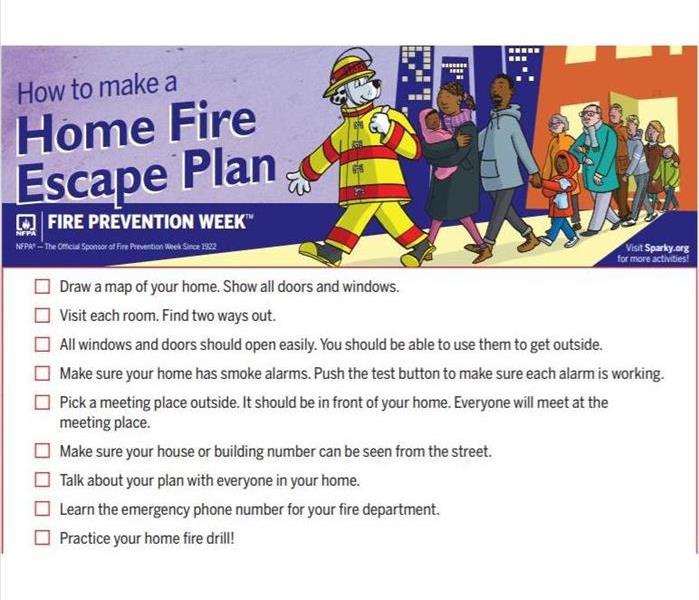 A home fire escape plan is a great first step in recognizing National Fire Prevention Week!
A home fire escape plan is a great first step in recognizing National Fire Prevention Week!
This year’s FPW campaign, “Serve Up Fire Safety in the Kitchen!TM” works to educate everyone about the simple but important actions they can take to keep themselves, and those around them, safe in the kitchen.
These timely tips are from NFPA. With Riverside going into fire season which runs from September through December, these general safety tips will help protect you, your family and your home!
Smoke Alarms
• Smoke alarms detect and alert people to a fire in the early stages. Smoke alarms can mean the difference between life and death in a fire.
• Working smoke alarms cut the risk of dying in a home fire in half.
• Install smoke alarms in every sleeping room, outside each separate
sleeping area, and on every level of the home, including the basement.
• Test smoke alarms at least once a month using the test button.
• Make sure everyone in the home understands the sound of the smoke alarm and knows how to respond.
Home Fire Escape Planning and Practice
Home fire escape planning should include the following:
• Drawing a map of each level of the home, showing all doors and windows
• Going to each room and pointing to the two ways out
• Making sure someone will help children, older adults, and people with disabilities wake up and get out
• Teaching children how to escape on their own in case you cannot help them
• Establishing a meeting place outside and away from the home where everyone can meet after exiting
• Having properly installed and maintained smoke alarms
• Pushing the smoke alarm button to start the drill
• Practicing what to do in case there is smoke: Get low and go. Get out fast.
• Practicing using different ways out and closing doors behind you as you leave
• Never going back for people, pets, or things
• Going to your outdoor meeting place
• Calling 9-1-1 or the local emergency number from a cell phone or a neighbor’s phone
Heating
• Heating equipment is one of the leading causes of home fires during the winter months.
• Space heaters are the type of equipment most often involved in home heating equipment fires.
• All heaters need space. Keep anything that can burn at least 3 feet (1 meter) away from heating equipment.
• Have a 3-foot (1-metre) “kid-free zone” around open fires and space heaters.
• Purchase and use only portable space heaters listed by a qualified testing laboratory.
• Have a qualified professional install heating equipment.
• Maintain heating equipment and chimneys by having them cleaned and inspected by a qualified professional at least once a year.
Look for more tips on our social media platforms.
Instagram
Facebook
Twitter
SERVPRO of West Riverside City has the knowledge and experience to address damage caused by fire, smoke, or water.
We're here to help!
951-351-8033
Fire Prevention Week- A little Cooking…a Little History
10/3/2020 (Permalink)
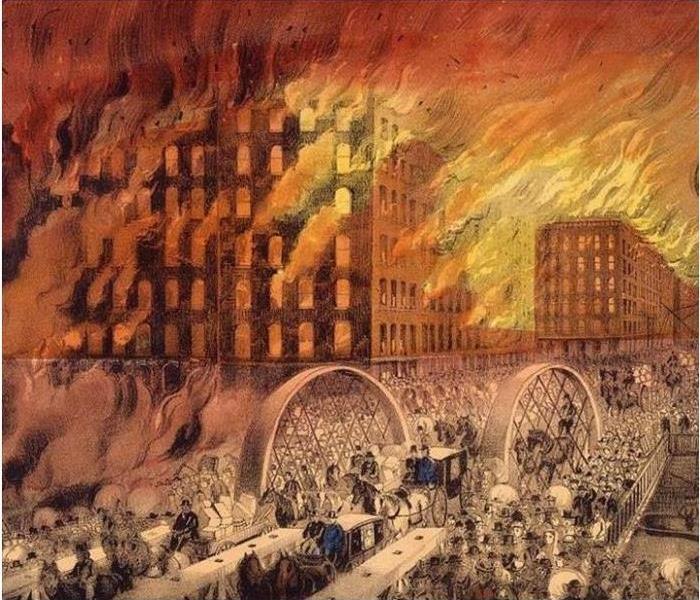 Fire Prevention Week is observed each year during the week of October 9th in commemoration of the Great Chicago Fire
Fire Prevention Week is observed each year during the week of October 9th in commemoration of the Great Chicago Fire
The cooking and baking season is just around the corner. In order to avoid a ruined holiday, follow the advice below!
Families gather to celebrate the holidays by preparing a delicious feast, but if you don’t practice safe cooking habits, your holiday could become hazardous very quickly. According to the National Fire Protection Association, cooking fires are the number one cause of home fires and home injuries.
The leading cause of fires in the kitchen is unattended cooking.
Did you know?
Cooking is the #1 cause of home fires and home fire injuries. Unattended cooking is the leading cause of fires in the kitchen. Follow these tips from NFPA
Recipe for safety
Before you serve a meal, it’s essential to serve up fire safety in the kitchen. There’s nothing like spending time in the kitchen cooking a delicious meal for family and friends or an appetizing treat for yourself. But do you know the important steps to take long before anyone takes the first bite?
Cooking
• Cooking is the leading cause of home fires and home fire injuries. Thanksgiving is the leading day for fires involving cooking equipment.
• The leading cause of fires in the kitchen is unattended cooking.
• Stay in the kitchen when you are frying, boiling, grilling, or broiling food.
• If you are simmering, baking, or roasting food, check it regularly and stay in the home.
• Always keep a lid nearby when cooking. If a small grease fire starts, slide the lid over the pan and turn off the burner. Leave the pan covered until it’s cool.
• Keep anything that can catch fire away from your stovetop.
• Loose clothing can hang down onto stove burners and catch fire. Wear short, close-fitting, or tightly rolled sleeves when cooking.
• Have a “kid-free zone” of at least 3 feet around the stove and areas where hot food or drink is prepared or carried.
Importance of fire prevention
In a fire, mere seconds can mean the difference between a safe escape and a tragedy. Fire safety education isn’t just for school children. Teenagers, adults, and the elderly are also at risk in fires, making it important for every member of the community to take some time every October during Fire Prevention Week™ to make sure they understand how to stay safe in case of a fire.
On this site, you’ll find loads of educational resources to make sure that every person knows what to do in case of a fire. We have everything from apps to videos to printables and much more, to make sure you have the resources you need to keep your family, your community, and your city safe.
About Fire Prevention Week
Since 1922, the NFPA has sponsored the public observance of Fire Prevention Week. In 1925, President Calvin Coolidge proclaimed Fire Prevention Week a national observance, making it the longest-running public health observance in our country. During Fire Prevention Week, children, adults, and teachers learn how to stay safe in case of a fire. Firefighters provide lifesaving public education in an effort to drastically decrease casualties caused by fires. Fire Prevention is a dedicated way to try to improve conditions and make efforts to correct an issue before it turns into a problem.
Fire Prevention Week is observed each year during the week of October 9th in commemoration of the Great Chicago Fire, which began on October 8, 1871, and caused devastating damage. This horrific conflagration killed more than 250 people, left 100,000 homeless, destroyed more than 17,400 structures, and burned more than 2,000 acres of land.
Click for more on Great Chicago Fire
This fire, according to President Calvin Coolidge, could of been prevented if the conditions of the building were better. Please use this month of October to try and help your home or business from fires.
National Preparedness Month- Week 4: Teach Youth About Preparedness- Wildfires
9/23/2020 (Permalink)
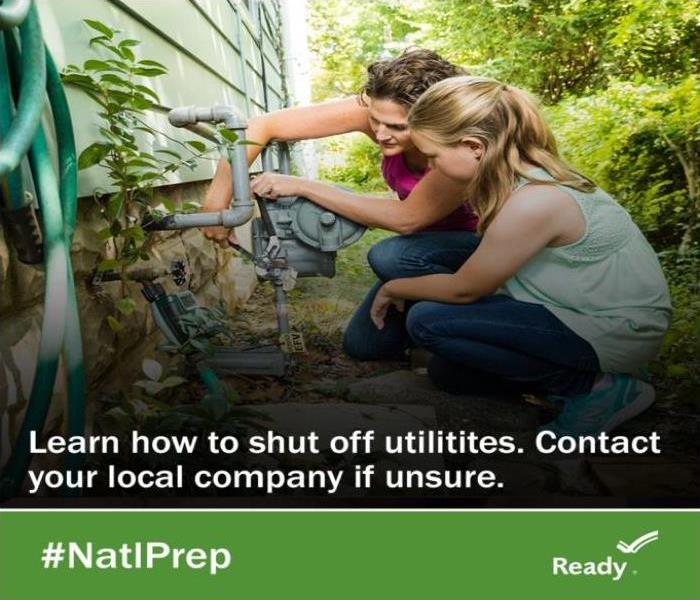 Talk to your family about shut off valves and where they are located.
Talk to your family about shut off valves and where they are located.
Each year Riverside county is faced with wildfires.
How can you ensure your kids are informed on what to do if a wildfire hits your Riverside area. What if your kids are not with you when this happens? Ready.gov can help you and your family plan for such disasters. Here are some tips.
A wildfire is a fire that burns out of control in a natural area, like a forest, grassland, or prairie. Wildfires can start from natural causes, such as lightening, but they are usually caused by humans, such as campers or hikers who did not put out their campfire properly. Wildfires spread quickly, burning brush, trees, and homes in its path. They can also affect natural resources (such as soil, animals, forests), destroy homes, and put people’s lives in danger.
Words to know!
Evacuation
Leaving an area that has been declared unsafe.
Evacuation Notice
An evacuation notice tells you that a fire is nearby, and it is important—or mandatory—to leave the area.
Fire Extinguisher
A fire protection device that sprays foam and is used to help put out small fires.
Fire Weather Watch
A notice that dangerous fire weather conditions are possible over the next 12 to 72 hours.
Red Flag Warning
Also called a Fire Weather Warning, it is a warning for when fire danger exists because of weather patterns.
Smoke Alarms
Sensors attached to the ceiling that sound an alarm when they sense smoke.
Am I at Risk?
Wildfires can happen anywhere, anytime. The chance of wildfires happening is higher when there is little or no rainfall. This makes bushes, grass and trees dry and easier to burn. High winds can spread wildfires. Your community may have a designated wildfire season when the risk is particularly high.
What Can I do?
Before
- Build an emergency kit.
- Make a family communications plan.
- Know your evacuation route.
- Make sure your family has smoke alarms on every level of your home, especially in bedrooms. Ask your parents to check them every month and to change the batteries every year.
- If you don’t have a smoke alarm, check with your local fire department about getting a free one.
- Help your parents to rake the lawn and get rid of leaves and twigs. These can catch fire if a wildfire is near your home. Never play with matches. You could accidentally start a fire.
During
- Listen to emergency officials
- Follow local emergency officials’ orders. If they say to evacuate, do so immediately.
- If you see a wildfire, call 911. You may be the first person to have spotted it!
- If trapped, call 9-1-1.
- An adult might ask you to wear a mask. Keep this on- it will help keep dangerous particles from smoke and ash out of the air you breathe.
After
- Call 9-1-1 and seek help immediately if you or someone you are with has been burned. Cool and cover burns to reduce the chance of further injury or infection.
- If you are at home, keep a “fire watch.” That means, look for smoke or sparks throughout the house. If you see anything, tell a grown-up immediately!
- If you have evacuated, do not go home until safety officials say it’s okay. Stay away from downed or dangling power lines. They could electrocute you.
- Avoid walking on hot/burning surfaces. After a fire, the ground may contain heat pockets or hidden embers. Stay away. They could burn you or spark another fire.
- If you have animals, watch them closely and keep them under your control. Note that hidden embers and hot spots could burn their paws or hooves.
- Do not use water from the faucet unless emergency officials say it’s okay.
- Burned areas should be monitored for at least 12 hours to make sure the fire is out and danger has past.
- Do not attempt to remove heavy debris by yourself. Wear protective clothing, including a long-sleeved shirt, long pants, work gloves and sturdy, thick-soled shoes during clean up. These will protect you from further injury from broken glass, exposed nails or other objects.
- Throw away food exposed to heat, smoke, or soot. When in doubt throw it out.
- Use text or social media to communicate with your family and friends.
Watch a Video
Did you know?
The three elements needed to create and keep a fire burning are heat, fuel, and oxygen, also known as the fire triangle.
Incident Meteorologists (IMETs) are a group of around 70 specially-trained weather experts with the National Weather Service. They work closely with wildfire responders at wildfire sites to monitor, analyze, and report fire and weather conditions. Their forecasts help firefighters plan operations when dealing with the unpredictable nature of fire. This helps keep emergency responders safe.
Please use the link to watch a couple of videos with your kids to help them understand further the threat of a wildfire and what they can do.
FEMA Prepare for Kids
Disaster Dodgers
Wildfires can cause a lot of damage to your home. Let SERVPRO help you, keep our information handy. We are an emergency service company. We know how to address damage due to fire, smoke, soot or water.
SERVPRO of West Riverside City
951-351-8033
We are available 24/7, we are always here to help!
National Preparedness Week 3: Prepare for Disasters in Riverside City
9/14/2020 (Permalink)
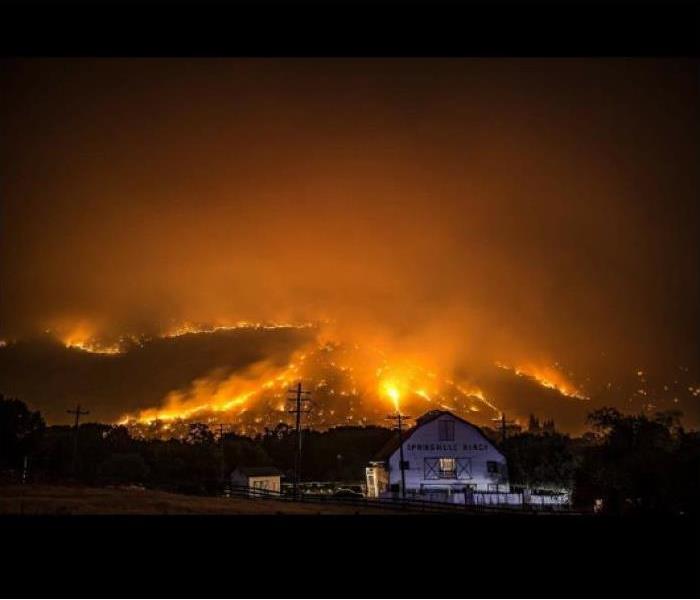 In 2019, 87% of wildfires were caused by humans.
In 2019, 87% of wildfires were caused by humans.
With fires taking place all over California, being prepared hits close to home especially for residents in Azusa, Yucaipa and those near Sequoia National Forest.
The information from Ready.gov helps limit the impacts that disasters have on you and your family. Know the risk of disasters in your area and check your insurance coverage. Learn how to make your home stronger in the face of fires, earthquakes, heat waves and other common hazards and act fast if you receive a local warning or alert.
In this blog we will discuss how to prepare for wildfires and extreme heat. Look for our next blog covering being prepared for earthquakes.
Wildfires
Wildfires can ruin homes and cause injuries or death to people and animals. A wildfire is an unplanned fire that burns in a natural area such as a forest, grassland, or prairie. Wildfires can:
- Often be caused by humans or lightning.
- Cause flooding or disrupt transportation, gas, power, and communications.
- Happen anywhere, anytime. Risk increases with in periods of little rain and high winds.
- Cost the Federal Government billions of dollars each year.
IF YOU ARE UNDER A WILDFIRE WARNING, GET TO SAFETY RIGHT AWAY
- Leave if told to do so.
- If trapped, call 9-1-1.
- Listen for emergency information and alerts.
- Use N95 masks to keep particles out of the air you breathe.
HOW TO STAY SAFE WHEN A WILDFIRE THREATENS
Prepare NOW
Sign up for your community’s warning system. The Emergency Alert System (EAS) and National Oceanic and Atmospheric Administration (NOAA) Weather Radio also provide emergency alerts. Sign up for email updates about coronavirus from the Centers for Disease Control and Prevention (CDC). Check AirNow.gov for information about your local air quality.
- Know your community’s evacuation routes and find several ways to leave the area. Drive the evacuation routes while following the latest guidelines from the Centers for Disease Control and Prevention (CDC) and your state and local authorities to prevent the spread of COVID-19. Have a plan for pets and livestock. Remember that some shelters do not accept pets.
- Prepare for long-term social distancing by gathering emergency supplies. Include cleaning supplies, non-perishable foods, first aid supplies, and water. Consider gathering soap, hand sanitizer that contains at least 60 percent alcohol, household cleaning supplies, and masks to help slow the spread of COVID-19. Set aside supplies in case you must evacuate to your safe location. After a wildfire, you may not have access to these supplies for days or even weeks. Don’t forget the needs of pets. Keep in mind each person’s specific needs, including medication. Obtain extra batteries and charging devices for phones and other critical equipment. Being prepared allows you to address smaller medical issues at home, alleviating the burden on urgent care centers and hospitals.
- Being prepared allows you to avoid unnecessary excursions and to address minor medical issues at home, alleviating the burden on urgent care centers and hospitals.
- Remember that not everyone can afford to respond by stocking up on necessities. For those who can afford it, making essential purchases and slowly building up supplies in advance will allow for longer time periods between shopping trips. This helps to protect those who are unable to procure essentials in advance of the pandemic and must shop more frequently. In addition, consider avoiding WIC-approved products so that those who rely on these products can access them.
- If you already have one at home, set aside a respirator, like an N95 respirator, to keep smoke particles out of the air you breathe. Respirators are not meant to fit children. Due to COVID-19, it may be difficult to find respirators. While cloth face coverings, surgical masks, and dust masks provide protection from exposure to COVID-19, they will not protect you from smoke inhalation. To ensure that healthcare workers have access to N95 respirators, it is best to limit your exposure to smoke rather than buy respirators.
- Designate a room that can be closed off from outside air. Close all doors and windows. Set up a portable air cleaner to keep indoor pollution levels low when smoky conditions exist.
- Keep important documents in a fireproof, safe place. Create password-protected digital copies.
- Use fire-resistant materials to build, renovate, or make repairs.
- Find an outdoor water source with a hose that can reach any area of your property.
- Create a fire-resistant zone that is free of leaves, debris, or flammable materials for at least 30 feet from your home.
- Review insurance coverage to make sure it is enough to replace your property.
- Pay attention to air quality alerts.
Extreme Heat
Extreme heat is a period of high heat and humidity with temperatures above 90 degrees for at least two to three days. In extreme heat your body works extra hard to maintain a normal temperature, which can lead to death. In fact, extreme heat is responsible for the highest number of annual deaths among all weather-related hazards.
Remember:
- Extreme heat can occur quickly and without warning.
- Older adults, children and sick or overweight individuals are at greater risk from extreme heat.
- Humidity increases the feeling of heat as measured by a heat index.
IF YOU ARE UNDER AN EXTREME HEAT WARNING:
- Find air conditioning.
- Avoid strenuous activities.
- Wear light clothing.
- Check on family members and neighbors.
- Drink plenty of fluids.
- Watch for heat cramps, heat exhaustion and heat stroke.
- Never leave people or pets in a closed car.
HOW TO STAY SAFE WHEN EXTREME HEAT THREATENS
Prepare NOW
Find places in your community where you can go to get cool while following the latest guidelines from CDC about social distancing to reduce the spread of COVID-19.
Try to keep your home cool:
- Do not rely on a fan as your primary cooling device.
- Cover windows with drapes or shades.
- Weather-strip doors and windows.
- Use window reflectors such as aluminum foil-covered cardboard to reflect heat back outside.
- Add insulation to keep the heat out.
- Use a powered attic ventilator, or attic fan, to regulate the heat level of a building’s attic by clearing hot air.
- Install window air conditioners and insulate around them.
- Learn to recognize the signs of heat illness. For more information visit: www.cdc.gov/disasters/extremeheat/warning.html
If you are directly impacted by fire, or even smoke damage we have years of experience on remediating damage. We can help, and we offer FREE inspections! Call us 951-351-8033
Camping with Your Family this Summer? Here are Some Fire Pit Safety Tips
7/27/2020 (Permalink)
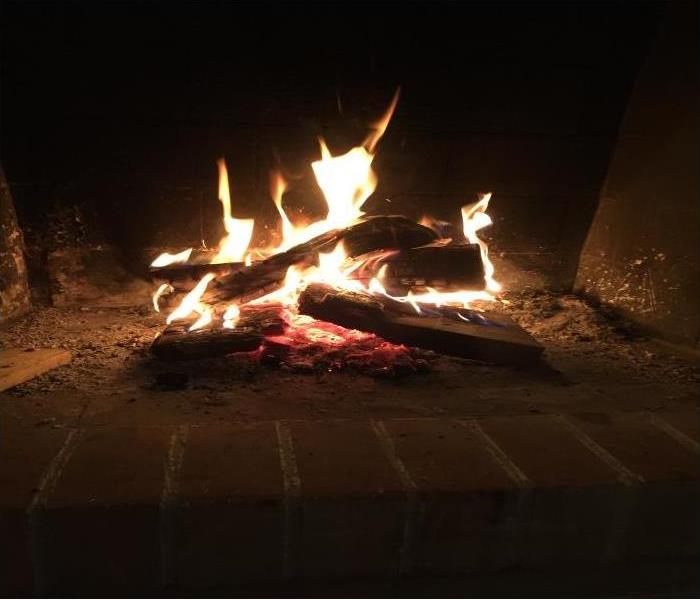 With the increasing popularity of fire pits, knowing how to use them safely has become even more important.
With the increasing popularity of fire pits, knowing how to use them safely has become even more important.
This time of year, Americans look forward to gathering around a fire pit or campfire with family, especially with travel restrictions currently in place.
But what can be an enjoyable evening can turn into a fire tragedy if you’re not careful. In this article, we address how to safely enjoy your fire pit or campfire.
With the increasing popularity of fire pits, knowing how to use them safely has become even more important. Follow this advice when setting up and using a fire pit.
- Keep flammable material and fluids, such as gasoline, diesel fuel, kerosene and charcoal lighter fluid, away from the fire pit while in use.
- Never use flammable fluids such as gasoline, alcohol, diesel fuel, kerosene and charcoal lighter fluid to light or relight fires.
- Exercise the same precautions you would with an open fire.
- Don’t wear loose fitting or flammable clothing such as nylon.
- Keep a three-foot safety zone around the fire pit. Do not allow children to use the fire pit. Keep children and pets away.
- Don’t burn trash, leaves, paper, cardboard or plywood. Avoid using soft wood such as pine or cedar that can pop and throw sparks. Seasoned hardwood is best.
- Don’t overload the fire pit. Before starting the fire, make sure that the lid will still close to extinguish the fire in an emergency.
- Check the wind direction before you light the fire.
- Keep a fire extinguisher, garden hose or bucket of water nearby.
Campfire Safety
Follow these tips to stay safe around your campfire.
- Don’t build a fire in hazardous, dry conditions or if the campground, area or event rules prohibit campfires.
- Use an existing fire ring if available.
- Choose a site that is at least fifteen feet away from tent walls, shrubs, trees or other flammable objects. The site should not have low-hanging branches overhead.
- Keep a three-foot safety zone around the campfire.
- Keep a bucket of water near your campfire.
When you’re ready to put out your fire, follow these guidelines:
- Allow the wood to burn completely to ash, if possible.
- Pour lots of water on the fire; drown all embers, not just the red ones. Pour until hissing sounds stop.
- Stir the campfire ashes and embers with a shovel. Make sure everything is wet and cold to the touch.
- Scrape the sticks and logs to remove any embers.
- If you do not have water, use dirt. Mix dirt or sand with the embers and stir until all material is cool. Do not simply bury the fire, as the fire can smolder and catch roots on fire that will eventually get to the surface and start a wildfire.
If you’ve suffered fire damage to your home or business, call SERVPRO of West Riverside City today at 951.351.8033
We’re Here for You
The team at SERVPRO of West Riverside City has specialized training and experience in fire restoration services, natural disaster and storm damage cleanup, water damage remediation and chemical cleanup. Call SERVPRO of West Riverside City (951.351.8033) any time.
How Can Riverside Residents Support National Pet Fire Safety Day-July 15, 2020
7/15/2020 (Permalink)
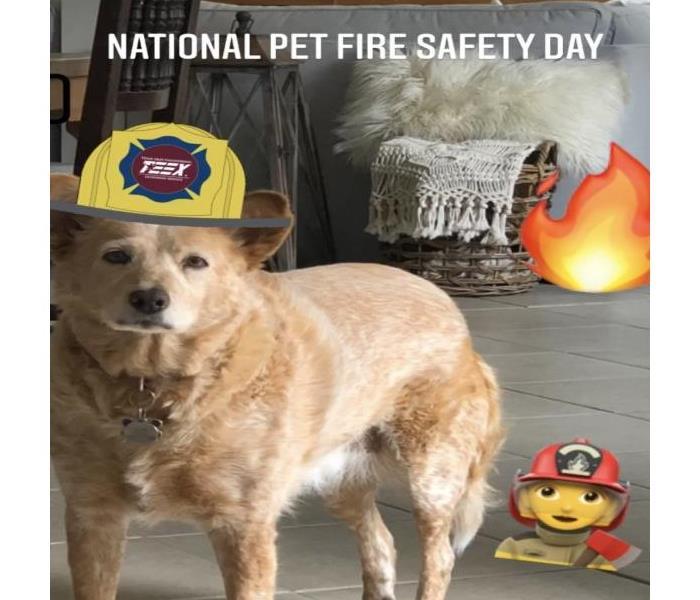 At SERVPRO West Riverside City, we have taken all precautions to keep Ellie, our cattle dog safe in the event of a fire or emergency.
At SERVPRO West Riverside City, we have taken all precautions to keep Ellie, our cattle dog safe in the event of a fire or emergency.
National Pet Fire Safety Day takes place every year on July 15, and it’s a day to learn how to keep your pet safe in a fire.
For many Riverside residents, pets are our most precious asset so it makes sense that we observe a day to keeping them safe during one of the scariest things we can imagine. It was started by the American Kennel Club and ADT Security in 2009 to help pet owners learn safety measures to protect their beloved pets and homes from fire, and it’s a great opportunity to learn how to keep your fur baby safe.
Preventing a Fire
Open flame exposure is one of the most common ways that your pet may accidentally start a fire in your home.
- Never having unsupervised candles
- Fires in your fireplace should also be monitored
- Having flameless candles and an enclosed fireplace instead
- Puppies love chewing and may chew on loose wire
- Secure loose wires and ensure they are out of reach from your pets
- Never put a glass bowl on a wooden porch as the sun’s rays can heat the bowl, causing a fire on your wooden deck
- Try using a ceramic water bowl or stainless-steel dishes instead.
Preparing for a Fire
The number one step in preparing your pet and family for a fire is to talk with your family to determine an emergency plan than includes your pet.
- Practice this plan with the whole family
- Make sure everyone knows whose job it is to grab your pet and whose it is to grab your emergency supplies
- Items to pack in your pets emergency bag: food, medication, water, a photo of your pet, leashes and carriers, and medical records
- Make sure you know where he or she likes to hide and how to get him or her out of that hiding spot quickly
- Put a decal or sticker in your home’s front window indicating the number and type of pets you have to cut down on the time firefighters spend searching for your pet.
- In case your pet escapes during the course of a fire, make sure that the contact information on their collar and microchip is up to date.
- install smoke detectors connected to emergency response services so that even if you pet is home alone, should a fire occur, help can still be signaled and dispatched.
During a Fire
As part of your emergency response plan, make sure to grab your pet’s leash or carrier as you grab your pet and escape the building.
- Outside your home will be chaotic, and your pet may try to escape to a safer area, so it is important to keep them nearby and secure.
- If it takes too long to locate or secure your pets, as much as you may not want to, leave, open the door, and call for them once you are outside and at a safe distance from the fire.
- You should never delay escape or endanger yourself or your family to rescue your family pet.
- Once responders get there, immediately inform them your pet is still inside so they can continue looking for your pet.
You can obtain a free window cling by going to www.adt.com/pets or at AKC Responsible Dog Ownership Days events. Details are available at www.akc.org.
At SERVPRO West Riverside City, we have taken all precautions to keep Ellie, our cattle dog safe in the event of a fire or emergency. We are now in peak fire season. These tips will help save the lives of our pets.
Riverside Summer Fire Safety Tips When using your Grill
7/8/2020 (Permalink)
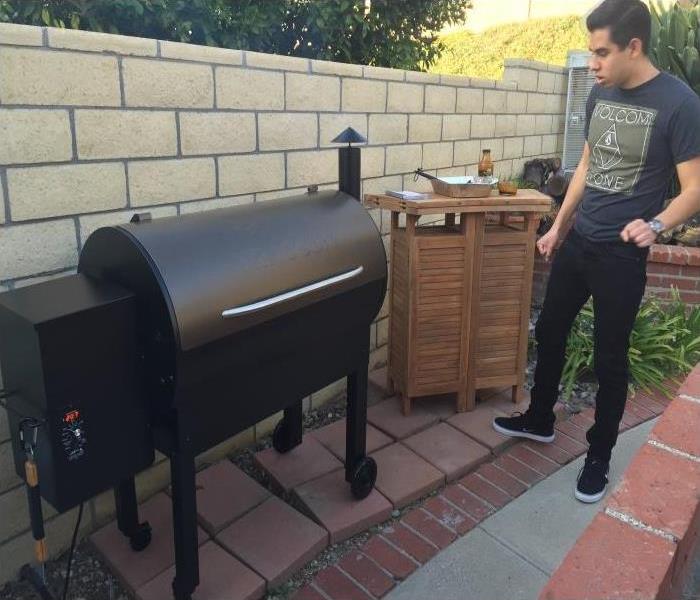 Our choice of grill is a smoker, nothing beats the taste of smoked flavored ribs. Practice safe grilling Riverside!
Our choice of grill is a smoker, nothing beats the taste of smoked flavored ribs. Practice safe grilling Riverside!
Summer is the time of the year for outdoor activities, but it also carries increased risk of fires started by outdoor cooking, fire pits and campfires.
This article will give Riverside residents important safety guidelines for grilling food outdoors.
NFPA provides the following statistics:
- July is the peak month for grill fires (18%), including both structure, outdoor or unclassified fires, followed by June (15%), May (13%) and August (12%).
- The grill had not been cleaned in more than one-quarter (29%) of the home grill structure fires.
- The leading area of origin for structure fires involving grills was an exterior balcony or open porch, and 44 percent of the property damage from grill structure fires resulted from fires that started there.
- Five of every six grills involved in home fires were fueled by gas (84 percent), while 12 percent used charcoal or another solid fuel.
- Gas grills were involved in an average of 8,900 home fires per year. Leaks or breaks were primarily a problem with gas grills.
- Charcoal or other solid-fueled grills were involved in 1,300 home fires per year.
General Grill Safety
- Only use propane and charcoal grills outdoors. This will minimize the risk of fire and exposure to toxic gases and potential asphyxiation.
- Position the grill several feet away from house siding and deck railings. Don’t locate it under eaves and overhanging branches.
- Place the grill a safe distance from lawn games, play areas and foot traffic. Keep children and pets from the grill area by creating a three-foot safety zone around the grill.
- Use long-handled barbecue tools. Wear short sleeves or roll them up when cooking on the grill.
- Periodically clean out the grease or fat that has built up in trays below the grill.
- Keep a bucket of water near your grill.
Charcoal Grills
- At the start of grilling season, make sure your grill is clean and free of ash and grease.
- Purchase the appropriate starter fluid and store it out of reach of children and away from heat sources. Never use any flammable or combustible liquid other than charcoal starter fluid.
- Never add charcoal starter fluid after coals or kindling have been ignited.
Propane Gas Grills
- Follow the manufacturer’s instructions on how to set up the grill and maintain it.
- At the start of grilling season, check the burners for clogs, make sure all hoses and connections are secure, and restock the propane if needed.
- Check the propane cylinder hose for leaks before using it for the first time each year. A soap and water solution applied to the hose will bubble up to reveal escaping propane. If you detect a leak, turn off the tank and grill. If you can stop the leak, don’t use the grill until you have it serviced by a professional. If the leak won’t stop, call the fire department.
- If you smell gas while cooking, get away from the grill and call the fire department. Do not attempt to move the grill.
- Use only propane cylinders manufactured after April 2002 with overfill protection devices (OPD).
- Never store propane cylinders in buildings or garages.
If you’ve suffered fire damage to your home or business, call SERVPRO of West Riverside City today at 951.351.8033
We’re Here for You
The team at SERVPRO of West Riverside City has specialized training and experience in fire restoration services, natural disaster and storm damage cleanup, water damage remediation and chemical cleanup. Call SERVPRO of West Riverside City (951.351.8033) any time.
How Can Riverside Families Celebrate July 4th, 2020 with COVID-19 Orders Still in Place
7/1/2020 (Permalink)
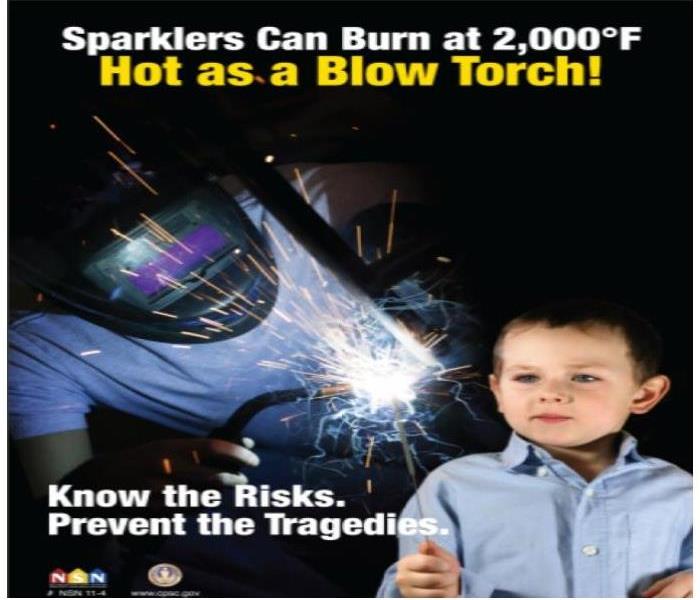 Did you know?
Sparklers burn at 1200 Fahrenheit? That is hot enough to cause third degree burns and start a fire with just about anything.
Did you know?
Sparklers burn at 1200 Fahrenheit? That is hot enough to cause third degree burns and start a fire with just about anything.
Summer is traditionally known for fireworks, barbeques, and picnics with loved ones.
Fireworks are beautiful to see and enjoy while being outside on a summer night, but it can also be dangerous. This year can pose a change due COVID-19 and the CDC guidance regarding social distancing. Many cities may not hold their annual fire work show. Riverside typically hosts a show at Mt. Rubidoux or La Sierra parks, however, reports indicate that Riverside will not host the show. This is because of a need to reduce costs to balance the city budget and also to avoid large crowds during the COVID-19 pandemic.
This may tempt many households to purchase fireworks and have their own 4th of July celebration. There are many reasons they are illegal in Riverside. Riverside County has very diverse terrain. The vegetation is very dry where fireworks can easily start a brush fire. More fires are reported on July 4th than any other day of the year, according to the National Fire Protection Association. Fireworks started an estimated 19,500 fires in 2018, including 1,900 structure fires, 500 vehicle fires, and 17,100 outside and other fires. In 2018, U.S. hospital emergency rooms treated an estimated 9,100 people for fireworks related injuries; half of those injuries were to the extremities and 34% were to the eye or other parts of the head. Children younger than 15 years of age accounted for more than one-third (36%) of the estimated 2018 injuries. These injury estimates were obtained or derived from the U.S. Consumer Product Safety Commission’s 2018 Fireworks Annual Report by Yongling Tu and Jason Ng.
Did you know?
That sparklers burn at 1200 Fahrenheit? That is hot enough to cause third degree burns and start a fire with just about anything.
What Can Families do July 4th 2020?
Since many annual Independence Day events are canceled in 2020 because of the COVID-19 pandemic, what can families do to observe this holiday? Here are 18 4th of July activities for families from CountryLiving.com.
18 4th of July Activities to Keep the Family Entertained All Day
- Throw a Family-friendly Fourth U-Pick Party
- Go Camping in Your Backyard
- Watch a Patriotic Movie Outside
- Plan a Soda Float Social
- Take a Family Bike Ride
- Play Patriotic Games
- Dine Al Fresco
- Create 4th of July Cocktails
- Make an Unforgettable Dinner
- Throw a Family Pool Party
- Go for a Family Picnic
- Spark Up the Sparklers (Not recommended in Riverside City)
- Bake a Red, White, and Blue Treat
- Stage a Hot Dog Eating Contest
- Play a Little Baseball
- Make DIY Decorations Together
- Eat Barbecue with Family
- Enjoy S'mores Around a Campfire
ALL fireworks, including sparklers, are illegal in Riverside County. All fireworks are illegal because they cause serious injuries and very often, cause fires. Riverside County has very diverse terrain. The vegetation is very dry where fireworks can easily start a brush fire. Individuals who cause fires by using illegal fireworks will be held responsible for all suppression costs. These costs can run into the millions of dollars.
Since Studies show that there is more property damage on the Fourth of July than any other day of the year it is a good idea to check with your home owner’s insurance company regarding your coverage relating to fireworks. If you are involved in illegal fireworks you may not be covered. This could be a costly celebration!
If something happens to go wrong, and you experience fire damage, call SERVPRO of West Riverside City at 951-351-8033
When your Riverside home or business suffers fire damage, it can be especially devastating. In addition to the fire and smoke damage, your property may have substantial water damage from firefighting efforts. You may feel stressed and confused after such a disaster, and you’ll need a caring expert to guide you through this crisis. SERVPRO of West Riverside City has the specialized fire and water damage equipment and expertise to help you through this tough time. We promise to treat your family with empathy and respect and your property with care.
Bring Out That Grill...Safely, While We're Home
4/27/2020 (Permalink)
 Would like more information on hiring a team experienced in Smoke & Fire Damage Restoration? Call SERVPRO of West Riverside City Today 951-351-8033
Would like more information on hiring a team experienced in Smoke & Fire Damage Restoration? Call SERVPRO of West Riverside City Today 951-351-8033
Take advantage of being "safer at home" and bring out those grills! The weather is getting nicer, so being outdoors can be a great stress reliever.
To make sure you have a safe grilling season, we will provide a list of safety precautions, such as how to check your gas lines before you start grilling and where to place your grill. Grilling is supposed to be fun and relaxing. Don't let one grilling mistake ruin your spring!
Before you use your grill:
Check the major connection points between the gas (propane) tank hose and the regulator and cylinder, and where the hose connects to the burners. Tighten if loose.
- Check the gas (propane) tank hose for potential gas leaks. To do that:
- Apply a light soap and water solution to the hose using a brush or spray bottle.
- Turn the propane tank on. If there is a gas leak, the propane will release bubbles around the hose (big enough to see).
- If there are no bubbles, your grill is safe to use.
- If there are bubbles, turn off the tank and check connections If the leaks continue, then have your grill serviced by a professional before using it again.
- If the leak doesn’t stop, call the fire department immediately.
When the grill is on:
- As you are cooking, if you smell gas, turn off the gas tank and burners.
- If the leak stops immediately, get the grill serviced by a professional before using it again.
- If the smell continues, move away from the grill and call the fire department immediately. Do not move the grill.
Charcoal grills
- There are several ways to get the charcoal ready to use. Charcoal chimney starters allow you to start the charcoal using newspaper as a fuel.
- If you use a starter fluid, use only charcoal starter fluid. Never add charcoal fluid or any other flammable liquids to the fire once it starts burning.
- Keep charcoal fluid out of the reach of children and away from heat sources.
- There are also electric charcoal starters, which do not use an open flame. Be sure to use an extension cord rated for outdoor use.
- When you are finished grilling, let the coals completely cool before disposing in a metal container.
By following these steps this will help you have a safe and happy grilling season.
10 Things Never to Do When You Grill
Play it safe and check out these 10 things you should never …
- Never Leave the Grill Unattended
Never walk away from a lighted grill, because the open flames present a fire hazard. Also, for safety's sake, always have a fire extinguisher on hand.
Avoid using metal-bristle brushes to clean your grill grates; the bristles can break off and become lodged in your food. Instead, rely on a wad of aluminum foil, dish scrubbers, or clean damp rags to wipe your grill—preferably while the grates are still warm.
Make sure you have enough propane (or charcoal) to finish cooking your food before you start. Keep a spare full propane tank or bag of charcoal on hand, just in case.
Avoid using lighter fluid or lighter-fluid-infused charcoal briquettes, because the chemicals can impart a nasty flavor to your food. That’s also why you should never use gasoline, kerosene, or oil to start your grill!
Avoid food contamination both on and off the grill by following safe handling procedures: wash your hands, keep the food in the refrigerator until you’re ready to grill, and don't prepare raw meats and vegetables on the same surface. To be sure meats are sufficiently cooked, use a grill-safe thermometer to check that they've reached the proper internal temperature (165 degrees Fahrenheit for poultry, 160 degrees Fahrenheit for ground meat, and 145 degrees Fahrenheit for steaks or roasts).
Don't wear loose clothing, scarves, or dangling jewelry while grilling; these items can potentially catch fire in open flames. If you have long hair, tie it back or tuck it under a hat to avoid singeing your lovely locks.
As tempting and mouthwatering as that just-cooked steak may appear, don’t cut into it immediately, or you'll end up with a dryer, tougher piece of meat. Rest your meat for a few minutes to give the internal juices time to redistribute through the muscle fibers. You'll be rewarded with juicy goodness in every bite.
Be careful not to overcook your meat. Not only does burned barbecue taste unappealing, but it also forms dangerous carcinogenic compounds, known as heterocyclic amines (HCAs), which have been linked to increased risks of pancreatic, colorectal, and prostate cancer.
Never stand directly over a smoky grill, and avoid inhaling the fumes. Grill smoke contains carbon monoxide as well as substances called polycyclic aromatic hydrocarbons (PAHs), which have been linked to increased risk of certain cancers—especially lung cancer.
Grilling under the influence of alcohol can be a recipe for disaster. Wait to pop open a cold one until the grilling and food preparation is complete, then help yourself to a recreational beverage while your meat is resting.
HAPPY GRILLING!!!
If you would like more information on hiring a team experienced in Smoke and Fire Damage Restoration Call SERVPRO of West Riverside City Today at (951) 351-8033
Safe Wildfire Smoke Damage & Ash Cleanup in Riverside City
3/2/2020 (Permalink)
It’s important for consumers to be aware of the many dangerous health effects caused by returning to smoke-salvageable and smoke-damaged buildings.
It’s imperative that fire and smoke odor cleanup be performed correctly and safely to stave off any ill health effects and permanent property damage.
Follow These Steps from our friends at IICRC:
To help home and business owners returning to fire and smoke damaged properties, the IICRC offers the following tips:
- Safety is most important. Wear an N-95 ANSI-approved dust mask (like a painter’s mask) and work gloves during cleanup.
- Ventilate the home. Place a box fan in an open window to draw smoke-odor laden air and char out of the building.
- Replace ventilation filters as soon as possible, then run the ventilation system to filter-out smoke-related particles.
- Clean the exterior of the building of fire-damaged debris, smoke and char particles. Exterior cleaning includes washing off the building, sidewalks, driveways and decks with detergent and fresh water scrubbing followed by rinsing.
- Clean the interior by dry HEPA (High Efficiency Particulate Air), vacuuming the ceiling, upper and lower walls and then flooring. In some situations, detergent wet cleaning must be applied to remove a smoke film which impacts and absorbs onto surfaces.
- Vacuum contents and upholstery. Make sure your house or building vacuum is HEPA rated, otherwise, you risk blowing smoke and soot into the air. Draperies, clothing and machine-washable items such as towels may be dry cleaned or laundered.
- Unless the upholstery manufacturer says otherwise, use a mild alkaline cleaner to neutralize acid in smoke, soot, char and ash.
- When smoke and soot damage and residue is moderate or heavy, or you cannot complete smoke and soot odor removal on your own, consider hiring a professional who is certified in fire and smoke damage restoration to cleanup and restore your home or business and belongings. To find a trained and certified professional in your area, visit the IICRC website at www.IICRC.org and select “Locate a Certified Pro.”
- Check with your insurance provider to determine if smoke damage from outdoor sources is covered under your policy. Insurance companies can often provide a list of credible restoration companies from which property owners can choose.
- If the fire has warped or distorted the structure, consult a general contractor who can also be found in the IICRC list of approved restorers.
When hiring a fire and smoke removal professional in your area, make sure that the technician is a certified Fire and Smoke Restoration Technician (FSRT) to ensure they are educated on the latest techniques for proper remediation. In some cases, a mold remediator may also be necessary as the volume of water used to combat fires can result in an abundance of standing water within a property, leading to mold growth.
To find certified restorers in your area or to confirm the certification of any company that has contacted you, call the IICRC at 1-844-464-4272 or visit www.IICRC.org and select “Locate a Certified Pro.”
Check Before You Burn in Riverside County
1/20/2020 (Permalink)
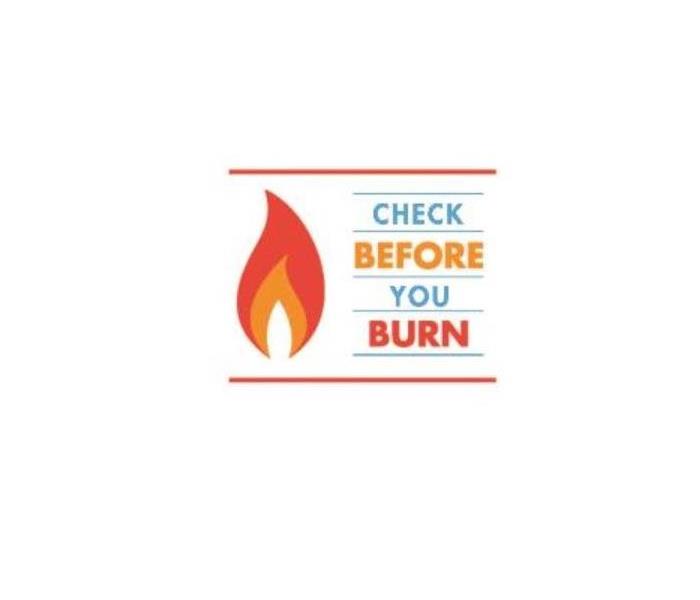 The Check Before You Burn" initiative was created to reduce pollution and protect public health from the harmful emissions of wood burning.
The Check Before You Burn" initiative was created to reduce pollution and protect public health from the harmful emissions of wood burning.
During late fall and early winter, the South Coast Air Quality Management District (South Coast AQMD) asks residents to participate in its "Check Before You Burn" program by not burning wood in fireplaces when unhealthful air quality is forecast. Under the program -- intended to help improve wintertime air quality --South Coast AQMD may issue mandatory no-burn alerts from November 1 through the end of February.
No-burn alerts are issued for 24-hour periods for residential wood-burning fireplaces, backyard fire pits and wood stoves when emissions and stagnant weather conditions raise fine particulate pollution to unhealthy levels. Alerts are typically issued for the entire South Coast Air Basin, which encompasses all of Orange County and the non-desert portions of Los Angeles, Riverside and San Bernardino counties.
Why do we need "Check Before You Burn"
The Check Before You Burn" initiative was created to reduce pollution and protect public health from the harmful emissions of wood burning. Despite steady progress toward improved air quality, Southern California still has the worst pollution in the country.
Reduce Pollution Caused by Wood Burning
Since November 1, 2011, wood burning in the South Coast Air Basin has been prohibited every year from November 1 through the end of February when no-burn alerts are issued due to forecasts of unhealthy levels
There are plenty of wood-burning alternatives and resources to help you switch to cleaner-burning gas log sets.
Reduce Health Risks Caused by Wood Burning
Pollution from wood smoke contains very small particles. These particles are the width of a human hair! Because it’s so small, these particles can lodge deep in the lungs and cause a variety of respiratory health problems.
Long-term exposure can lead to reduced lung function and chronic bronchitis. In some cases, prolonged exposure to this harmful substance may even lead to premature death. Short-term exposure can make existing respiratory conditions such as asthma or lung disease worse. It may also increase the risk of respiratory infections, and those with heart disease could even be at risk for heart attacks or arrhythmia. Young children and the elderly are especially vulnerable to the effects.
How to Reduce Air Pollution from Wood Burning
A wood-burning fireplace can cause pollution and be harmful to your lungs. But with some small changes, you can make a big difference. Here are some tips to help reduce pollution from your wood-burning fireplace:
- Choose not to burn when air quality is already poor. Check the South Coast AQMD Air Quality Index in your local newspaper or visit www.aqmd.gov to monitor when the air quality is poor to avoid burning wood on these days. Pay close attention during wood-burning season - November to February - to ensure you are not burning wood when a mandatory no-burn alert has been issued for your area. Save energy and reduce pollution during these months by wearing a sweater on chilly nights.
- Reduce your need for fuel. Make your home more energy-efficient by installing ceiling insulation, and by weather stripping or caulking windows and doors. Close off unused rooms if you don’t have central heating.
- Have your chimney professionally cleaned. Keep your chimney swept and ash area clean to improve air flow and reduce emissions. Chimneys should be professionally cleaned periodically to prevent creosote buildup and reduce the potential for chimney fires. Store wood outdoors, off the ground and with the top covered.
- If you do burn wood, start fires with softwood kindling such as pine or fir. Always burn “seasoned” or dry wood. These woods are generally low in density, ignite easily, burn fast and hot and will heat the firebox and flue quickly. Hardwoods such as oak can take longer to ignite, but they burn slower and produce less smoke. Remember to use smaller fires in mild weather.
- Never burn garbage and other materials. It can cause toxic smoke that can be extremely harmful to you and your neighbors.
- Watch chimney for smoke. Properly burning fires should give off only a wisp of white steam. The darker and thicker the smoke, the more pollution the fire emits, and the more fuel it wastes.
- Beware of overnight heating. Do not leave open fires unattended or let them burn overnight. This can lead to a back draft of smoke in your home, causing hazardous indoor air pollution. Build a small, hot fire and let it burn out completely, closing the damper when finished.
- For heating, switch to a cleaner wood-burning alternative. An EPA-certified wood stove emits up to 70 percent less particulate emissions and uses 30 percent less fuel.
- Replace your wood-burning fireplace with a natural-gas insert. The particle pollution from one wood stove is equivalent to that emitted by 3,000 gas furnaces producing the same amount of heat per unit.
- Remember... If you can smell smoke, you are breathing smoke!
How do I know if a no-burn alert has been issued?
Residents can obtain no-burn alert information by:
- Signing up for South Coast AQMD Air Alerts sent via e-mail;
- Using South Coast AQMD’s interactive residential no-burn alert map by entering an address or ZIP code in the search area; or
- Calling 866-966-3293 for Check Before You Burn information.
Information from our friends at South Coast AQMD
Our first responders are amazing hard-working men and women and they do their very best to provide awareness and prevention. First responders work hard to prepare everyday citizens to make our emergencies a little more manageable.
Consider SERVPRO as your second first responder. We do our best to provide awareness and prevention to all who meet us. We don’t want you to have a disaster or damage. No one wants their lives, or homes to be turned upside down. That is why we do our best to provide you with the knowledge and tools to prevent them.
Be sure to thank a first responder today and let them know how much their hard work is appreciated. Don't forget to mind "Check Before You Burn" regulations for the safety of you, your neighbors, and our first responders.
How to Prevent Christmas Tree Fires in your Riverside Home
12/23/2019 (Permalink)
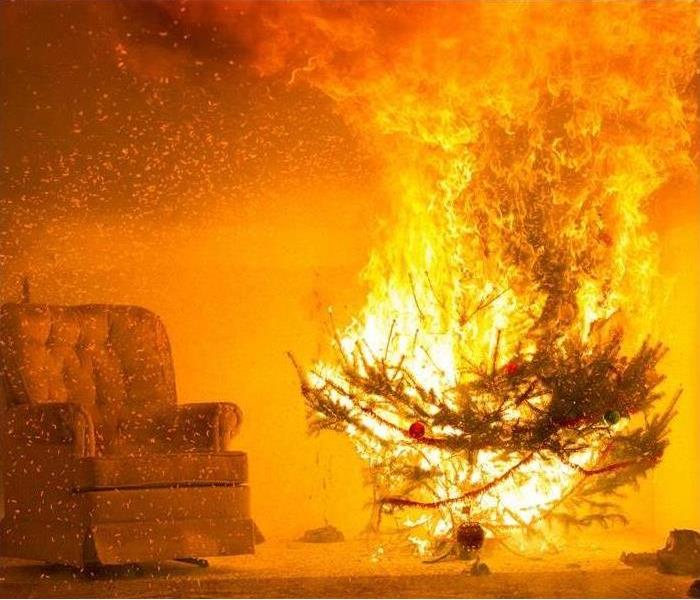 Christmas Trees can start a huge fire that can completely damage your Riverside home. Check out our safety guidelines.
Christmas Trees can start a huge fire that can completely damage your Riverside home. Check out our safety guidelines.
When showcasing a live tree in your home, the combination of tree dryness, electrical malfunction with lights and poorly located heating sources can make for a deadly combination.
Christmas trees account for hundreds of fires each year. Typically, shorts in electrical lights or open flames from candles, lighters or matches start tree fires.
Here are some tips from National Fire Protection Association
Picking the tree
- Choose a tree with fresh, green needles that do not fall off when touched.
Placing the tree
- Before placing the tree in the stand, cut 2” from the base of the trunk.
- Make sure the tree is at least three feet away from any heat source, like fireplaces, radiators, candles, heat vents or lights.
- Make sure the tree is not blocking an exit.
- Add water to the tree stand. Be sure to add water daily.
Lighting the tree
- Use lights that have the label of a recognized testing laboratory. Some lights are only for indoor or outdoor use.
- Replace any string of lights with worn or broken cords or loose bulb connections. Read manufacturer’s instructions for number of light strands to connect.
- Never use lit candles to decorate the tree.
- Always turn off Christmas tree lights before leaving home or going to bed.
Facts
- More than one of every four home Christmas tree fires is caused by electrical problems.
- Although Christmas tree fires are not common, when they do occur, they are more likely to be serious.
- A heat source too close to the tree causes one in every four of the fires.
Pets
When you have the joy of pets, there are precautions that need to be taken to keep them safe. Make sure the tree can not be toppled over by the mischief pet pawing at the delicate ornaments that look ever so tasteful. Loop twine or fishing line around the trunk and tie to a screw in the wall. If there are cords on the floor they can be duct taped down to keep your pets from chewing on them. Keep the needles cleaned up off the floor to keep your pets from licking them and possibly ingesting insecticides or flame retardants.
After Christmas
Get rid of the tree after Christmas or when it is dry. Dried-out trees are a fire danger and should not be left in the home or garage, or placed outside against the home.
- Check with your local community to find a recycling program.
- Bring outdoor electrical lights inside after the holidays to prevent hazards and make them last longer.
SERVPRO of West Riverside team wants to ensure that everyone has a safety in mind. In the unlikely event that a fire were to occur, know that the SERVPRO team in Riverside is ready to assist 24/7 by calling 951-351-8033.
Fire Damage in the Home You Rent in Riverside: Will Your Renter’s Insurance Cover You?
11/20/2019 (Permalink)
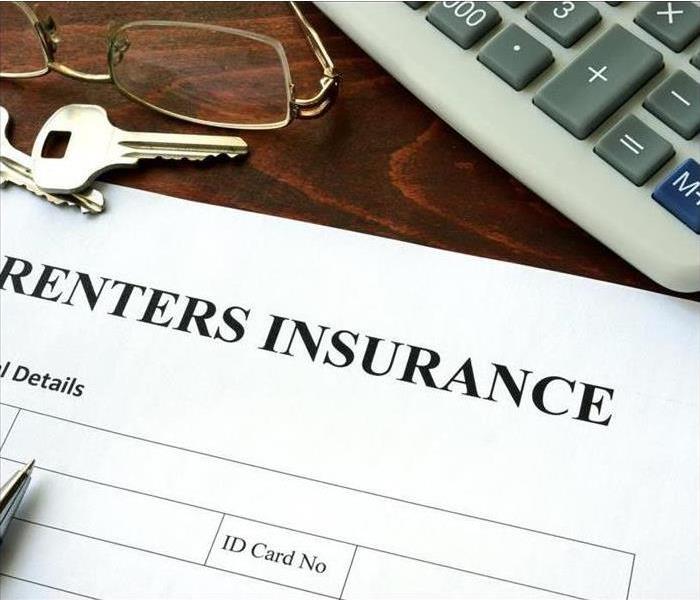 Knowing about the five major coverage areas is a good starting place. Work with your insurance agent, do your research.
Knowing about the five major coverage areas is a good starting place. Work with your insurance agent, do your research.
Experiencing a fire in your Riverside, CA, residence can be unsettling and stressful. Understanding how your renters insurance policy will cover you can provide some peace of mind during a challenging time.
The Big Picture of Fire Coverage
Renters are covered for fire damage, but policies can vary greatly. Knowing a bit about the five major coverage areas is a good starting place.
Personal Property – This coverage allows you to be reimbursed for your personal property loss from a fire.
Liability – This benefit allows payment to others if another person sustains loss or injury as a result of your home fire.
Loss of Use – This coverage reimburses you for expenses you incur if you need to live outside your home while fire restoration proceeds.
Mandatory Evacuations – This applies if you incur living expenses or loss due to a mandatory evacuation of your home.
Natural Peril – If your fire started because of an extreme weather event or natural disaster, this provision requires your policy to cover your damages.
There are a few specific renters insurance provisions that are worthy of consideration as they may vary between policies.
Renter's Policy and Coverage Variables
As with any insurance product, it is prudent to weigh all of the factors when evaluating your current policy or a new one. Comparing coverage limits and deductibles is a good place to start. Your policy will generally cover the professional fire restoration process, but one variable that can make a big difference is the personal property reimbursement provision. Replacement value coverage is far superior as it pays for the cost of replacing your items, not just their current value. It is a good idea to confirm that fire damage will be covered even if it is secondary to an event such as an earthquake. Finally, it’s important to understand whether there are exclusions or exceptions as to the cause of the fire.
If you are preemptively investigating fire insurance for renters, this information may help you shop for the best coverage. If you’ve experienced a fire in your residence, understanding your renters insurance may help relieve your financial concerns and make an unsettling situation less stressful.
There are many renters out there that don’t understand renters insurance, or they don’t think that they need it. Here are 5 myths and facts about renter’s insurance. According to State Farm:
MYTH: The landlord’s insurance covers your possessions. Don’t count on it. Most landlords’ insurance covers only the building and damages due to negligence. Coverage for some of the most common causes of property damage and loss, such as theft, vandalism, and fire, is entirely up to you. Without renter’s insurance, you may have to bear the financial burden of a loss on your own.MYTH: Renters insurance is expensive. In this case, the numbers speak for themselves. According to the IIABA, the average renter’s policy costs just $12 a month for up to $30,000 in personal property coverage. That’s solid coverage for less than the cost of a couple cups of coffee a week.Still concerned about price? Your insurer will work with you to find the combination of coverage and cost that suits your needs. You might even qualify for a discount by taking some simple home safety precautions or purchasing another policy, such as auto insurance, with the same insurer.MYTH: You don’t need insurance if your stuff isn’t expensive. Most renters’ belongings cost more than they think. In fact the average person has over $20,000 worth of belongings that are probably not covered by a landlord’s policy.Think that number is too high? Take a moment to add up the approximate cost of your computer, television, stereo, furniture, jewelry, and clothing. If a fire gutted your apartment tomorrow, would you have the cash to replace it all?MYTH: Renters insurance covers only your possessions. In fact, renters insurance covers much more than just your personal property. The average policy also includes up to $100,000 in liability coverage. That means in the event of a covered loss, your insurer will help cover the costs if you’re held responsible for injuring another person or damaging another person’s property, including our landlord’s. Moreover, this coverage applies whether the incident occurred within your residence or elsewhere.MYTH: Renter’s insurance is hard to get. The internet makes getting renter’s insurance easier than ever. You can research providers, compare quotes, and even find an agent online. Or, just as easily, you can place a quick call to an insurance representative. Answer a few questions and you’re likely to get a rate quote almost immediately.
Why Do We Have Red flag fire danger in Riverside?
11/4/2019 (Permalink)
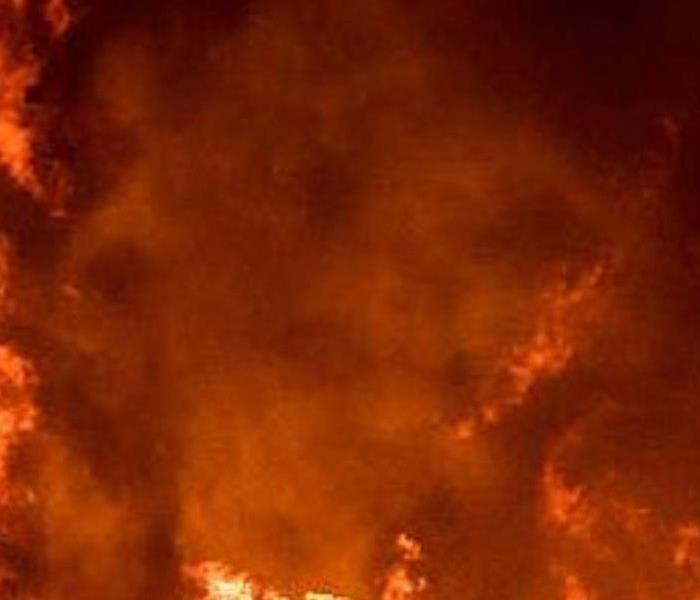 In less than 30 seconds, a small flame can turn into a major fire. Protect yourself and your family by preparing in advance.
In less than 30 seconds, a small flame can turn into a major fire. Protect yourself and your family by preparing in advance.
Fire is FAST!
In less than 30 seconds, a small flame can turn into a major fire. There is little time to escape. It only takes minutes for thick black smoke to fill your home.
Santa Anas are dry, warm (often hot) winds that blow westward through Southern California toward the coast. They're usually seasonal, and typically occur between October and March and peak in December. They originate when high pressure systems form over the high-elevation deserts of the Great Basin between the Sierra Nevada's and the Rocky Mountains. Air from the system flows clockwise, so winds on the southern side of the system push west towards the Pacific Ocean.
The winds pass over the mountains between coastal California and the inland deserts. As they flow downslope, the air gets compressed and rises in temperature at a rate of almost 29 degrees per mile of descent. While air's temperature rises, its relative humidity drops, commonly to less than 20 percent and sometimes to even less than 10 percent. The winds also increase dramatically in speed when they're forced through narrow mountain passes and canyons.
By the time the winds hit the coastal areas, they're very dry, warm, and moving fast. This is what makes them problematic. They dry out vegetation, making it better fuel for a fire—and once a fire starts, the winds fan the flames and help spread them. From Mentalfloss.com.
The California of Forestry & Fire Protections says, " A Red Flag Warning is issued for weather events which may result in extreme fire behavior that will occur within 24 hours. A Fire Weather Watch is issued when weather conditions could exist in the next 12-72 hours. A Red Flag Warning is the highest alert. During these times extreme caution is urged by all residents, because a simple spark can cause a major wildfire. A Fire Weather Watch is one level below a warning, but fire danger is still high."
According to the National Fire Protection Association:
- Seventy-one percent of households have a fire escape plan, but only 47% of those have practiced it.
- One-third believe they have at least six minutes before a fire in their home becomes life-threatening.
- Only 8% said their first thought was to get out when they heard the smoke alarm.
It's clear from this survey that many in our community probably don't understand the life-threatening risks from heat and toxic smoke produced in a modern home fire. Fire departments need to re-enforce these messages about the characteristics of fire: Fire is FAST. Fire is DARK. Fire is HOT. Fire is DEADLY!
Thirty years ago, people had 17 minutes to escape a home fire: now they have about two minutes. New construction practices and materials, as well as the furniture inside, cause fires to burn faster. Another hazard found in many homes is synthetic materials such as rubber, plastic or foam. When those materials burn, they can cause cyanide poisoning. Most people who die in a fire die from smoke inhalation, not burns.
Fire is FAST!
In less than 30 seconds, a small flame can turn into a major fire.
Fire is HOT! If you inhale the super-hot air in a home fire, it will scorch your lungs. Heat is more threatening than flames. Room temperature can rise to 600 degrees F at eye level.
Fire is dark! If you wake up to a fire you may be blinded disoriented and unable to find your way around your home. Fire isn't bright. But quickly produces black smoke and complete darkness.
Fire is DEADLY! The odorless, colorless fumes from a home fire can lull you into a deep sleep. You may not wake up in time to escape. Smoke and toxic gases kill more people than flames do.
Plan it
The first step is working with your household to develop a plan for home. IAFC’s Ready, Set, Go! Program’s "Your Personal Wildland Fire Action Guide" provides handy checklists that will walk you through creating a family disaster plan, building emergency kits, identifying where to get wildfire updates from, and knowing when to evacuate.
Homeowners can reduce their risk of loss to wildfire this time of year by making simple and low-cost improvements to their home and landscape. Some of these activities are typical fall home maintenance projects, such as:
Removing dead branches from trees and shrubbery (fall is a great time of year to prune bushes and trees, reducing the ability for fire to move up from shrubs into trees);Removing leaves from gutters and roofs;Removing weeds (that are drying out) from around the home especially within the first 5 feet of the home; andMaking sure vents are screened and cleared of debrisBeing prepared is the key. Riverside is not out of danger. We still have potential winds through March. If you would like to read about more tips, check out our website under SERVPRO Blogs
Pet Fire Safety Protecting Your Riverside Pets from Potential Danger
10/30/2019 (Permalink)
 SERVPRO of West Riverside mascot Ellie is happy to know her owner has prepared an emergency plan in the event of a fire.
SERVPRO of West Riverside mascot Ellie is happy to know her owner has prepared an emergency plan in the event of a fire.
Emergencies can happen at any moment and can come in a myriad of ways. While we may never be able to fully prevent such events from happening, we can prepare ourselves and our pets for when they do.
The American Red Cross put together important tips concerning fire safety in your home. Use this list to ensure that you and your furry friends are prepared should a fire break out.
Home fires are the most common disaster that the American Red Cross responds to – and also the most preventable.
The best way to protect your pets from the effects of a fire is to include them in your family plan. This includes having their own disaster supplies kit as well as arranging in advance for a safe place for them to stay if you need to leave your home.When you practice your escape plan, practice taking your pets with you. Train them to come to you when you call.In the event of a disaster, if you must evacuate, the most important thing you can do to protect your pets is to evacuate them, too. But remember: never delay escape or endanger yourself or family to rescue a family pet.Prevent Your Pets from Starting Fires
The National Fire Protection Association estimates that nearly 1,000 home fires each year are accidentally started by the homeowners' pets. The American Kennel Club and ADT Security Services have joined forces to provide the following tips:
Extinguish Open Flames - Pets are generally curious and will investigate cooking appliances, candles, or even a fire in your fireplace. Ensure your pet is not left unattended around an open flame and make sure to thoroughly extinguish any open flame before leaving your home.Remove Stove Knobs - Be sure to remove stove knobs or protect them with covers before leaving the house - a stove or cooktop is the number one piece of equipment involved in your pet starting a fire.Invest in Flameless Candles - These candles contain a light bulb rather than an open flame, and take the danger out of your pet knocking over a candle. Cats are notorious for starting fires when their tails turn over lit candles.Secure Young Pets - keep them confined away from potential fire-starting hazards when you are away from home such as in crates or behind baby gates in secure areas.Help Firefighters Help Your Pets
Keep pets near entrances when away from home. Keep collars on pets and leashes at the ready in case firefighters need to rescue your pet. When leaving pets home alone, keep them in areas or rooms near entrances where firefighters can easily find them.Affix a pet alert window cling and write down the number of pets inside your house and attach the static cling to a front window. This critical information saves rescuers time when locating your pets. Make sure to keep the number of pets listed on them updated.Pets become a part of our families, and we need to remember that we need to have plans in place for them too when it comes to safely evacuating a home in case of a fire. And remember, if you are victim of a house fire, SERVPRO® of West Riverside City can help #LikeItNeverEvenHappened.
Checking your Riverside home after a fire, Taking the Appropriate Steps to Stay Safe
10/23/2019 (Permalink)
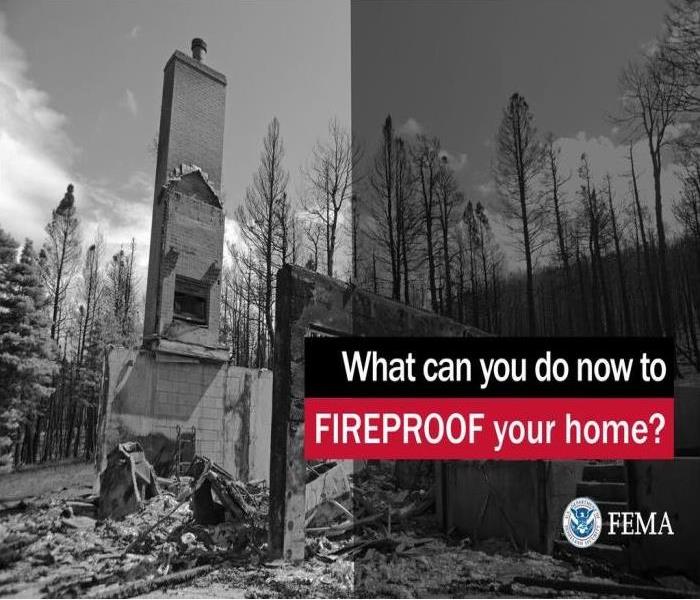 If your experience a fire, SERVPRO of West Riverside City can help relieve stress. We can work with your insurance agent to determine the next steps.
If your experience a fire, SERVPRO of West Riverside City can help relieve stress. We can work with your insurance agent to determine the next steps.
It's scary to think of experiencing a home fire. Being prepared will help you get through this stressful process. It can happen to anyone at any time. The key is knowing what to do in advance should you experience a home fire. Here are some important tips from our friends at American Red Cross.
Do not cut or walk past colored tape that was placed over doors or windows to mark damaged areas unless local authorities advise that it is safe to do so. If a building inspector has placed a color-coded sign on the home, do not enter it until you get more information, advice and instructions about what the sign means and whether it is safe to enter your home.
If you have children, leave them with a relative or friend while you conduct your first inspection of your home after the fire. The site may be unsafe for children, and seeing the damage firsthand may upset them and cause long-term effects, including nightmares.
Check for Structural Damage
Check the outside of your home before you enter. Look for loose power lines, broken or damaged gas lines, foundation cracks, missing support beams or other damage. Damage on the outside can indicate a serious problem inside. Ask a building inspector or contractor to check the structure before you enter.If the door is jammed, don’t force it open – it may be providing support to the rest of your home. Find another way to get inside.Damaged locks should be taken apart and wiped with oil. If locks can’t be removed, squirt machine oil through a bolt opening or keyhole, and work the knob to distribute the oil. Hinges should also be thoroughly cleaned and oiled.Sniff for gas. If you detect natural or propane gas, or hear a hissing noise, leave the property immediately and get well away from it. Call the fire department after you reach safety.If you have a propane tank system, turn off all valves and contact a propane supplier to check the system out before you use it again.Check for smoke and embers throughout the home, including the attic.Beware of animals, such as rodents, snakes, spiders and insects, that may have entered your home. As you inspect your home, tap loudly and often on the floor with a stick to give notice that you are there.Damaged objects, such as furniture or stairs, may be unstable. Be very cautious when moving near them. Avoid holding, pushing or leaning against damaged building parts.Is your ceiling sagging? That means it got wet – which makes it heavy and dangerous. It will have to be replaced, so you can try to knock it down. Be careful: wear eye protection and a hard hat, use a long stick, and stand well away from the damaged area. Poke holes in the ceiling starting from the outside of the bulge to let any water drain out slowly. Striking the center of the damaged area may cause the whole ceiling to collapse.Is the floor sagging? It could collapse under your weight, so don’t walk there! Small sections that are sagging can be bridged by thick plywood panels or thick, strong boards that extend at least 8–12 inches on each side of the sagging area.If the weather is dry, open windows and doors to ventilate and dry your home.If power is out, use a flashlight. Do not use any open flame, including candles, to inspect for damage or serve as alternate lighting.Disconnect and check all appliances for water damage before using them.Make temporary repairs such as covering holes, bracing walls, and removing debris. Save all receipts.Take photographs of the damage. You may need these to substantiate insurance claims later.Checking Utilities and Major Systems
Telephones
Check each telephone to see if it is still on the hook. Hang up any phones that aren’t. Wait a few minutes, and then pick up one phone to listen for a dial tone to know whether you have working telephone service.If you don’t have a dial tone, try unplugging all the phones. Plug in one at a time and listen for dial tone. This will help you determine if the phone itself is broken or the service is completely out. If it is, contact the telephone company to report the problem and request repair.Electrical, Plumbing and Heating Systems
If you see sparks, broken or frayed wires, or if you smell hot insulation, turn off the electricity at the main fuse box or circuit breaker.If there is a pool of water on the floor between you and the fuse box or circuit breaker panel, use a dry wooden stick to try to reach to turn off the main fuse or breaker, but do not step or stand in water to do that. If you cannot reach the fuse box or breaker panel, call a qualified electrician for assistance.Inspect the panel box for any breakers that may have tripped. A tripped breaker may indicate damaged wiring inside your home. Do not turn them on. Call an electrician.Use a flashlight to inspect fuses. Replace broken fuses with exactly the same amperage rating and never use an object such as a coin or strip of metal to bypass the protection that fuses provide.If you suspect sewage lines are damaged, avoid using sinks, showers or toilets and call a plumber.If water pipes are damaged, turn off the water at the main valve. Call a plumber for assistance.If you have a heating oil tank system, turn off all valves and contact a professional specializing in maintenance of such equipment before using it again.Checking Household Items
- Normal household items, such as cleaning products, can cause toxic fumes and other hazards if they mix. See our household chemical safety tips.
- Spilled chemicals that don’t pose a health risk must still be carefully cleaned up. Wear rubber gloves and discard spilled chemicals and rags used for cleaning according to the advice of local authorities.
- Throw away food, beverages and medicine exposed to heat, smoke or soot. Food that was in the freezer can be used if it still has ice crystals on it. If not, discard it.
Make Sure to:
Stay out of any building that has water around it.Keep away from loose or dangling power lines. Report them immediately to the power company.Contact your insurance agent. Do not discard damaged goods until an inventory has been taken. Save receipts for money spent relating to fire loss. Your insurance agent may provide immediate help with living expenses until you are able to return home and may offer assistance for repairs.
Six Things Riverside Homeowners Should Do After a Home Fire
10/16/2019 (Permalink)
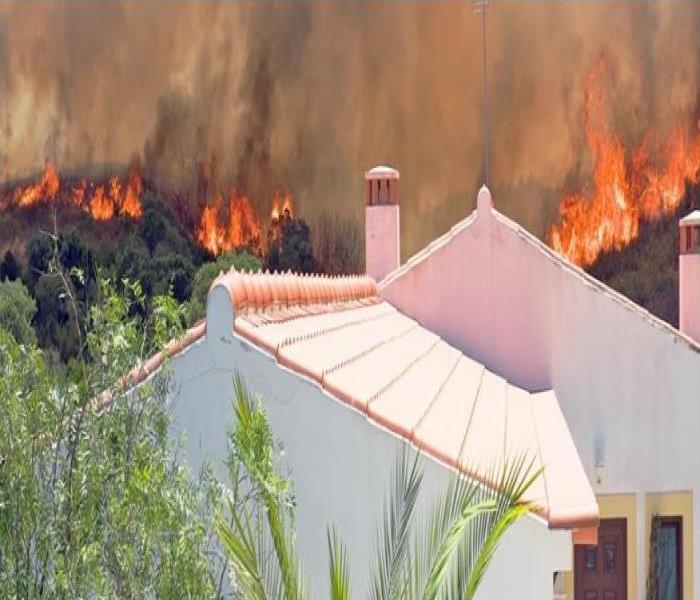 Wildfires can ruin homes and cause injuries or death to people and animals. Learn what to do after a home fire.
Wildfires can ruin homes and cause injuries or death to people and animals. Learn what to do after a home fire.
Wildfires can ruin homes and cause injuries or death to people and animals.
A wildfire is an unplanned fire that burns in a natural area such as a forest, grassland, or prairie. Wildfires can:
Often be caused by humans or lightning.Cause flooding or disrupt transportation, gas, power, and communications.Happen anywhere, anytime. Risk increases with in periods of little rain and high winds.Cost the Federal Government billions of dollars each year.IF YOU ARE UNDER A WILDFIRE WARNING, GET TO SAFETY RIGHT AWAY
Leave if told to do so.If trapped, call 9-1-1.Listen for emergency information and alerts.Use N95 masks to keep particles out of the air you breathe.Here are the six things you should do after a home fire:
1. Call your insurance agent immediately. You will be getting calls at all hours of the day from public adjusters and contractors who will try to offer you a deal on putting your house back together. These calls can create a lot of stress and confusion. I suggest you speak to no one but your agent to discuss your options at this point in the process.
2. Ask about restoration companies that can help with cleaning up soot, boarding up windows, and other construction. Immediately after a fire, especially if it is a minor one, you’ll need to clean up any soot or water damage. It is important to hire a reputable service to deal with these issues. Ask your agent or insurance adjuster to recommend a few different companies. They deal with these situations more often than you do and likely know of some businesses that fit your needs. Many of these restoration companies have connections to good contractors, engineers, and architects, as well. SERVPRO of West Riverside City is here to help.
3. Separate damaged property from undamaged property. The insurance company will need a detailed inventory list from you after they inspect the loss. Separating your damaged property from your undamaged property will make it easier for you to make a list of your damaged items. This list needs to include the date you purchased each item, the brand name, the price you paid, and the serial number, model, or description of each item. If the item was a gift, be sure to indicate that as well.
It’s a good idea to submit your receipts with this inventory list. If the receipts were destroyed in the fire, or you didn’t keep any receipts, request copies of prior bank statements. This can make obtaining duplicate receipts easier. Keep in mind that photos of any damaged items are always helpful if receipts are not available.
4. Save undamaged property from further destruction. Any items that are not damaged should be put in a safe place, even if it means putting them in storage. Insurance adjusters are typically fair when it comes to adding additional costs for storage.
5. Cooperate fully with the insurance company’s investigation. When a fire claim is reported to an insurance company, it is given top priority. Usually the adjusters come out to see the loss within 24 to 48 hours. To help settle your claim in a timely manner and to your satisfaction, be sure you are available and on time for all meetings, that you return calls promptly, that any requested paperwork is completed as quickly as possible, and that you contact the company or your agent immediately with any questions.
6. Find somewhere to stay if you can’t live in your home. Most homeowner’s policies include “Loss of Use or Loss of Rents” coverage, which will pay for the food, clothing, and shelter that you and your family may need for a specified period of time. Keep in mind that your policy will pay for “like kind and quality” living arrangements. You may want to save the Ritz for a special occasion and instead stay in a more reasonably priced hotel.
What to do before disaster strikes
• Review your homeowner’s policy to be sure you have replacement cost coverage, loss of use coverage, and adequate dwelling coverage. The last thing you want to hear after a fire is that you were underinsured.
• Save all your receipts and put them in a metal fireproof box or in a storage facility off the premises, such as a safety deposit box. Better yet, scan the receipts and save them to a computer file. Taking a video of your entire home and the possessions within it is the next best thing to receipts. This will show the insurance company what sort of lifestyle you had prior to the claim.
• Be sure to have smoke detectors in every room of your home to ensure that everyone gets out of the house or apartment safely in the event of a fire. Have exit ladders and fire extinguishers handy, and know how to use them.
• Discuss escape strategies and plans with your family prior to a fire, and consider a fire drill to help ensure everyone’s safety.
NFPA Announces "Not Every Hero Wears a Cape. Plan Your Escape!" as the theme for Fire Prevention Week
10/9/2019 (Permalink)
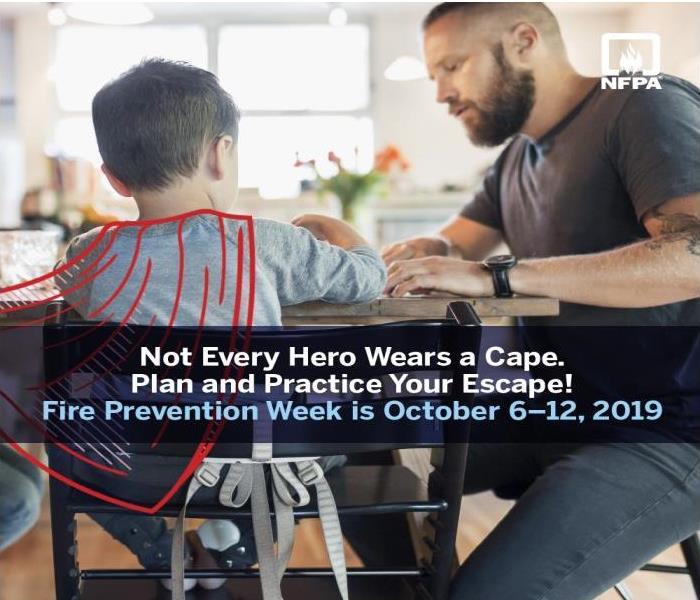 The most important aspect of fire prevention lies in awareness. Youngsters should be educated in smoke and fire safety.
The most important aspect of fire prevention lies in awareness. Youngsters should be educated in smoke and fire safety.
This year’s campaign recognizes the everyday people who motivate their households to develop and practice a home fire escape plan; these seemingly basic behaviors can have life-saving impact.
“Not Every Hero Wears a Cape. Plan and Practice Your Escape!” focuses on what a home escape plan entails and the value of practicing it. These messages are more important than ever, particularly because today’s homes burn faster than ever. Synthetic fibers used in modern home furnishings, along with the fact that newer homes tend to be built with more open spaces and unprotected lightweight construction, are contributing factors to the increased burn rate.
A home escape plan includes working smoke alarms on every level of the home, in every bedroom, and near all sleeping areas. It also includes two ways out of every room, usually a door and a window, with a clear path to an outside meeting place (like a tree, light pole or mailbox) that’s a safe distance from the home. Home escape plans should be practiced twice a year by all members of the household.
Home Fire Escape Planning and Practice Home fire escape planning and drills are an essential part of fire safety. A home fire escape plan needs to be developed and practiced before a fire strikes.
Home fire escape planning should include the following:
• Drawing a map of each level of the home, showing all doors and windows
• Going to each room and pointing to the two ways out
• Making sure someone will help children, older adults, and people with disabilities wake up and get out
• Teaching children how to escape on their own in case you cannot help them
• Establishing a meeting place outside and away from the home where everyone can meet after exiting
• Having properly installed and maintained smoke alarms
• Home fire escape practice should include the following:
• Pushing the smoke alarm button to start the drill
• Practicing what to do in case there is smoke: Get low and go. Get out fast.
• Practicing using different ways out and closing doors behind you as you leave
• Never going back for people, pets, or things
• Going to your outdoor meeting place
• Calling 9-1-1 or the local emergency number from a cell phone or a neighbor’s phone
Smoke Alarms
• Smoke alarms detect and alert people to a fire in the early stages. Smoke alarms can mean the difference between life and death in a fire.
• Working smoke alarms cut the risk of dying in a home fire in half.
• Install smoke alarms in every sleeping room, outside each separate sleeping area, and on every level of the home, including the basement. • Test smoke alarms at least once a month using the test button.
• Make sure everyone in the home understands the sound of the smoke alarm and knows how to respond.
If a wildfire is threatening your home:
• Create a plan for evacuation that includes alternate routes out of the danger area.
• Have prepacked kits with essentials such as medicine, family records, credit cards, a change of clothing, and food and water.
• Create a family communication plan that designates an out-of-area friend or relative as a point of contact to act as a single source of communication.
• Prepare a plan for the care of pets and other animals.
• Sign up for wildfire alerts.
• Take steps to protect family, friends, or neighbors who have disabilities.
• Stay aware of local fire conditions. When told to evacuate, go promptly. If you feel unsafe, do not wait for an evacuation order—leave immediately.
A special note must be made about the elderly. The U.S. Fire Administration has found that seniors, while making up only 14 percent of the population as a whole, account for 38 percent of all fire-related fatalities. If you have an aged person living in your residence, see to it that he or she has eyeglasses, hearing aids and other necessary devices within arm’s reach while sleeping. Move all bulky furniture that could interfere with an escape from the building. And never leave heated blankets or other electronic equipment on for so long that it could catch fire.
About Fire Prevention Week
NFPA has been the official sponsor of Fire Prevention Week since 1922. According to the National Archives and Records Administration's Library Information Center, Fire Prevention Week is the longest running public health and safety observance on record. The President of the United States has signed a proclamation declaring a national observance during that week every year since 1925. Visit www.firepreventionweek.org for more safety information.
For more information about Fire Prevention Week and “Not Every Hero Wears a Cape. Plan and Practice Your Escape!,”along with a wealth of resources to help promote the campaign locally, visit fpw.org.
National Preparedness Month -Week 2: Make a Plan- Life Saving Safety Skills, Sept 8-14
9/11/2019 (Permalink)
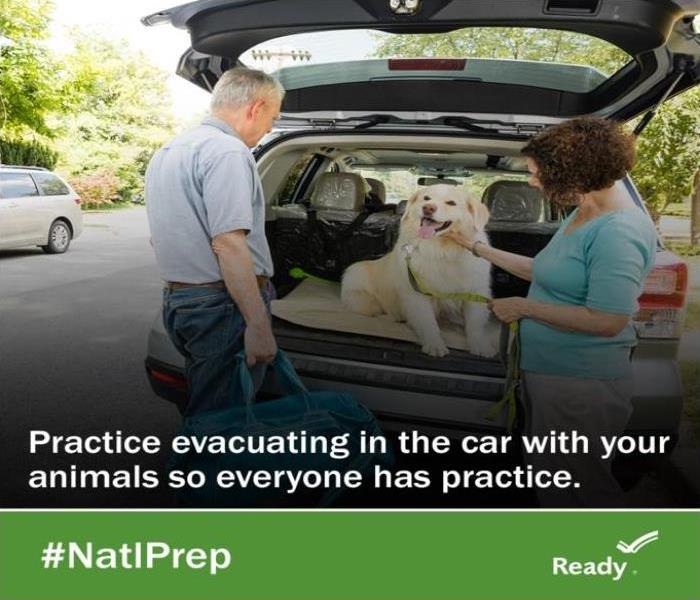 Remember, during a disaster what’s good for you is good for your pet, get them ready today. If you leave your pets behind, they may be lost/injured.
Remember, during a disaster what’s good for you is good for your pet, get them ready today. If you leave your pets behind, they may be lost/injured.
National Preparedness Month is recognized each September to promote family and community disaster and emergency planning now and throughout the year. The 2019 theme is "Prepared, Not Scared."
Today, we have the ability to predict with more accuracy than ever dangerous tornadoes, hurricanes, winter storms, and floods. We know the areas that are prone to earthquakes and areas that are susceptible to wildfires, and we can tell hours in advance whether a tsunami will hit our shores.
However, in spite of all the capabilities for advance warnings, we are still not quite up to speed at preparing for these disasters. Many really believe that it can’t happen to us.
Some simple, quick preparations could make the difference between life and death for your family. Here are several steps you can take to be ready for a disaster from our friends at Ready.gov.
What You Should Know About Life Saving Skills
- Know basic preparedness skills to protect your family and home.
- Eliminate common electrical and fire hazards around your house and property.
- Install smoke, carbon monoxide, and natural gas alarms and test them monthly.
- Teach children what to do when they hear smoke, carbon monoxide, and natural gas alarms.
- Place natural gas detectors on every level of your home and test them monthly.
- Know how to turn off utilities like natural gas in your home.
- Talk to your landlord or building manager about evacuation routes and fire safety.
- Develop and practice a family communication plan and discuss it with your family.
- Have emergency supplies in place at home, at work, and in the car.
- Pay attention to alerts and warnings.
- Know two ways out of your home in the event of a fire and practice evacuation plans.
- Set some money aside from your income in case of an emergency.
Safety Skills
Learn First Aid & CPR
Take a first aid and CPR class. Local American Red Cross chapters can provide information about this type of training. Official certification by the American Red Cross provides, under the “good Samaritan” law, protection for those giving first aid.
Get more information about the supplies in a first aid kit.
Learn to Use a Fire Extinguisher
Make sure you have one or more up-to-date fire extinguisher and be sure everyone knows where they are kept and how to use them. You should have, at a minimum, an ABC type.
The U.S. Fire Administration recommends that only those trained in the proper use and maintenance of fire extinguishers consider using them when appropriate. Contact your local fire department for information on training in your area. Get more information about preparedness for a fire emergency.
Know how to shut-off Utilities
Natural Gas
Natural gas leaks and explosions are responsible for a significant number of fires following disasters. It is vital that all household members know how to shut off natural gas.
Because there are different gas shut-off procedures for different gas meter configurations, it is important to contact your local gas company for any guidance on preparations and response regarding gas appliances and gas service to your home.
When you learn the proper shut-off procedure for your meter, share the information with everyone in your household. Be sure not to actually turn off the gas when practicing the proper gas shut-off procedures.
- If you smell gas or hear a blowing or hissing noise, open a window and get everyone out quickly. Turn off the gas, using the outside main valve, if you can, and call the gas company from a neighbor’s home.
- Caution: If you turn off the gas for any reason, a qualified professional must turn it back on. NEVER attempt to turn the gas back on yourself.
Water
Water quickly becomes a precious resource following many disasters. It is vital that all household members learn how to shut off the water at the main house valve.
- Before an emergency happens, locate the shut-off valve for the water line that enters your house and label this valve with a tag for easy identification. Make sure all household members know where it is located.
- Make sure this valve can be completely shut off. Your valve may be rusted open or it may only partially close. If so, replace it.
- Cracked lines may pollute the water supply to your house. It is wise to shut off your water until you hear from authorities that it is safe for drinking.
The effects of gravity may drain the water in your hot water heater and toilet tanks unless you trap it in your house by shutting off the main house valve. (This is not the street valve in the cement box at the curb – the street valve is extremely difficult to turn and requires a special tool.)
Electricity
Electrical sparks have the potential of igniting natural gas if it is leaking. It is wise to teach all responsible household members where and how to shut off the electricity.
- Locate you electrical circuit box. For your safety, always shut off all the individual circuits before shutting off the main circuit.
Evacuation
Plan to Evacuate
A wide variety of emergencies may cause an evacuation. In some instances you may have a day or two to prepare, while other situations might call for an immediate evacuation. Planning ahead is vital to ensuring that you can evacuate quickly and safely, no matter what the circumstances.
Before an Evacuation
- Learn the types of disasters that are likely in your community and the local emergency, evacuation, and shelter plans for each specific disaster.
- Plan how you will leave and where you will go if you are advised to evacuate.
- Identify several places you could go in an emergency such as a friend’s home in another town or a motel. Choose destinations in different directions so that you have options during an emergency.
- If needed, identify a place to stay that will accept pets. Most public shelters allow only service animals.
- Be familiar with alternate routes and other means of transportation out of your area.
- Always follow the instructions of local officials and remember that your evacuation route may be on foot depending on the type of disaster.
- Develop a family/household communication and re-unification plan so that you can maintain contact and take the best actions for each of you and re-unite if you are separated.
- Assemble supplies that are ready for evacuation, both a “go-bag” you can carry when you evacuate on foot or public transportation and supplies for traveling by longer distances if you have a personal vehicle.
- If you have a car:
- Keep a full tank of gas in it if an evacuation seems likely. Keep a half tank of gas in it at all times in case of an unexpected need to evacuate. Gas stations may be closed during emergencies and unable to pump gas during power outages. Plan to take one car per family to reduce congestion and delay.
- Make sure you have a portable emergency kit in the car.
- If you do not have a car, plan how you will leave if needed. Make arrangements with family, friends or your local government.
During an Evacuation
- A list of open shelters can be found during an active disaster in your local area by downloading the FEMA app
- Listen to a battery-powered radio and follow local evacuation instructions.
- Take your emergency supply kit.
- Leave early enough to avoid being trapped by severe weather.
- Take your pets with you, but understand that only service animals may be permitted in public shelters. Plan how you will care for your pets in an emergency now.
- If time allows:
- Call or email the out-of-state contact in your family communications plan. Tell them where you are going.
- Secure your home by closing and locking doors and windows.
- Unplug electrical equipment such as radios, televisions and small appliances. Leave freezers and refrigerators plugged in unless there is a risk of flooding. If there is damage to your home and you are instructed to do so, shut off water, gas and electricity before leaving.
- Leave a note telling others when you left and where you are going.
- Wear sturdy shoes and clothing that provides some protection such as long pants, long-sleeved shirts and a hat.
- Check with neighbors who may need a ride.
- Follow recommended evacuation routes. Do not take shortcuts; they may be blocked.
- Be alert for road hazards such as washed-out roads or bridges and downed power lines. Do not drive into flooded areas.
After an Evacuation
If you evacuated for the storm, check with local officials both where you’re staying and back home before you travel.
- Residents returning to disaster-affected areas after significant events should expect and prepare for disruptions to daily activities, and remember that returning home before storm debris is cleared is dangerous.
- Let friends and family know before you leave and when you arrive.
- Charge devices and consider getting back-up batteries in case power-outages continue.
- Fill up your gas tank and consider downloading a fuel app to check for outages along your route.
- Bring supplies such as water and non-perishable food for the car ride.
- Avoid downed power or utility lines; they may be live with deadly voltage.
- Stay away and report them immediately to your power or utility company.
- Only use generators away from your home and NEVER run a generator inside a home or garage, or connect it to your home's electrical system.
SERVPRO of West Riverside City encourages our neighbors to take steps to plan for a disaster, "Be Prepared not Scared" should a natural disaster take place in our Riverside City. Add our contact information to your emergency list. We can help ease the stress should you face a loss due to a disaster. We can make it "Like it never even happened."
SERVPRO of West Riverside City
Contact number: 951-351-8033
Website: https://www.SERVPROwestriversidecity.com/
Google: https://SERVPRO-west-riverside.business.site
Yelp: https://www.yelp.com/biz/SERVPRO-of-west-riverside-city-riverside-4
Why Your Riverside Business Should Have an ERP
8/12/2019 (Permalink)
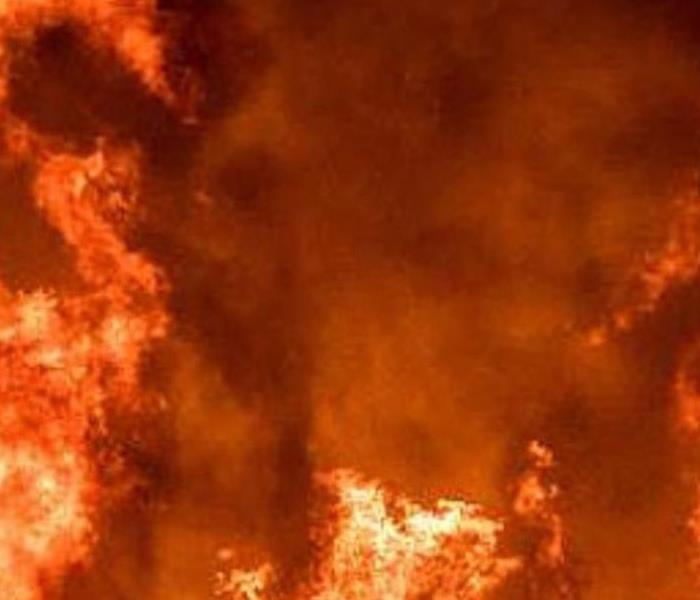 SERVPRO can expertly help you devise an effective Emergency Readiness Plan for your business in the West Riverside area.
SERVPRO can expertly help you devise an effective Emergency Readiness Plan for your business in the West Riverside area.
Benjamin Franklin wisely said, “By failing to prepare, you are preparing to fail.” It’s advice that can easily apply to a business. Water damage, fire damage, storm damage and other disasters can ravage corporations. A staggering 50 percent of these companies are too crippled to reopen. So how are the other 50 percent able to rebound? They have a readiness plan.
An ERP (Emergency Readiness Plan) is a method of planning for emergencies long before they occur. It’s a carefully devised, well-rehearsed strategy that guides you and your employees to take decisive action during a catastrophe. Here are some things to consider while putting your ERP into place:
PONDER THE WORST CASE SCENARIOS
Encourage your employees to formulate as many disaster scenarios as they can. One of the worst fires occurred in November 2018 with the Woolsey Fire and Camp Fire. Studying such tragedies can help you more effectively plot possible situations.
DETERMINE PROTECTIVE ACTIONS
It is necessary to create an ERP that protects anyone in the building. The Department of Homeland Security refers to this as “Protective Actions for Life Safety,” including:
- Fire Drills -- Rehearsals for action during a fire.
- Sheltering -- Sheltering staff during a natural disaster.
- Sheltering in Place -- Sheltering staff during a man-made emergency.
- Lockdown -- Eluding an active shooter.
LEARN HOW TO STABILIZE THE INCIDENT
Stabilizing an incident means preventing further damage on the scene. This can be accomplished by training your employees in various rescue procedures including:
- First Aid and CPR
- Proper Use of Fire Extinguishers
TRAIN AN EVACUATION TEAM
Without guidance during an evacuation, people may blindly panic. Consider adding an evacuation team to your ERP:
- Assign employees to guide evacuees out of the building.
- Appoint helpers to assist persons with disabilities.
- If an exit is blocked by a hazard such as a collapsed ceiling, make sure the evacuation team is trained to redirect employees to an alternate exit.
SERVPRO of West Riverside City, is a fast, reliable, proactive provider of emergency cleaning and restoration services for fire and water damage. SERVPRO can expertly help you devise an effective Emergency Readiness Plan for your business in the West Riverside area.
The SERVPRO Ready Plan information will give you the security of emergency preparedness. The information can be downloaded into the Ready Plan app to instantly share with SERVPRO, so that the damage can be intercepted. We’ll make it “like it never happened.”
Here is some good information from our friends at Ready.Gov
Prepare NOW
Sign up for your community’s warning system. The Emergency Alert System (EAS) and National Oceanic and Atmospheric Administration (NOAA) Weather Radio also provide emergency alerts.Know your community’s evacuation plans and find several ways to leave the area. Drive the evacuation routes and find shelter locations. Have a plan for pets and livestock.Gather emergency supplies, including N95 respirator masks that filter out particles in the air you breathe. Keep in mind each person’s specific needs, including and updated asthma action plan and medication. Don’t forget the needs of pets.Designate a room that can be closed off from outside air. Close all doors and windows. Set up a portable air cleaner to keep indoor pollution levels low when smoky conditions exist.Keep important documents in a fireproof, safe place. Create password-protected digital copies.Use fire-resistant materials to build, renovate, or make repairs.Find an outdoor water source with a hose that can reach any area of your property.Create a fire-resistant zone that is free of leaves, debris, or flammable materials for at least 30 feet from your home.Review insurance coverage to make sure it is enough to replace your property.Pay attention to air quality alerts.Survive DURING
Evacuate immediately if authorities tell you to do so.If trapped, then call 911 and give your location, but be aware that emergency response could be delayed or impossible. Turn on lights to help rescuers find you.Listen to EAS, NOAA Weather Radio, or local alerting systems for current emergency information and instructions.Use an N95 masks to keep harmful particles out of the air you breathe.If you are not ordered to evacuate but smoky conditions exist, stay inside in a safe location or go to a community building where smoke levels are lower.Be Safe AFTER
Listen to authorities to find out when it is safe to return, and whether water is safe to drink.Avoid hot ash, charred trees, smoldering debris, and live embers. The ground may contain heat pockets that can burn you or spark another fire. Consider the danger to pets and livestock.Send text messages or use social media to reach out to family and friends. Phone systems are often busy following a disaster. Make calls only in emergencies.Wear a NIOSH certified-respirator dust mask and wet debris down to minimize breathing dust particles.Document property damage with photographs. Conduct an inventory and contact your insurance company for assistance.Wildfires dramatically change landscape and ground conditions, which can lead to increased risk of flooding due to heavy rains, flash flooding and mudflows. Flood risk remains significantly higher until vegetation is restored—up to 5 years after a wildfire. Consider purchasing flood insurance to protect the life you've built and to assure financial protection from future flooding.
Lighting Fireworks in Riverside is Illegal this 4th of July Holiday
7/1/2019 (Permalink)
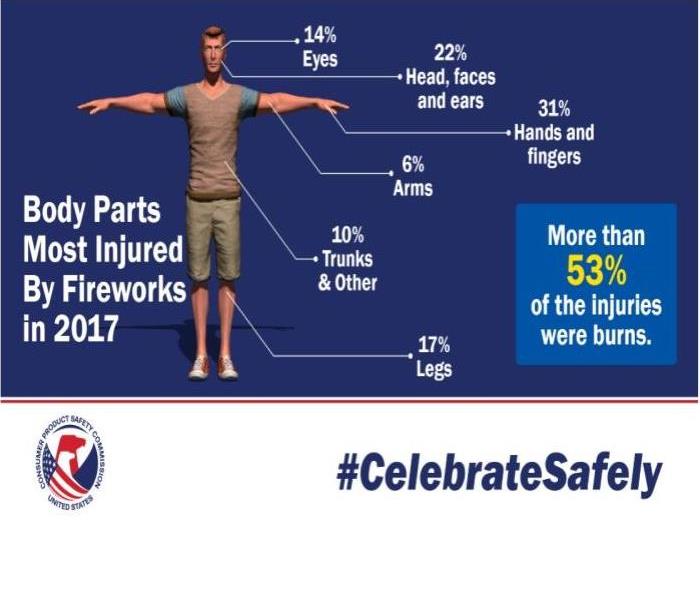 From our friends at CPSC: Fireworks are synonymous with our celebration of Independence Day. Yet, the thrill of fireworks can also bring pain.
From our friends at CPSC: Fireworks are synonymous with our celebration of Independence Day. Yet, the thrill of fireworks can also bring pain.
Residents are urged to attend free July 4 fireworks shows at Mount Rubidoux or La Sierra Park.
It’s that time of year again! Outdoor barbecues, cook-outs, summer beach vacations, and of course, fireworks! Whether you’re celebrating in your red, white and blue this weekend, or just enjoying a little backyard BBQ, knowing the laws of fireworks in your area is really important.
ALL fireworks, including sparklers, are illegal in Riverside County. All fireworks are illegal because they cause serious injuries and very often, cause fires. Riverside County has very diverse terrain. The vegetation is very dry where fireworks can easily start a brush fire. Individuals who cause fires by using illegal fireworks will be held responsible for all suppression costs. These costs can run into the millions of dollars. Read more at the State Fire Marshal website.
Residents are urged to attend free July 4 fireworks shows at Mount Rubidoux or La Sierra Park. Leaders warn ahead of July 4th, you can be fined $1,000.
4th of July Fireworks Displays in Riverside and Neighboring Counties
Many cities and communities in or near Riverside County provide spectacular fireworks displays for their residents. The operators of these displays are licensed and have permits issued by the State Fire Marshal.
Since all fireworks are illegal in Riverside County - Let the experts entertain your family at one of these events throughout the South-land:
RIVERSIDE: Fireworks at Mt. Rubidoux and La Sierra Park: Riverside
RIVERSIDE: July 4th Fireworks, Family Fest: Evergreen Memorial Historic Cemetery, Riverside
From our Friends at the U.S. Consumer Product Safety Commission
Remember, fireworks can be dangerous, causing serious burn and eye injuries. You can help us prevent fireworks-related injuries and deaths. How? By working with a national, state or local organization where you live to promote fireworks safety in your community.
Follow these safety tips when using fireworks in an area that allows fireworks:
- Never allow young children to play with or ignite fireworks.
- Avoid buying fireworks that are packaged in brown paper because this is often a sign that the fireworks were made for professional displays and that they could pose a danger to consumers.
- Always have an adult supervise fireworks activities. Parents don't realize that young children suffer injuries from sparklers. Sparklers burn at temperatures of about 2,000 degrees - hot enough to melt some metals.
- Never place any part of your body directly over a fireworks device when lighting the fuse. Back up to a safe distance immediately after lighting fireworks.
- Never try to re-light or pick up fireworks that have not ignited fully.
- Never point or throw fireworks at another person.
- Keep a bucket of water or a garden hose handy in case of fire or other mishap.
- Light fireworks one at a time, then move back quickly.
- Never carry fireworks in a pocket or shoot them off in metal or glass containers.
- After fireworks complete their burning, douse the spent device with plenty of water from a bucket or hose before discarding it to prevent a trash fire.
- Make sure fireworks are legal
The safest way to enjoy fireworks is to attend a public fireworks display put on by professionals. Those caught with illegal fireworks will be subject to fines, citation and/or arrest; including confiscation of all illegal fireworks. We urge you to leave the fireworks to the professionals!
Help Is Here
The team at SERVPRO of West Riverside City has specialized training and experience in fire restoration services, natural disaster prevention, water damage, chemical cleanup, and natural disaster cleanup.
Remember, you know who to call when disaster strikes! SERVPRO of West Riverside City 951-351-8033
Summer is Here, Enjoy Summer Safely in Riverside!
6/26/2019 (Permalink)
Please review a few tips that can help ensure you have a safe enjoyable summer.
Although we have already enjoyed several warm days here in Riverside, the official first day of summer is June 21th, 2019. Please review a few tips that can help ensure you have a safe enjoyable summer.
Your Home
As we pack away winter coats there are some things you can do to prepare your home for the season:
- Clean your refrigerator coils
- Change your air-conditioning filters
- Ensure your condensation line is clear of clogs and operating normally
- Inspect your driveway for any potential repairs needed
- Let out heat from the attic –high temperatures are a regular cause of mold
- Open windows to reduce moisture in your home
- Install screen doors; ensure the screens are in good condition
- Install reflective/tinted windows-this will protect your furnishing and reduce cooling costs!
- Add plants to your home-plants reduce toxins in the home and even offer health benefits!
- Secure your hose a safe distance from home, slow leaks has caused floods
- Inspect pool for any damage that may have occurred throughout the winter season
Water Activities
With temperatures rising in Riverside, this means a lot of us are all gearing up to take part in water activities and swimming!
We thought we would share some top water safety tips for you to remember before you jump in the water!
- Swim with a buddy. If possible, this is always the safest route no matter where you might be swimming.
- Parents, always watch your kids while they are in the pool. Disasters can happen so fast!
- Have a life jacket and first aid kit on hand. Getting in the habit of taking these things with you to swimming activities can be helpful.
For more great water safety tips, visit the American Red Cross website.
Grilling, Fire Pits, and Fire Works
There is nothing like firing up the grill during the summer months! Did you know, summertime is the season for grill fires? A backyard barbecue can become dangerous quickly if proper safety precautions aren’t considered. Consider the following tips to help ensure your summer celebrations are disaster-free!
Bar B Q Fire Safety
- Propane and charcoal BBQ grills should only be used outdoors.
- Keep a 3 foot area clear on all sides of the grill...kids and pets, too!
- The grill should be placed well away from the home, deck railings and out from under eaves and overhanging branches.
- Keep your grill clean by removing grease or fat buildup from the grills and in trays below the grill.
- Never leave your grill unattended.
- When using a charcoal grill, let the coals completely cool before disposing in a metal container.
- When disposing of any coals, please make sure you use a metal container and a lid, without anything piled on top of the lid!
Don't you just love a fire pit?
- Make sure your fire pit has a cover. It may be needed to extinguish the fire quickly and easily in the event of an emergency.
- Look around the fire pit before lighting it. Make sure there is nothing easily flammable near it...piles of dried leaves, firewood, tiki torches and/or their fluid.
- Watch out for what you are adding to your fire pit. Leaves, paper, magazines or cardboard can separate and send large fire filled pieces into the air, causing a fire elsewhere!
- Not a bad idea to have a fire extinguisher and/or a hose with the water turned on, handy.
Fire Works
It’s firework season! According to the National Fire Protection Association (NFPA), an average of 18,500 fires are started every year by fireworks. This includes 1,300 structure fires, 300 vehicle fires, and 16,900 outside and other fires. “These fires caused an average of three deaths, 40 civilian injuries, and an average of $43 million in direct property damage,” says the NFPA.
Do you think sparklers are the safe way to go? Nope: they account for about a fourth of emergency room fireworks injuries.
Stay safe this summer by paying close attention to children at fireworks events, and avoiding the use of consumer fireworks.
- Anyone using fireworks or standing nearby should wear protective eye-wear.
- Do not try to re-light or handle malfunctioning fireworks. Keep a bucket of water nearby to fully extinguish fireworks that don’t go off or in case of fire.
- Children should never pick up fireworks that may be left over as they may still be active.
- The safest way to enjoy fireworks is to attend a public display conducted by trained professionals.
Wishing you and your family a wonderful summer from SERVPRO of West Riverside City and please be safe!
If fire does damage your home or business this summer, give us a call at 951-351-8033. SERVPRO of West Riverside City will make it "Like it never even happened."
The Dangers of Hoarding and How you Can Help
5/27/2019 (Permalink)
Chances are you’ve seen the television show Hoarders. If you haven’t, the basic premise is that a psychologist, a professional organizer, and cleaners go into an individual’s home and help clean up their hoard. When help arrives, the person in question is met with a deadline of some sort, whether it’s eviction, child protective services coming, adult protective services coming, or animal welfare coming and removing their children/themselves/their pets from the home. This show is fascinating to us because we can’t imagine anyone ever living like that. Unfortunately, it’s estimated that at least 2-6 percent of the population is affected by a hoarding disorder. The average age for hoarding is around 50, though it’s suggested that hoarding can appear as early as 11 to 15 years of age.
Hoarding can cause a mess of a problems. Not only does it cause strain on relationships and mental health, it can cause an unhealthy living environment as well. Mold and mildew can become present under piles of things, especially with an unknown water leak. Piles of stuff could topple and seriously injure or even kill the individual(s) living in the home. However, one of the biggest safety concerns relating to hoarding is fire.
The possibility of a fire in a home when hoarding is involved. Cooking becomes unsafe because of items piled high on counter tops or on the floor. If the individual in the home uses a heater, the heater could easily fall over and start a fire, or a pest could chew on electrical wiring.
Hoarding also hinders first responders. If exits or doors are blocked, then they can’t get in the home to help the person in need. They won’t be able to move through the home in a swift manner and can even be trapped or injured by falling objects.
When it comes to cleaning out the home, approach the situation with compassion and understanding. While some items in the home maybe trash to you, they could be valued possessions to a hoarder. Hoarding is related oftentimes to obsessive compulsive disorder (OCD) and anxiety. It can even be genetic.
If family or friends come in to help clear a hoarder’s home, it’s usually met with great distress because often times they don’t get to choose what or what not to keep. If not dealt with in the proper way, within a few months a home could be packed to the brim again.
So, what do you do if your loved one is a hoarder? How do you approach the situation? Here are four tips to get you started on helping your loved one.
Seek Professional Help – Try and find a therapist that specializes in hoarding, OCD or anxiety. They will help the individual understand how hoarding is affecting their life and how to develop healthy habits and abilities to combat it. However, make sure they are ready to make these changes. Don’t force them into seeking help if they aren’t ready.Talk About Safety – Stress safety. They maybe more open to change if you express your concern for their well being and safety in a hoarded home.Celebrate the Small Victories – Help the individual by setting small goals. Even if they take five hours to sort through and throw away a box, celebrate it! It’ll help them feel proud of what they’ve accomplished.Hoards Can Have Bio-hazards – Hoarding situations oftentimes have bio-hazards such as animal and human waste, or animal remains. You can call SERVPRO of West Riverside City to help handle anything bio-hazardous.Our team works compassionately with the home owner and his or her loved ones to clean and sanitize the scene, while health and/or mental health professionals tend to the affected person.
It is our motto to always be there to help, day or night, we’ll be there. Just contact us and our professional staff can assist you with any questions. Just give us a call: 951.351.8033.
Part II NIOSH Warns of Hazards during Cleanup Work Following Forest Fires
3/27/2019 (Permalink)
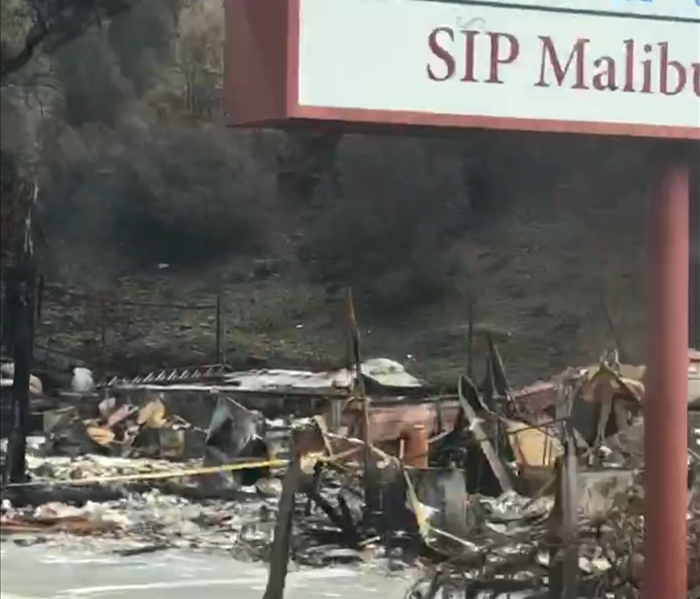 Woolsey fire destroyed many homes and businesses.
Woolsey fire destroyed many homes and businesses.
The National Institute for Occupational Safety and Health (NIOSH) warns workers and volunteers of the potential dangers involved with cleanup operations following the devastation caused by forest fires.
Because the level of experience varies among these workers, cleanup crews must work together and look out for one another to ensure safety.
NIOSH urgently requests your assistance in disseminating the following warnings to all those involved in cleanup work following forest fires. The potential work-related hazards listed here are described below in greater detail: Confined Spaces, Power Line Hazards, Agricultural Hazards, Stress and Fatigue. Additional key resources on health and safety hazards related to fire fighting can be found on the NIOSH web site under the “spotlights” section titled “Fighting Wildfires” (http://www.cdc.gov/niosh/topics/firefighting/).
PREVENTION MEASURES
First Aid
First aid, even for minor cuts and burns, is extremely important. Immediately clean out all open wounds and cuts with soap and clean water. Most cuts, except minor scratches, sustained during cleanup activities will warrant treatment to prevent tetanus. If you are injured, contact a physician to determine the necessary type of treatment.
Protective Equipment
For most clean-up work activities, you will need the following personal protective equipment: hard hats, safety goggles, heavy work gloves, and watertight boots with steel toe and insole (not just steel shank). For information on what equipment you need for protection, contact your local OSHA office or NIOSH.
Excessive noise from equipment such as chain saws, backhoes, tractors, pavement breakers, blowers, and from heavy equipment (e.g., earth moving equipment, helicopters) may cause ringing in the ears and subsequent hearing damage. If working with any noise that you must shout over to be heard, you should wear earplugs or other hearing protection devices.
Working in Confined Spaces
If you are required to work in a boiler, furnace, pipeline, pit, pumping station, septic tank, sewage digester, storage tank, utility vault, well, silo, or similar enclosed structures, you should be aware of the hazards of working in confined spaces. A confined space has one or more of the following characteristics:
- limited openings for entry or exit;
- unfavorable natural ventilation; or
- is not designed for continuous worker occupancy.
Toxic gases, a lack of oxygen, or explosive conditions may exist in the confined area, resulting in a potentially deadly atmosphere. Because many toxic gases and vapors cannot be seen or smelled, never trust your senses to determine if safe entry is possible. Never enter a confined space unless you have been properly trained, even to rescue a fellow worker! If you need to enter a confined space and do not have the proper training and equipment, contact your local fire department for assistance.
Working On or Near Power Lines [Recommendations for Utility Workers ONLY]
Several workers have died of electrocution following natural disasters. Workers and employers must take extreme caution while attempting to restore power or clear areas near downed power lines. In one instance, a worker lost his life while removing trees from a de-energized power line that had been knocked down by a storm. While inspecting the completed work, the man stepped on the line and was electrocuted by "feedback" energy from a portable backup generator at a nearby gas station. Feedback energy occurs when a de-energized line becomes energized by a secondary power source.
Another worker died cleaning branches from a power line, following a storm. He was electrocuted after falling from a tree onto a line thought to be de-energized. Although the workers had opened a fused switch on a transformer, the line remained energized through another transformer.
If you are working on or near power lines, the following steps may save your life:
- Treat all power lines as energized until you have followed the required procedures for personally de-energizing and testing them with an appropriate testing device. Do not rely on "fuzzing" to determine if a power line has been de-energized.
- Verifying that a line is not energized may not ensure your safety. You must also ground lines on both the load and supply sides of the work area. Grounding is necessary to protect you from the hazards of feedback electrical energy from a secondary power source, such as a portable generator.
- When restoring power in underground vaults, added precautions are necessary to avoid explosion hazards. As vaults containing electrical connections are drained or pumped out, and energized, potentially explosive gases may form. If you are required to work in a utility vault, refer to the Confined Spaces section of this Fact Sheet.
RESPIRATORY HAZARDS
If you are involved in cleanup efforts you may be exposed to ash, soot and fire decomposition products that may cause irritation and other respiratory effects. Spoiled and/or wet vegetation and other organic/agricultural materials often grow large amounts of bacteria and mold during warm weather. Breathing these organisms and the organic dust produced may cause lung disease. Use proper engineering controls to exhaust and replenish adequate fresh air if working indoors. A high efficiency particulate air (HEPA)-type vacuum is recommended when cleaning surfaces contaminated with dust. The use of a typical household vacuum should be avoided since it will re-suspend the collected dust into the air. When exposure to dusts cannot be controlled or avoided, exposure can be reduced by routine use of a well-fitted NIOSH-certified air-purifying respirator (such as an N-95 or more protective respirator).
STRESS, LONG HOURS, AND FATIGUE MAY INCREASE THE RISKS FOR INJURY AND ILLNESS
Continued long hours of work, combined with emotional and physical exhaustion and losses from damaged homes and temporary job layoffs, can create a highly stressful situation for cleanup workers. Workers exposed to these stressful conditions have an increased risk of injury and emotional crisis, and are more vulnerable to stress-induced illnesses and disease. Emotional support from family members, neighbors, and local mental health professionals can help to prevent more serious stress-related problems in the difficult months ahead. People working in all phases of cleanup work can reduce their risks of injury and illness in several ways:
- Set priorities for cleanup tasks and pace the work over several days (or weeks). Avoid physical exhaustion.
- Resume a normal sleep schedule as quickly as possible. Get plenty of rest and take frequent rest breaks BEFORE exhaustion builds up.
- Take advantage of disaster relief programs and services in your community.
- Be alert to emotional exhaustion or strain. When family members and neighbors are unavailable for emotional support, consult professionals at community health and mental health centers.
For more information about these or other occupational safety and health topics contact NIOSH at:
1-800-35-NIOSH (1-800-356-4674)
Fax: 513: 533-8573
E-mail: pubstaft@cdc.gov
www.cdc.gov/niosh
Part 1-Warnings from The National Institute for Occupational Safety and Health (NIOSH)
3/25/2019 (Permalink)
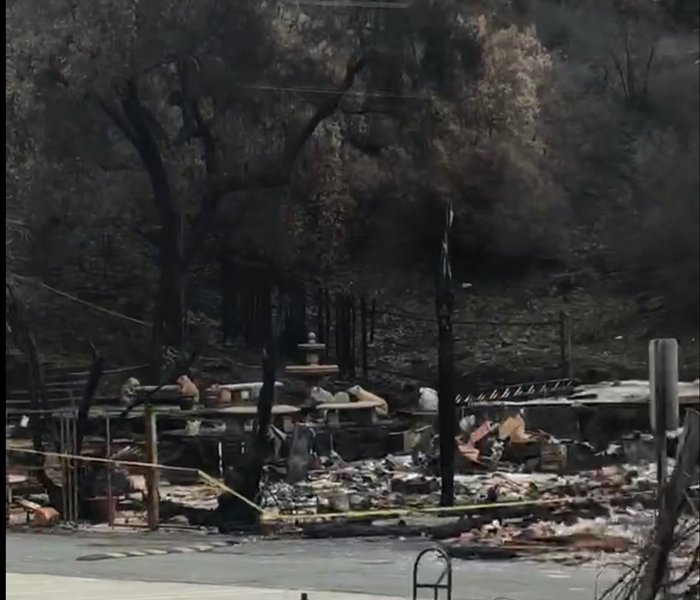 Woolsey fire devastation
Woolsey fire devastation
NIOSH warns workers and volunteers of the potential dangers involved with cleanup operations following the devastation caused by forest fires.
Because the level of experience varies among these workers, cleanup crews must work together and look out for one another to ensure safety.
NIOSH urgently requests your assistance in disseminating the following warnings to all those involved in cleanup work following forest fires.
The potential work-related hazards listed here are described below in greater detail: Fire, Electrical Hazards, Carbon Monoxide, Musculoskeletal Hazards, Thermal Stresses, Heavy Equipment, Structural Instability, Hazardous Materials, Confined Spaces, Power Line Hazards, Agricultural Hazards, Stress and Fatigue. Additional key resources on health and safety hazards related to fire fighting can be found on the NIOSH web site under the “spotlights” section titled “Fighting Wildfires” (http://www.cdc.gov/niosh/topics/firefighting/).
General Considerations
Before cleanup operations are initiated, local and State government emergency policies and guidelines should be checked to determine if any restrictions exist (e.g., water use, discharge of waste water, disposal of debris).
POTENTIAL DANGERS INVOLVED IN CLEANUP OPERATIONS
Fire
Heat sources may remain as a result of smoldering wood or other debris that could reignite if contact is made with a combustible material or if oxygen becomes available. Workers and employers must therefore take extra precautions. At least two fire extinguishers, each with a UL rating of at least 10A, should be provided at every cleanup activity.
Electrical Hazards
NIOSH has investigated several work-related electrocution deaths following natural disasters. To prevent future electrocutions, NIOSH urges those involved in cleanup activities to take the following steps:
- If water has been present anywhere near electrical circuits and electrical equipment, turn off the power at the main breaker or fuse on the service panel. Do not turn the power back on until electrical equipment has been inspected by a qualified electrician. Never enter flooded areas or touch electrical equipment if the ground is wet, unless you are certain that the power is off. NEVER handle a downed power line. No not use electrical equipment that has been exposed to heat from the fire until checked by an electrician.
- When using gasoline and diesel generators to supply power to a building, switch the main breaker or fuse on the building service panel to the "off" position prior to starting the generator. This will prevent inadvertent energization of power lines from backfeed electrical energy from the generators, and help to protect utility line workers from possible electrocution.
- If clearing or other work must be performed near a downed power line, contact the utility company to discuss de-energizing and grounding or shielding of power lines; maintain a safe distance from the power lines until they have been deenergized. Extreme caution is necessary when moving ladders and other equipment near overhead power lines to avoid inadvertent contact. If you are working on or near power lines, refer to the additional recommendations provided in that section below. Be aware of possible fire damage to poles and other structures carrying overhead power lines.
Unstable Work Surfaces
Cleanup activities may involve walking on unstable surfaces such as construction debris, trees and other vegetation. Piles of debris and other unstable work surfaces create a risk for traumatic injury from slips, falls, puncture wounds from nails and sharp objects, and collapsing materials. Extreme caution is necessary when working on these surfaces. Protective equipment, such as hard hats, safety glasses, leather gloves, and steel toe boots should be considered to minimize the risk of injury.
Carbon Monoxide
Cleanup activities may involve the use of gasoline- or diesel-powered pumps, generators, and pressure washers. Because these devices release carbon monoxide, a deadly, colorless, odorless gas, operate all gasoline-powered devices outdoors and never bring them indoors. It is virtually impossible to assess adequate ventilation. NIOSH has investigated several carbon monoxide poisoning deaths in the past caused by the use of gasoline-powered engines indoors or in confined spaces. Be aware that high levels of carbon monoxide may occur in confined spaces from the fires.
Musculoskeletal Hazards
Cleanup workers are at risk for developing serious musculoskeletal injuries to the hands, back, knees, and shoulders. Special attention is needed to avoid back injuries associated with manual lifting and handling of debris and building materials. To help prevent injury, use teams of two or more to move bulky objects, avoid lifting any material that weighs more than 50 pounds (per person), and use proper automated-assist lifting devices.
Thermal Stresses
Heat: Cleanup workers are at serious risk for developing heat stress. Excessive exposure to hot environments can cause a variety of heat-related problems, including heat stroke, heat exhaustion, heat cramps, and fainting. To reduce the potential for heat stress, drink a glass of fluid every 15 to 20 minutes and wear light-colored, loose- fitting clothing. Additionally, incorporate work-rest cycles into work routines, work during the cooler hours of the day, when possible, or distribute the workload evenly throughout the day. When air conditioning is unavailable, open windows and use fans.
Cold: If standing water is present from fire fighting be aware that working in water which is cooler than 75 degrees F (24 degrees C) will remove body heat more rapidly than it can be replaced, resulting in hypothermia. To reduce the risk of hypothermia, wear high rubber boots, ensure that clothing and boots have adequate insulation, avoid working alone, take frequent breaks out of the water, and change into dry clothing when possible.
Heavy Equipment
Only those properly trained should operate heavy equipment such as bulldozers, backhoes, and tractors. If you are operating this type of equipment, make sure you turn it off and block it against motion when not in use. Operators should be aware of the activities around them to protect other workers on foot from being struck by moving equipment. Heavy equipment operators should not exceed the load capacity of cranes and other lifting equipment and ensure that workers do not walk under areas where cranes and other heavy equipment are being used to lift objects.
Structural Instability
Fires can rearrange and damage natural walkways, as well as sidewalks, parking lots, roads, and buildings. Never assume that fire-damaged structures or ground are stable. Buildings that have been burned may have suffered structural damage and could be dangerous. Don t work in or around any building damaged by fire until it has been examined and certified as safe for work by a registered professional engineer or architect. Assume all stairs, floors, and roofs are unsafe until they are inspected. Leave immediately if you hear shifting or unusual noises as this may signal a possible collapse.
Hazardous Materials
Fires to commercial and residential buildings and water used to fight the fire can dislodge tanks, drums, pipes, and equipment, which may contain hazardous materials such as pesticides or propane. Containers may be damaged by fire and heat. Do not attempt to move unidentified dislodged containers without first contacting the local fire department or hazardous materials team. If working in potentially contaminated areas, avoid skin contact or inhalation of vapors by wearing appropriate protective clothing and respirators. Contact NIOSH for more information on the proper safety equipment. Frequently and thoroughly wash skin areas that may have been exposed to pesticides and other hazardous chemicals.
Look for Part II in our next Blog.
SERVPRO Cleaning Fire Damage in West Riverside City
3/11/2019 (Permalink)
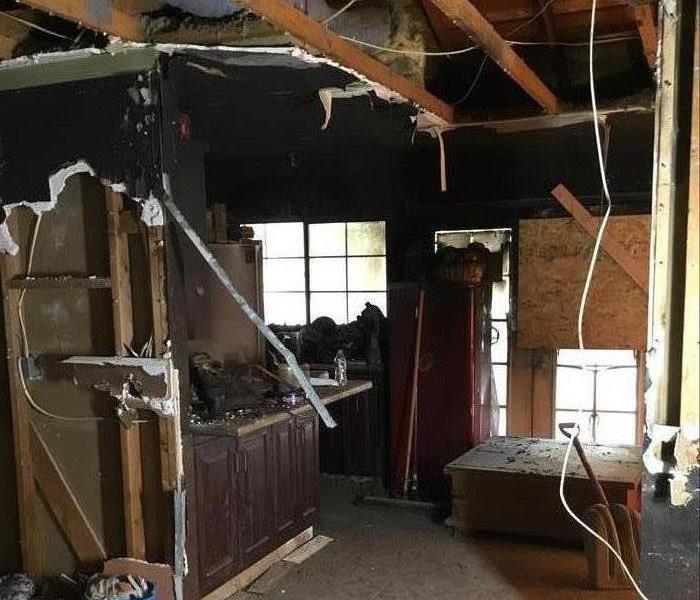 This was the result of a Riverside home fire, SERVPRO provided quality service and care for this customers property.
This was the result of a Riverside home fire, SERVPRO provided quality service and care for this customers property.
SERVPRO Categorizes Fire and Smoke Damage
After a fire, most of the damage to Riverside homes comes from smoke and odor residues that rest on and even penetrate some surfaces like building material and furniture. To fully clean and remove them requires not just experience, but also the right tools.
SERVPRO places fire damage to Riverside homes into three categories: Minor, Medium, and Major. We make this determination for odors and smoke residues depending on how far out they extend from the fire point of origin and how strong the odor or how thick the residue is in each room.
With Minor damage, odors are mild and usually removed with the same cleaning agents we use smoke residues on ceilings, floors, walls, and furniture. The residues themselves are normally light-to-moderate in this category and are limited to only a few rooms. Our technicians can remove all of these with sponges or cloths and hand-spraying a cleaning agent when needed.
Medium damage happens with hotter fires. They produce stronger odors, thicker residues, and spread them throughout more of the home. In this category, a cleaning agent is needed to break up the residues to remove them. Simply cleaning the building material and property does not eliminate all odors in this category, so SERVPRO technicians use an additional deodorizing agent to destroy the odor-causing particles.
To get rid of them, SERVPRO technicians use pressure sprayers and injectors to distribute deodorizing agents. The pressure sprayers are excellent for covering large surfaces such as kitchen walls or living room carpets with either a deodorizer or a cleaning agent. We use the injectors to apply a small amount of deodorizer directly into a small stain in carpets or upholstered furniture.
Major damage occurs close to the fire’s point of origin. Odors are exceptionally strong, and standard deodorizers do not remove all of them. If the fire burned hot enough to cause structural damage, then the smoke residues are exceptionally thick here and spread through the entire home. The level of residue makes removal of building material like drywall cheaper than attempting to clean it. The same may apply to furniture and other personal property due to the extent of the damage or the cost of cleaning.
For heavily covered property, we use an immersion tank to soak and remove the residue in a cleaning agent. We do this only for items not further damaged by soaking. To remove the odors when the usual agents do not work, our technicians bring in an ozone machine. This device generates a gas that oxidizes the odor particles. This gas alters them and removes the odor completely. The drawback to using an ozone machine is we need to evacuate the home of people, pets, and any items made from natural rubber until we finish the procedure.
SERVPRO has the certification and experience to address all levels of fire damage. But what about smoke? Did you know that there are two different types of smoke? Wet and dry.
There are two different types of smoke- wet and dry. As a result, there are different types of soot residue after a fire. Before restoration begins, SERVPRO of West Riverside City will test the soot to determine which type of smoke damage occurred
Smoke and soot is very invasive and can penetrate various cavities within your home, causing hidden damage and odor. Our smoke damage expertise and experience allows us to accurately assess the extent of the damage to develop a comprehensive plan of action.
Wet smoke - Plastic and Rubber
- Low heat, smoldering, pungent odor, sticky, smeary. Smoke webs are more difficult to clean.
Dry Smoke - Paper and Wood
- Fast burning, high temperatures, heat rises therefore smoke rises.
Protein Fire Residue - Produced by evaporation of material rather than from a fire
- Virtually invisible, discolors paints and varnishes, extreme pungent odor.
Our Fire Damage Restoration Services
Since each smoke and fire damage situation is a little different, each one requires a unique solution tailored for the specific conditions. We have the equipment, expertise, and experience to restore your fire and smoke damage. We will also treat your family with empathy and respect and your property with care.
Have questions about Fire, Smoke, or Soot Damage?
Restoring your home after a fire is not a quick process, but SERVPRO of West Riverside City is here with you at each step. If you need our services, call us at (951) 351-8033 today.
There are many companies that you can choose from when it comes to fire restoration in your home. Our crew works to provide the best quality service encompassing the work that we do in your home and our commitment to providing the best in customer consideration. If you experience a fire in your home, trust the team at SERVPRO of West Riverside City to help you get things back to pre-damage condition.
Locally Owned Company with National Resources
Contact SERVPRO of West Riverside City for full-service solutions to emergency situations that may occur on your property, or schedule your home’s initial inspection, today.
Call anytime at (951) 351-8033, were available 24/7 for your emergency needs.
Part II NIOSH Warns of Hazards during Cleanup Work Following Forest Fires
3/7/2019 (Permalink)
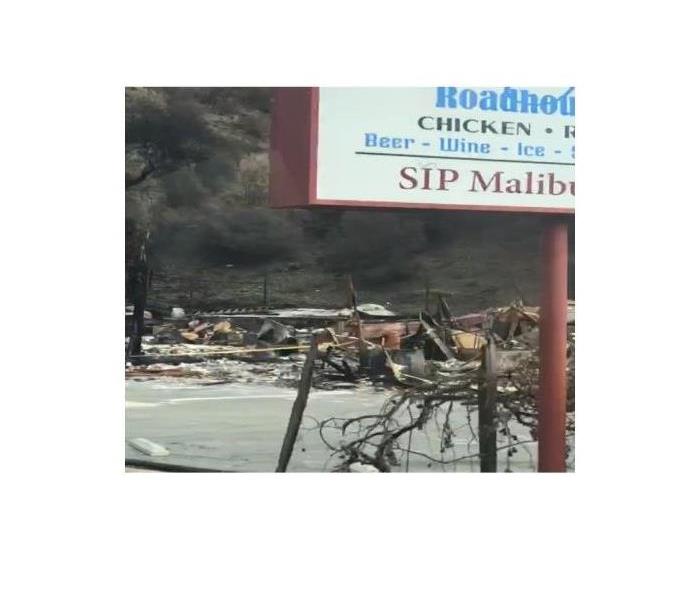 Woolsey fire destroyed many homes and businesses.
Woolsey fire destroyed many homes and businesses.
The National Institute for Occupational Safety and Health (NIOSH) warns workers and volunteers of the potential dangers involved with cleanup operations following the devastation caused by forest fires.
Because the level of experience varies among these workers, cleanup crews must work together and look out for one another to ensure safety.
NIOSH urgently requests your assistance in disseminating the following warnings to all those involved in cleanup work following forest fires. The potential work-related hazards listed here are described below in greater detail: Confined Spaces, Power Line Hazards, Agricultural Hazards, Stress and Fatigue. Additional key resources on health and safety hazards related to fire fighting can be found on the NIOSH web site under the “spotlights” section titled “Fighting Wildfires” (http://www.cdc.gov/niosh/topics/firefighting/).
PREVENTION MEASURES
First Aid
First aid, even for minor cuts and burns, is extremely important. Immediately clean out all open wounds and cuts with soap and clean water. Most cuts, except minor scratches, sustained during cleanup activities will warrant treatment to prevent tetanus. If you are injured, contact a physician to determine the necessary type of treatment.
Protective Equipment
For most clean-up work activities, you will need the following personal protective equipment: hard hats, safety goggles, heavy work gloves, and watertight boots with steel toe and insole (not just steel shank). For information on what equipment you need for protection, contact your local OSHA office or NIOSH.
Excessive noise from equipment such as chain saws, backhoes, tractors, pavement breakers, blowers, and from heavy equipment (e.g., earth moving equipment, helicopters) may cause ringing in the ears and subsequent hearing damage. If working with any noise that you must shout over to be heard, you should wear earplugs or other hearing protection devices.
Working in Confined Spaces
If you are required to work in a boiler, furnace, pipeline, pit, pumping station, septic tank, sewage digester, storage tank, utility vault, well, silo, or similar enclosed structures, you should be aware of the hazards of working in confined spaces. A confined space has one or more of the following characteristics:
- limited openings for entry or exit;
- unfavorable natural ventilation; or
- is not designed for continuous worker occupancy.
Toxic gases, a lack of oxygen, or explosive conditions may exist in the confined area, resulting in a potentially deadly atmosphere. Because many toxic gases and vapors cannot be seen or smelled, never trust your senses to determine if safe entry is possible. Never enter a confined space unless you have been properly trained, even to rescue a fellow worker! If you need to enter a confined space and do not have the proper training and equipment, contact your local fire department for assistance.
Working On or Near Power Lines [Recommendations for Utility Workers ONLY]
Several workers have died of electrocution following natural disasters. Workers and employers must take extreme caution while attempting to restore power or clear areas near downed power lines. In one instance, a worker lost his life while removing trees from a de-energized power line that had been knocked down by a storm. While inspecting the completed work, the man stepped on the line and was electrocuted by "feedback" energy from a portable backup generator at a nearby gas station. Feedback energy occurs when a de-energized line becomes energized by a secondary power source.
Another worker died cleaning branches from a power line, following a storm. He was electrocuted after falling from a tree onto a line thought to be de-energized. Although the workers had opened a fused switch on a transformer, the line remained energized through another transformer.
If you are working on or near power lines, the following steps may save your life:
- Treat all power lines as energized until you have followed the required procedures for personally de-energizing and testing them with an appropriate testing device. Do not rely on "fuzzing" to determine if a power line has been de-energized.
- Verifying that a line is not energized may not ensure your safety. You must also ground lines on both the load and supply sides of the work area. Grounding is necessary to protect you from the hazards of feedback electrical energy from a secondary power source, such as a portable generator.
- When restoring power in underground vaults, added precautions are necessary to avoid explosion hazards. As vaults containing electrical connections are drained or pumped out, and energized, potentially explosive gases may form. If you are required to work in a utility vault, refer to the Confined Spaces section of this Fact Sheet.
RESPIRATORY HAZARDS
If you are involved in cleanup efforts you may be exposed to ash, soot and fire decomposition products that may cause irritation and other respiratory effects. Spoiled and/or wet vegetation and other organic/agricultural materials often grow large amounts of bacteria and mold during warm weather. Breathing these organisms and the organic dust produced may cause lung disease. Use proper engineering controls to exhaust and replenish adequate fresh air if working indoors. A high efficiency particulate air (HEPA)-type vacuum is recommended when cleaning surfaces contaminated with dust. The use of a typical household vacuum should be avoided since it will re-suspend the collected dust into the air. When exposure to dusts cannot be controlled or avoided, exposure can be reduced by routine use of a well-fitted NIOSH-certified air-purifying respirator (such as an N-95 or more protective respirator).
STRESS, LONG HOURS, AND FATIGUE MAY INCREASE THE RISKS FOR INJURY AND ILLNESS
Continued long hours of work, combined with emotional and physical exhaustion and losses from damaged homes and temporary job layoffs, can create a highly stressful situation for cleanup workers. Workers exposed to these stressful conditions have an increased risk of injury and emotional crisis, and are more vulnerable to stress-induced illnesses and disease. Emotional support from family members, neighbors, and local mental health professionals can help to prevent more serious stress-related problems in the difficult months ahead. People working in all phases of cleanup work can reduce their risks of injury and illness in several ways:
- Set priorities for cleanup tasks and pace the work over several days (or weeks). Avoid physical exhaustion.
- Resume a normal sleep schedule as quickly as possible. Get plenty of rest and take frequent rest breaks BEFORE exhaustion builds up.
- Take advantage of disaster relief programs and services in your community.
- Be alert to emotional exhaustion or strain. When family members and neighbors are unavailable for emotional support, consult professionals at community health and mental health centers.
For more information about these or other occupational safety and health topics contact NIOSH at:
1-800-35-NIOSH (1-800-356-4674)
Fax: 513: 533-8573
E-mail: pubstaft@cdc.gov
www.cdc.gov/niosh
Handling Smoke Damage after a Fire in Your Riverside Home
2/18/2019 (Permalink)
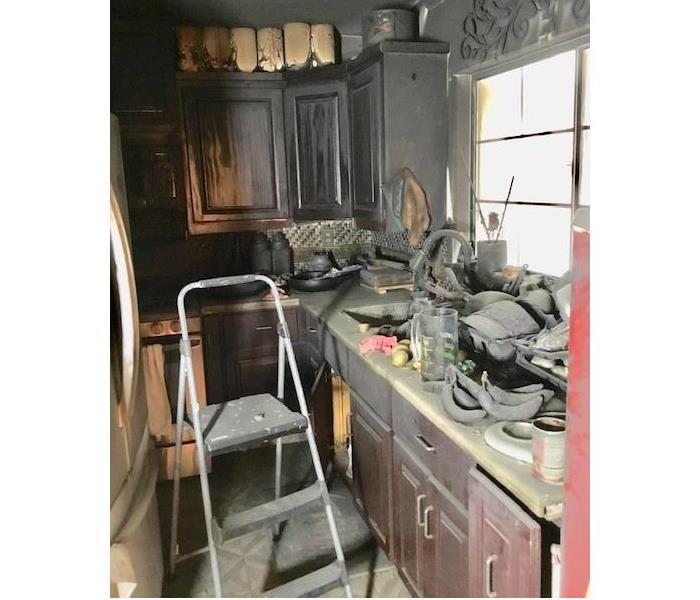 Smoke and Soot damage from a house fire in Riverside City
Smoke and Soot damage from a house fire in Riverside City
The smoke that lingers after a fire has been put out can be more damaging than you might think.
The problem that many homeowners have is that they don’t think a fire or smoke damage could ever happen to them. The reality is that home fires are incredibly common, ranging from the very minor to the more major. Despite the fact that a minor fire may not cause a lot of fire damage, it can still cause smoke damage that is difficult to clean and dangerous to be living around.
Smoke Damage that is a direct result of fire damage should ideally be cleaned by experts. Experts know how to get rid of smoke damage that might be present in the home after it has been ravished by flames. You should always look to hire a licensed and highly experienced professional who has extensive experience dealing with fire damage. The professionals will often start by evaluating the overall extent of the damage that is present in the home, and then they will go over prices and costs of damage remediation for you to get the issue cleaned up by their company.
There are a lot of reasons why handling smoke damage after a fire should be done by experts and as quickly as possible. The smoke that you find after a fire often contains ash, soot and sometimes even carbons and tar that might have come off of the flames. Also, carbon monoxide is incredibly common after fire damage has been exhibited. Carbon monoxide is one of the most dangerous things because it is odorless and cannot be seen or tasted. Therefore, you may not even know that you are surrounded by carbon monoxide until it has been properly tested. An expert damage restoration company will normally test for carbon monoxide levels in a home that has dealt with a fire.
Smoke damage can also be aesthetically damaging. Furniture, walls, ceilings and practically anything in your home can become black or gray from the smoke that has come off from a fire. Many things will need to be professionally cleaned, while other things might have to be fully removed from the home in order to get rid of the problem. Your remediation company will be the one who tells you what can and cannot be saved after you have dealt with massive smoke damage in your own home.
Fires are very common, and even the most minor fire can cause a lot of smoke damage. In fact, some homeowners who have simple fireplaces that are not well-vented could deal with smoke damage without a fire ever being an issue for the home itself. Handling the damage on your own should be avoided simply because of all of the expertise that needs to go into cleaning the mess. Also, you need to have a professional test the home or room for carbon monoxide to ensure that it is going to be safe for you or for them to go in there to clean. For more information please visit SERVPRO of West Riverside City
Our Fire Damage Restoration Services
Every fire damage situation is a little different and requires a unique solution, but the general process stays the same. When various materials burn, the soot they create differs greatly and requires a specific cleaning procedure. The steps listed below illustrate our process for the “typical” fire damage restoration. Learn more about our fire damage restoration process.
Emergency ContactInspection and Fire Damage AssessmentImmediate Board-Up and Roof Tarp Service (if needed)Water Removal and Drying (if water damage is present)Removal of Smoke and Soot from All SurfacesCleaning and RepairRestorationFeel free to call us, we are here to help!
Call Us Today – (951) 351-8033
Heating your Home Safely in Riverside City
1/7/2019 (Permalink)
There is something about the winter months and curling up with a good book by the fireplace. But did you know that heating equipment is one of the leading causes of home fire deaths? With a few simple safety tips and precautions you can prevent most heating fires from happening.
BE WARM AND SAFE THIS WINTER!
- Keep anything that can burn at least three feet away from heating equipment, like the furnace, fireplace, wood stove, or portable space heater.
- Have a three-foot "kid-free zone" around open fires and space heaters.
- Never use your oven to heat your home.
- Have a qualified professional install stationary space heating equipment, water heaters or central heating equipment according to the local codes and manufacturer's instructions.
- Have heating equipment and chimneys cleaned and inspected every year by a qualified professional.
- Remember to turn portable heaters off when leaving the room or going to bed.
- Always use the right kind of fuel, specified by the manufacturer, for fuel burning space heaters.
- Make sure the fireplace has a sturdy screen to stop sparks from flying into the room. Ashes should be cool before putting them in a metal container. Keep the container a safe distance away from your home.
- Test smoke alarms at least once a month.
Heating Equipment Smarts
Install wood burning stoves following manufacturer's instructions or have a professional do the installation. All fuel-burning equipment should be vented to the outside to avoid carbon monoxide (CO) poisoning.
Install and maintain CO alarms to avoid the risk of CO poisoning. If you smell gas in your gas heater, do do not light the appliance. Leave the immediately and call your local fire department or gas company.
FACT
Half of home heating fires are reported during the months of December, January, and February.
NATIONAL FIRE
PROTECTION ASSOCIATION
The leading information and knowledge resource
on fire, electrical and related hazards
nfpa.org/education ONFPA 2017
Call SERVPRO
After the fire trucks are gone, your Riverside home and belongings likely suffer from not only fire and smoke damage, but also extensive water damage from firefighting efforts. SERVPRO of West riverside City has the specialized fire and water damage cleanup and restoration training and experience to quickly restore your home to pre-fire condition. We also have specific training and equipment for odor removal and deep cleaning of upholstery and carpet.
Fire damage can be devastating for you and your family. Feelings of confusion and stress are common, and you need a caring expert to guide you through this crisis. We always treat your family with the greatest empathy and respect, and we’ll treat your property with great care.
Why Call SERVPRO?
We’re Faster to Any Size Disaster
When fire and water damage strikes, a fast response is critical. We’re dedicated to responding immediately, day or night, to your Riverside home or business. A faster response helps to prevent secondary damage and to reduce cost.
We’re Fire and Water Damage Specialists
As water and fire damage specialists, we have the experience, the expertise, and the advanced training that enables us to get your property restored quickly and thoroughly.
Fire & Smoke Restoration TechnicianOdor Control TechnicianUpholstery & Fabric Cleaning TechnicianWater Damage Restoration TechnicianOur Restore vs. Replace Mentality
We clean and restore your property using specialized equipment and cleaning techniques. Our “restore first” mentality reduces interruption and gets you back to your life.
Our Fire Damage Restoration Services
Every fire damage situation is a little different and requires a unique solution, but the general process stays the same. When various materials burn, the soot they create differs greatly and requires a specific cleaning procedure. The steps listed below illustrate our process for the “typical” fire damage restoration. Learn more about our fire damage restoration process.
Emergency ContactInspection and Fire Damage AssessmentImmediate Board-Up and Roof Tarp Service (if needed)Water Removal and Drying (if water damage is present)Removal of Smoke and Soot from All SurfacesCleaning and RepairRestorationHave Questions about Fire, Smoke, or Soot Damage?
Call Us Today – 951-351-8033
Fire Safety and Candles in your Riverside Home
12/6/2018 (Permalink)
There’s a special beauty and tranquility to candles, but a lighted candle is also an open flame, and a potential fire hazard if not carefully monitored.
In fact, accidental candle fires account for approximately four percent of all U.S. residential fires.
A study by the U.S. Consumer Product Safety Commission suggests that 85 percent of candle fires could be avoided if consumers followed three basic safety rules:
Never leave a burning candle unattended.Never burn a candle on or near anything that might catch fire.Keep candles out of the reach of children and pets.The National Candle Association urges consumers to always follow the basic rules of fire safety when burning candles.
HOW TO BURN A CANDLE SAFELY
BEFORE LIGHTING
Before burning, always trim the wick to ¼ inch. You can use a wick trimmer, nail clippers, or scissors. Long or crooked wicks can cause uneven burning, dripping or flaring.When lighting a candle, use long matches or a long-reach lighter. Keep your hair and loose clothing away from the flame.Always use a candleholder specifically designed for candle use. It should be heat resistant, sturdy, and large enough to contain any drips or melted wax.Burn candles in a well-ventilated room.Place the candleholder on a stable, heat-resistant surface. This will also help prevent possible heat damage to counters and table surfaces and prevent glass containers from cracking or breaking.Keep the wax pool clear of wick trimmings, matches and debris at all times.Avoid drafts, vents or air currents. This will help prevent rapid or uneven burning, sooting, and excessive dripping.Follow the manufacturer’s recommendations on burn time and proper use. In general, it is recommended that candles do not burn for longer than four hours and cool for at least two hours before relighting.WHILE BURNING
Never touch or move a burning candle. Never move a votive or container candle when the wax is liquefied.Don’t burn a candle all the way down. For a margin of safety, discontinue burning a candle when 2 inches of wax remains (1/2 inch if in a container).Place burning candles at least three inches apart from one another. This is to make sure they don’t melt one another, or create their own drafts that will cause the candles to burn improperly.Extinguish a candle if the flame becomes too high or flickers repeatedly. Let the candle cool, trim the wick, and check for unwanted drafts before re-lighting.Always keep the candle within your sight. If you are going to leave the room, be sure to first blow out all candles.Always burn candles in a well-ventilated room. Don’t burn too many candles in a small room or in a “tight” home where air exchange is limited.Never use a candle as a night light.Be very careful if using candles during a power outage. Flashlights and other battery-powered lights are safer sources of light during a power failure. Never use a candle during a power outage to look for things in a closet, or when fueling equipment – such as a lantern or kerosene heater.Never burn a candle on or near anything that can catch fire. Keep burning candles away from furniture, drapes, bedding, carpets, books, paper, flammable decorations, etc.Keep candles out of the reach of children and pets. Do not place lighted candles where they can be knocked over by children, pets or anyone else.WHEN EXTINGUISHING
Use a candle snuffer to extinguish a candle. It’s the safest way to prevent hot wax from splattering.Never use water to extinguish a candle. Water can cause the hot wax to splatter and might break a glass container.Make sure the candle is completely out and the wick ember is no longer glowing before leaving the room.Don’t touch or move the candle until it has completely cooled.Never use a knife or sharp object to remove wax drippings from a glass holder. It might scratch, weaken, or cause the glass to break upon subsequent use.Download a complete list of candle safety rules.
WHAT MAKES A SAFE & QUALITY CANDLE?
NCA invites you to view the webinar, What Makes a Safe & Quality Candle? This webinar is designed to to educate and inform the retail community on candle basics, safety standards, and testing of candle products. This is a must for compliance personnel and candle buyers.
In this webinar, you will learn:
An Overview of Candle Basics: Wax and wick types, the difference between dyes and pigments, why fragrance does more than just smell nice, and how changing just one of these elements affects the entire candle.The ASTM Safety Standards in Plain English: What it means when a flame is too high, what “secondary ignition” and “end of useful life” mean, and the requirements for glass and plastic containers, candle accessories, warning labels and more.What to Ask For and Expect from Your Test Lab: What determines if a candle passes or fails the ASTM standards, the common causes of test failures, and what to do if you think you need additional testing.Plus: Tips for Success and Q&ACANDLE FIRE STATISTICS
An estimated 8,700 residential fires are caused each year by the careless or inappropriate use of candles, according to the National Fire Protection Association (NFPA.)
The National Candle Association urges consumers to always keep a burning candle within sight, keep candles away from anything combustible, and to keep candles out of the reach of children and pets.
Roughly one-third of home candle fires start in bedrooms, says the NFPA. Avoid using candles in bedrooms or any place where people are likely to fall asleep.
Three of every five candle fires started when something that could burn, such as furniture, mattresses or bedding, curtains, or decorations, was too close to the candle.
In 16% of the fires, the candles were unattended or abandoned, according to the NFPA.
*SOURCE: HOME CANDLE FIRES, FIRE ANALYSIS AND RESEARCH DIVISION, NATIONAL FIRE PROTECTION ASSOCIATION, DECEMBER 2015. BASED ON 2009-2013 ANNUAL AVERAGES
Riverside Residents, Learn How to Use a Fire Extinguisher
11/26/2018 (Permalink)
 Remember the acronym P.A.S.S.
Remember the acronym P.A.S.S.
Learning How to Use a Fire Extinguisher Can Help You For a Future Emergency
It’s important to understand that with the proper training and education, fire extinguishers can save lives and property. Many adults might not know how or when to use fire extinguishers.
A portable fire extinguisher can be a life and property saving tool when used correctly. In order to operate an extinguisher, the National Fire Association suggests remembering the word PASS: Pull the pin. Hold the nozzle pointing away from you and release the locking mechanism. Aim low. Point the extinguisher at the base of the fire. Squeeze the lever slowly and evenly. Sweep the nozzle from side-to-side. Read the instructions on the fire extinguisher and become familiar with them before a fire breaks out. Remember, extinguishers do have limitations. It is also important to ensure you have the correct type of extinguisher for your facility. Refer to the back of this brochure to learn more about the different classes of extinguishers and the type of fire each are designed to extinguish.
Class A: For use with ordinary materials like cloth, wood and paper. Often found in homes and businesses.
Class B: For use with combustible and flammable liquids like grease, gasoline, oil and oil-based paints. Often found in homes and businesses.
Class C: For use with electrical equipment like appliances, tools, or other equipment that is plugged in. Often found in homes and businesses.
Class D: For use with flammable metals Often found in factories
Class K: For use with vegetable oils, animal oils and fats in cooking appliances. Often found in commercial kitchens (restaurants, cafeterias, catering businesses)
Contact SERVPRO of West Riverside City if you experience fire loss. Putting out a fire can be worse than the fire itself. The first 48 hours after a fire damage can make the difference between restoring versus replacing your property and personal belongings. SERVPRO of West Riverside City will provide timely response with mitigation services ranging from fire, smoke, and soot removal to contents. Our services help ensure your property, belongings and memories are restored to preloss condition when possible.
Halloween Fires-Ensure that Halloween is a safe holiday for everyone in Riverside
10/24/2018 (Permalink)
 Halloween fires occurred most frequently in the late afternoon and early evening hours, peaking between 6 p.m. and 7 p.m.
Halloween fires occurred most frequently in the late afternoon and early evening hours, peaking between 6 p.m. and 7 p.m.
Candle flames and flammable costumes can be a dangerous combination
- COSTUMES: Flame-resistant fabrics, such as polyester and nylon, are best. They should be brightly colored or trimmed with reflective tape to make them visible to motorists at dusk and in the dark.
- MASKS: Check that eye holes are large enough to allow full visibility and nose holes allow for adequate breathing.
- CANDLES: Keep candle-lit jack-o-lanterns and other decorations where children cannot brush against the flame. Try LED lights instead.
- TREATS: Put reflective tape on treat bags. No toys with small parts for children under 3.
October is Fire Protection Month here in West Riverside and across the US
10/22/2018 (Permalink)
Pet Fire Safety
Home fires are the most common disaster that the American Red Cross responds to – and also the most preventable.
- The best way to protect your pets from the effects of a fire is to include them in your family plan. This includes having their own disaster supplies kit as well as arranging in advance for a safe place for them to stay if you need to leave your home.
- When you practice your escape plan, practice taking your pets with you. Train them to come to you when you call.
- In the event of a disaster, if you must evacuate, the most important thing you can do to protect your pets is to evacuate them, too. But remember: never delay escape or endanger yourself or family to rescue a family pet.
Prevent Your Pets from Starting Fires
The National Fire Protection Association estimates that nearly 1,000 home fires each year are accidentally started by the homeowners' pets.
The American Kennel Club and ADT Security Services have joined forces to provide the following tips:
- Extinguish Open Flames - Pets are generally curious and will investigate cooking appliances, candles, or even a fire in your fireplace. Ensure your pet is not left unattended around an open flame and make sure to thoroughly extinguish any open flame before leaving your home.
- Remove Stove Knobs - Be sure to remove stove knobs or protect them with covers before leaving the house - a stove or cook top is the number one piece of equipment involved in your pet starting a fire.
- Invest in Flameless Candles - These candles contain a light bulb rather than an open flame, and take the danger out of your pet knocking over a candle. Cats are notorious for starting fires when their tails turn over lit candles.
- Secure Young Pets - keep them confined away from potential fire-starting hazards when you are away from home such as in crates or behind baby gates in secure areas.
Help Firefighters Help Your Pets
- Keep pets near entrances when away from home. Keep collars on pets and leashes at the ready in case firefighters need to rescue your pet. When leaving pets home alone, keep them in areas or rooms near entrances where firefighters can easily find them.
- Affix a pet alert window cling and write down the number of pets inside your house and attach the static cling to a front window. This critical information saves rescuers time when locating your pets. Make sure to keep the number of pets listed on them updated.
Fire Safety for Kids in West Riverside City
10/17/2018 (Permalink)
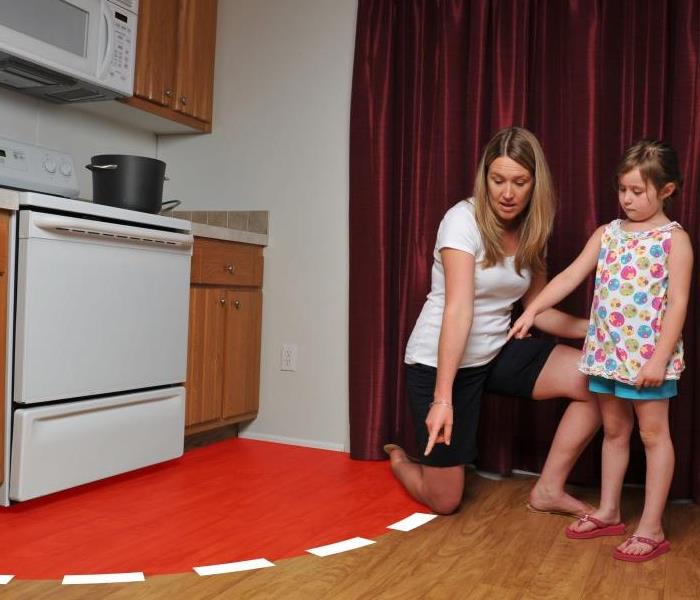 Teach children the importance of remaining at a safe distance from a stove
Teach children the importance of remaining at a safe distance from a stove
Tips from our friends at American Red Cross
A home fire is a devastating event, and one that you never count on happening. Your children are most at risk when this disaster occurs. In fact, children under five are twice as likely as other people to die in a home fire. Tragically, many home fires are started by children playing with dangerous household items – especially lighters and matches. Taking sensible precautions in the home and teaching your child how to escape from a fire can help your family avoid this type of heartbreak.
Prevent Your Child from Starting Fires
The U.S. Fire Administration estimates that 300 people are killed and $280 million in property is destroyed each year as the result of children playing with fire.
Keep matches, lighters and other ignitable substances in a secured location out of your child’s reach. Only use lighters with child-resistant features.Invest in flameless candles. These candles contain a light bulb rather than an open flame, and take the danger out of your child knocking over a candle.Help Your Child Survive a Fire
Install smoke alarms on every level of your home, inside bedrooms and outside sleeping areas. Once a month check whether each alarm in the home is working properly by pushing the test button. Replace batteries in smoke alarms at least once a year. Immediately install a new battery if an alarm chirps, warning the battery is low.Teach your children what smoke alarms sound like and what to do when they hear one.Ensure that all household members know two ways to escape from every room of your home, and where to meet up outside..Practice your fire escape plan at least twice a year and at different times of the day. Practice waking up to smoke alarms, low crawling and meeting outside. Make sure everyone knows how to call 9-1-1.Emphasize “get out, stay out.” Only professional firefighters should enter a building that is on fire—even if other family members, pets or prized possessions are inside.Use quick-release devices on barred windows and doors. Security bars without release devices can trap you in a deadly fire. If you have security bars on your windows, be sure one window in each sleeping room has a release device.Consider getting escape ladders for sleeping areas on the second or third floor. Learn how to use them, and store them near the windows.
How to Prevent Outdoor Cooking Fires!
10/10/2018 (Permalink)
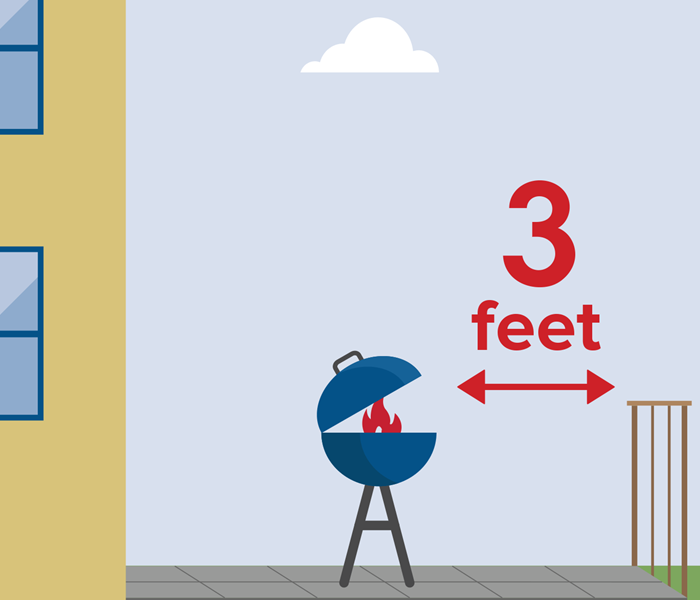 Place your grill at least 3 feet from siding, deck railings, eaves and overhanging branches.
Place your grill at least 3 feet from siding, deck railings, eaves and overhanging branches.
Grill fires cause an estimated $37 million in property loss each year.
Almost half of home grill fires happen between 5 and 8 p.m.Fifty-seven percent of home grill fires occur during the months of May, June, July and August.Patios, terraces, screened-in porches and courtyards are leading home locations for grill fires.Seventy-nine percent of all home grill fires involve gas grills.“Mechanical failure, malfunction” is the leading factor in the start of grill fires. Leaks or breaks of containers or pipes are often to blame.Source: Grill Fires on Residential Properties
Grilling fire safety tips:
Only use grills outdoors, away from siding and deck railings.Clean grills often and remove grease or fat build-up.Make sure your gas grill lid is open before lighting.Have a 3-foot safe-zone around grills and campfires. Keep kids and pets away from the area.Dispose of coals after they have cooled in a metal can.Never leave grills, fire pits and patio torches unattended.
Oct 7-13 is Fire Prevention Week
10/8/2018 (Permalink)
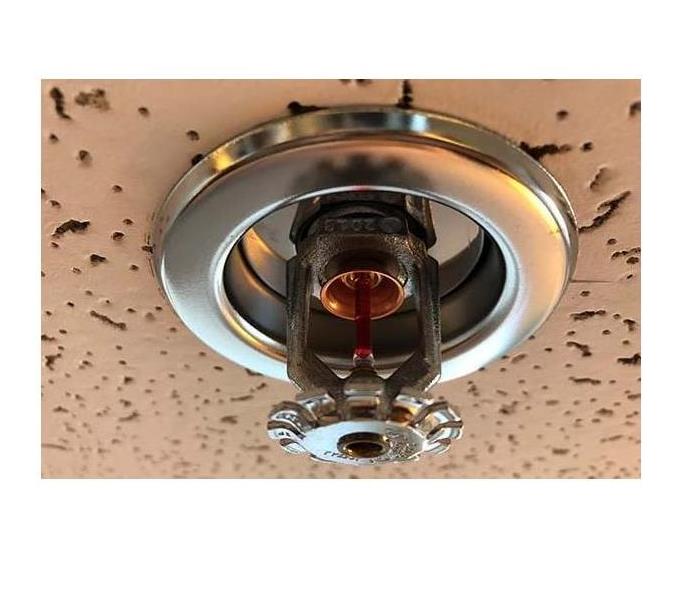 SERVPRO of West Riverside city increasing awareness of the life-saving and financial benefits of home fire sprinklers in our community.
SERVPRO of West Riverside city increasing awareness of the life-saving and financial benefits of home fire sprinklers in our community.
More than 50 percent of cooking fires are caused by grease according to the National Fire Protection Association (NFPA)...
“Look. Listen. Learn. Be aware – fire can happen anywhere.”
Prevent Kitchen Fires
Did you know? Cooking is the main cause of home fires and fire injuries. You can prevent cooking fires. Take these steps to keep your family safe!
Smoke alarms
Three out of five home fire deaths result from fires in properties without working smoke alarms.
- Choose interconnected smoke alarms, so when one sounds, they all sound.
- Put smoke alarms inside and outside each bedroom and sleeping area. Put alarms on every level of the home.
- Make sure your smoke alarms work. Your family is not safe if they can’t hear the smoke alarms.
- Test smoke alarms every month and replace 9-volt smoke alarm batteries at least once every year.
- Smoke alarms do not last forever. Get new smoke alarms every 10 years.
- When you hear a smoke alarm, you may have less than 2 minutes to get everyone outside and safe.
Fire Escape plan
If there is a fire in your home, you could have less than 2 minutes to get out safely once the smoke alarm sounds.
Make a fire escape plan. Draw a map of each level of your home showing all doors and windows. Discuss the map with everyone who lives with you.Plan two ways out of every room. Choose an outside meeting place in front of your home.Make a fire escape plan around your abilities. If you need to use a wheelchair or a cane, make sure you can get to it easily and get out quickly. If you wear hearing aids or eyeglasses, put them next to your bed while you are sleeping.Make sure all doors and windows open easily.Practice your fire escape plan by having a home fire drill at least twice a year with everyone in the home.If there is a fire in your home, get out and stay out. Never go back inside for people, pets or things.Home Fire Sprinklers
Installing sprinklers and smoke alarms in your home increases your chance of surviving a fire by more than 82 percent.
Safer fire service: The risk to firefighters is much less. Sprinklers reduce the heat, flame and smoke from a fire.Fast response: Home fire sprinklers are more sensitive to heat than those found in businesses or industrial buildings. This means the fire will be detected much sooner.Can blend with your home decor: You can buy home fire sprinklers in different colors. Some can be installed flush with the ceiling, so you will hardly notice they are there.Reliable: Home fire sprinklers only spray when the temperature in the room rises quickly. The sprinkler above the fire is the only one that sprays.Investment protection: Sprinklers can prevent devastating home damage by putting out flames quickly. Sprinklers can limit the damage caused by smoke and fire. They are less damaging than water damage caused by firefighting hose lines.Easy installation: Installing a home sprinkler system in a home under construction or being remodeled requires a little extra piping and labor and greatly increases the safety of residents.Low water requirement: Home fire sprinklers can be connected to the home water supply. They require less water than business and industrial systems.Low cost: A sprinkler costs about $1.35 per square foot. This cost is about the same as upgraded cabinets or carpet.Lower insurance: Installing a sprinkler system has the potential to lower insurance rates by 5-15 percent by meeting code requirements.
October is Fire Protection Month here in West Riverside and across the US
10/3/2018 (Permalink)
Tips for Making a Claim After a Fire
When a fire damages your home in Riverside, CA, you may not be in the right frame of mind for making good decisions. The decisions you make regarding your fire insurance claim, however, can affect how much of the fire restoration is covered by your insurer. Here are three tips to help you think through the process rationally and hopefully get the settlement you need to restore your home.
1. Call Insurance Company
One of the first calls you make after a fire has ravaged your home is to the insurance company. Timely reporting is essential to getting your claim processed and approved. As soon as the company receives your call, an assessor can be sent to review the damage and substantiate your claim.
2. Call Professional Restorers
After a fire, your home is likely permeated with the odor of smoke and soot damage. Firefighters probably had to use a lot of water to put out the fire, resulting in water damage as well. Certified fire restoration specialists offer both smoke cleaning and water damage remediation to fix the problems in your home. They often offer board-up services to secure the house during the restoration process, and they can give you an estimate on what the repairs are going to cost, which can back up your claim with the insurance company.
3. Don't Touch Anything
Once you have made the necessary calls and the waiting begins, you may be tempted to start cleaning up the damage yourself. Fight the urge to do so. The insurance agent that comes to assess the damage needs to see it as it is, and without the knowledge and skills of the specialists, you may cause more damage. While you wait, it is a good idea to take pictures of the damage as long as it is safe to do so.
You may feel powerless when your home suffers fire damage. By calling the appropriate professionals and waiting on their guidance, however, you can speed up the fire restoration process.
October is Fire Protection Month here in West Riverside and across the US
10/2/2018 (Permalink)
As Fire Prevention Week approaches, the West Riverside City Fire Department encourages residents to “Look. Listen. Learn.” What does that mean?
Look for places fire could start.Listen for the sound of the smoke alarm.Learn 2 ways out of every room. Every year, the majority of fire deaths in North America happen at home. Today’s home fires burn faster than ever. In a typical home fire, you may have as little as one to two minutes to escape safely from the time the smoke alarm sounds.
Home Fire Escape Planning:
• Home fire escape planning and drills are an essential part of fire safety. A home fire escape plan needs to be developed and practiced before a fire strikes.
• A home escape plan should include the following:
- Two exits from every room in the home – usually a door and a window
- Properly installed and working smoke alarms
- A meeting place outside, in front of the home, where everyone will meet after they exit
- A call to 9-1-1 or the local emergency number from a cell phone or a neighbor’s phone Smoke Alarms
• Smoke alarms detect and alert people to a fire in the early stages. Smoke alarms can mean the difference between life and death in a fire.
• Working smoke alarms cut the risk of dying in a home fire in half.
• Install smoke alarms in every sleeping room, outside each separate sleeping area, and on every level of the home, including the basement.
• Test smoke alarms at least once a month using the test button.
• Make sure everyone in the home understands the sound of the smoke alarm and knows how to respond. Cooking
• Cooking is the leading cause of home fires and home fire injuries. The leading cause of fires in the kitchen is unattended cooking.
• Stay in the kitchen when you are frying, boiling, grilling, or broiling food.
• If you are simmering, baking, or roasting food, check it regularly and stay in the home.
• Keep anything that can catch fire away from your stovetop. Heating
• Heating equipment is one of the leading causes of home fires during the winter months.
• Space heaters are the type of equipment most often involved in home heating equipment fires.
• All heaters need space. Keep anything that can burn at least 3 feet (1 meter) away from heating equipment.
• Have a 3-foot (1-meter) “kid-free zone” around open fires and space heaters.
• Purchase and use only portable space heaters listed by a qualified testing laboratory.
• Have a qualified professional install heating equipment.
• Maintain heating equipment and chimneys by having them cleaned and inspected by a qualified professional
For more information on recovering from fire damage, contact SERVPRO of West Riverside City- 951-351-8033, were here to help our neighbors
How To Safely Put Out a Grease Fire
9/27/2018 (Permalink)
More than 50 percent of cooking fires are caused by grease according to the National Fire Protection Association (NFPA)
Your home’s kitchen is where heat, electricity, water, and grease come together. It’s no wonder, kitchen fires are the number one cause of home fires. And the most common type of kitchen fire is a grease fire. A grease fire is extremely dangerous as it can get out of control quickly and spread from the stove throughout the kitchen and other rooms of the house.
There are two common types of grease fires in the kitchen. One is in the cooking pan itself and the other is under the burner in the drip pan. Often, drip pan fires result from previous cooking sessions. When something is spilled into the drip pan it cannot be cleaned until the burner and the stove has cooled. It’s not uncommon for people to forget to go back and clean the drip pan, setting themselves up for trouble the next time they cook.
Here are some tips for preventing kitchen grease fires:
- Before cooking anything, make sure the burner is cool and wipe up any spills in the drip pan and around the burner before turning on the heat.
- The most common reason for a grease fire is leaving a hot pan unattended. Keep your eye on all pans while cooking.
- Pay attention to heat ratings for cooking oil. Some oils can be heated more than others before catching fire. If you are cooking and the oil starts to smoke, it is too hot. The flash point of a grease fire is 500 degrees Fahrenheit. Grease will smoke furiously before it ignites, so if you notice smoke, turn down the heat immediately.
- Keep cookbooks, towels, paper towels and anything combustible away from the stove. A grease fire can quickly turn into a bigger fire if it catches onto other combustibles.
- Avoid heating grease before putting food into it. Food can fall quickly into the grease and make it splash out, causing grease burns to you or hitting the heat source and catching fire.
- When deep frying, use a pan or cooking container designed for deep frying that will allow equal space of the grease and food contents above what you are frying. For example, if you are cooking chicken and the grease and chicken are three inches deep, the pan sides should be at least six inches deep.
- Have a class ABC fire extinguisher in your kitchen. Experts recommend having at least three fire extinguishers in your home; in the kitchen, garage and main living area.
- If a pan does catch fire, the best thing to do is smoother it, by using an oven mitt and placing a lid on top of the pan or by using a fire extinguisher. NEVER throw water on the fire or try to run it to the sink or outside.
And if a kitchen grease fire does get out of control, resulting in damage or odor to your home, our experts at SERVPRO of West Riverside are here to help. We can clean your home "Like it never even happened."
Fire Damage Restoration Tips in Riverside, CA
7/30/2018 (Permalink)
 Contact us if you have any questions regarding a fire or smoke damage.
Contact us if you have any questions regarding a fire or smoke damage.
Fire Restoration Help
What To Do After A Fire
- Limit movement in the home to prevent soot particles from being embedded into upholstery and carpets.
- Keep hands clean so as not to further soil upholstery, walls and woodwork.
- Place clean towels or old linens on rugs, upholstery and carpet traffic areas.
- If electricity is off, empty freezer and refrigerator and prop doors open.
- Clean and protect chrome with light coating of petroleum jelly or oil.
- Change HVAC filter.
- Tape double layers of cheesecloth over air registers.
What NOT to Do After A Fire
- Don't attempt to wash any walls or painted surfaces or shampoo carpet or upholstery without contacting us.
- Don't attempt to clean any electrical appliances that may have been close to fire, heat or water without consulting an authorized repair service.
- Don't use any canned or packaged food or beverages that may have been stored near the fire, heat or water.
- Don't turn on ceiling fixtures if ceiling is wet. The wiring may be damaged.
- Don't send garments to an ordinary dry cleaner. Improper cleaning may set smoke odor.
Have Smoke or Fire Damage? Call 951-351-8033
Fire Restoration, Riverside CA and surrounding areas
7/16/2018 (Permalink)
Fire Restoration
Often times after a fire people assume everything is a loss. When hiring professionals like SERVPRO of West Riverside City the process of restoration can save a lot of the presumed loss.
Professionals can clean smoke damage and restore items affected by a fire, but they must be brought to the site as soon as possible to halt the ongoing issues that ash residue can cause. The first thing that ash does to the home is discolor most surfaces. Anything that is made of plastic or was close to the fire will start discoloring within minutes, and within several hours, fiberglass and finishes on appliances will begin to yellow. Metals may also tarnish. After a few days’ pass, the ash will cause walls to discolor permanently, along with clothing and upholstery. Wood and vinyl will need to be refinished or replaced, and metal will start corroding.
The fire, smoke and soot are the expected result of the fire and most people do not think of the damage the water used to extinguish the fire can cause. It is equally important to extract the water and dry the structure properly. If not dried properly even more damage can result in the future.
Quick action to hire professionals such as SERVPRO of West Riverside City helps keep costs down as prevention of further damage is key. Without quick action metals may need to be replaced, carpet will permanently discolor and glass may be severely etched. It will also become apparent that the odors caused by the disaster may still be present and intense enough to not only be distracting, but in some cases harmful. Because ash is acidic, the longer it takes to hire experts, the more destruction it will cause.
This entire process is very detailed, and hiring a professional like SERVPRO of West Riverside City that can be trusted to do the job right is imperative.
Each disaster needs its own special attention to detail and that is why SERVPRO of West Riverside City has a team that will come and assess the damage and create a scope of work needed to take you through the entire process of remediation through reconstruction to make it “Like it never even happened”. You may visit http://www.SERVPROwestriversidecity.com/fire-smoke-damage-restoration to learn more.
SERVPRO of West Riverside City professionals stand ready to help you 24/7 365 days a year 951-351-8033
Fire Restoration, Riverside CA and surrounding areas
5/9/2018 (Permalink)
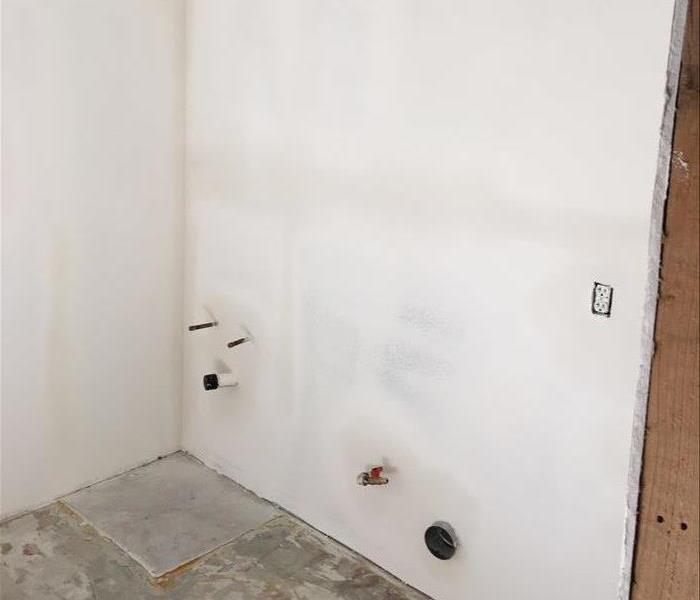 After photo from fire started in Laundry Room
After photo from fire started in Laundry Room
Fire Damage Restoration
At SERVPRO of West Riverside City we strive to please our customers. Our goal is to always have your property look “like it never even happened”. You may feel stressed and confused after such a disaster, and you’ll need a caring expert to guide you through this crisis.
SERVPRO of West Riverside City has the specialized fire and water damage equipment and expertise to help you through this tough time. Immediate action is crucial when dealing with water and fire damage. We’re dedicated to responding immediately when you need help. A fast response helps lessen the damage, limits secondary damage, and reduces cost. Check out our before and after page to see photos of fire losses we have recently worked on. Click here to see a few examples.
Kitchen Fire - SERVPRO does Fire Restoration
4/25/2018 (Permalink)
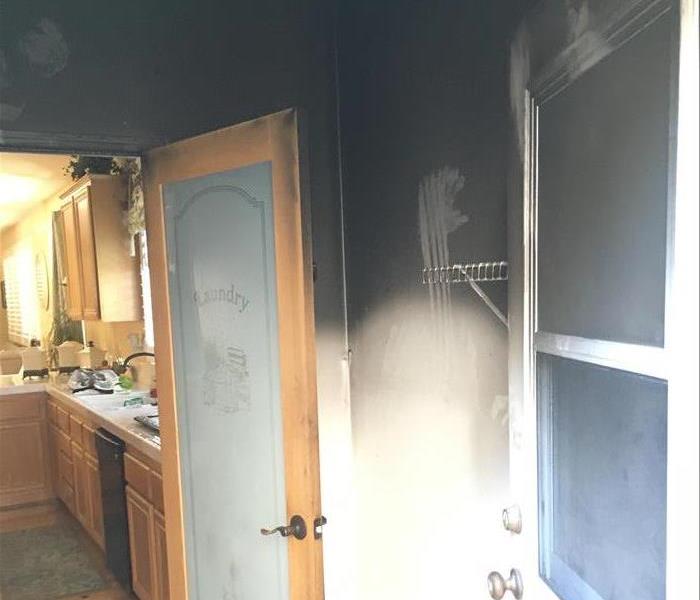 Call us if you have any questions about Fire, Smoke, or Soot Damage?
Call us if you have any questions about Fire, Smoke, or Soot Damage?
Smoke and soot is very invasive and can penetrate various cavities within your home, causing hidden damage and odor. Our smoke damage expertise and experience allows us to inspect and accurately assess the extent of the damage to develop a comprehensive plan of action.
Smoke and soot facts:
- Hot smoke migrates to cooler areas and upper levels of a structure.
- Smoke flows around plumbing systems, seeping through the holes used by pipes to go from floor to floor.
- The type of smoke may greatly affect the restoration process.
Our Fire Damage Restoration Services
Since each smoke and fire damage situation is a little different, each one requires a unique solution tailored for the specific conditions. We have the equipment, expertise, and experience to restore your fire and smoke damage. We will also treat your family with empathy and respect and your property with care.
Have Questions about Fire, Smoke, or Soot Damage?
Call Us Today – 951-351-8033
Smoke Damage Cleanup
4/11/2018 (Permalink)
 Call us for a Smoke Damage Professional Consultation today. 951-351-8033
Call us for a Smoke Damage Professional Consultation today. 951-351-8033
A fire can wreak havoc on any residential or commercial building in Riverside, CA. Once everything has settled down, you need to begin addressing the remaining smoke damage. This will require you to hire professional smoke cleaning services. This cleanup team will have a lot to take care of, and you want to allow them to handle remediation rather than attempting to fix items on your own.
1. Remedy Smoke and Fire Damage
Soot damage can travel fast. Areas of the building that did not actually catch fire may still need to be remedied for smoke and soot. This is particularly true for textiles and upholstery. You do not want to simply toss these items in a washing machine. Improperly washing items with soot may only deteriorate them further. Instead, give these items to professionals so that they can be washed and dry-cleaned adequately.
2. Clean Up Fire Retardant
Smoke damage restoration professionals will also need to clean up any fire retardant used to put out the fire. Whether this is material that came from a fire extinguisher or from the firefighters, it could be dangerous to handle on your own. Some extinguishers use ammonium phosphate, and you do not want to use chlorine to clean up that chemical. Experts know what precautions to take to stay safe.
3. Throw Away Badly Damaged Items
Although professionals will know how to salvage some items, it will be best to throw others away. Occasionally, this disposal is in the best interest of your health and safety. For example, food should always be disposed of following a fire. It could become contaminated from smoke and soot, making it dangerous to consume.
Rectifying smoke damage is a multi-pronged approach. The expert team you hire will need to carry out some basic actions to ensure your company gets back up and running in no time.
Visit http://www.SERVPROwestriversidecity.com for more information on commercial fire damage.
Fire Don't Have to Burn
3/21/2018 (Permalink)
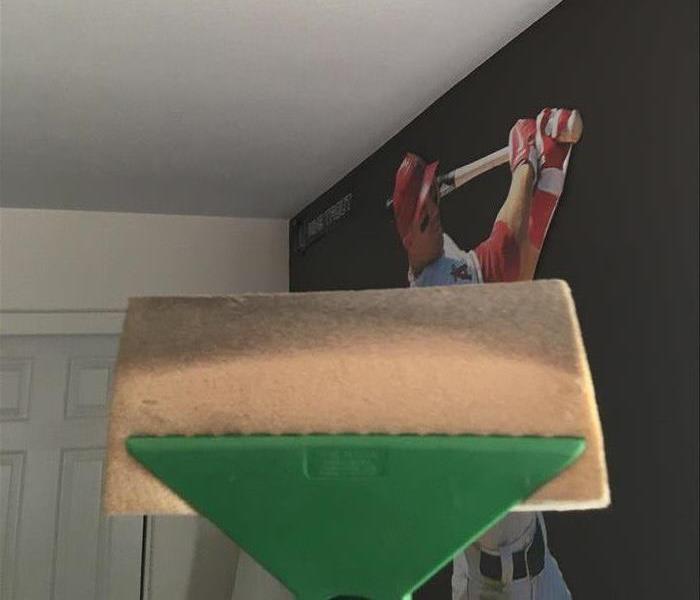 Fires in the home or workplace may occur from something as simple as an overloaded socket.
Fires in the home or workplace may occur from something as simple as an overloaded socket.
Fires can happen anywhere at anytime in the workplace or the home. Home fires are most commonly caused from cooking, candles, careless smoking, space heaters or dirty chimneys. Fires may also erupt from an overloaded outlet or extension cord.
When it comes to fires in the workplace, the issue, as in the home, is often general negligence. Negligence often refers to leaving food in the microwave too long, leaving hot drinks where they may be spilled on electrical wires, and as in the home, overloading sockets or extension cords.
Most of these fires can be avoided by keeping a vigilant eye on things and regularly checking and maintaining appliances, extension cords and sockets, as well as keeping both home and work environments clean and free of clutter. As well, it helps to prepare for potential fires by keeping fire extinguishers, smoke alarms and carbon monoxide alarms in high risk areas throughout the house and workplace. Where appropriate, especially in the work environment, think about having fire sprinkler systems installed. As well, make sure family, friends and employees are aware of safety precautions involved to prevent potential fires.
If your home or business does suffer a fire damage, water damage, mold damage or bio-hazard event, SERVPRO of West Riverside City is ready 24/7 to be 'Faster to any size disaster'. Our team is IICRC trained and certified to make it 'Like it never even happened'. And we will treat your property, family and employees with the utmost of compassion, respect and consideration.
Call SERVPRO of West Riverside City 951-351-8033
Smoke Damage in your Riverside, CA home
2/16/2018 (Permalink)
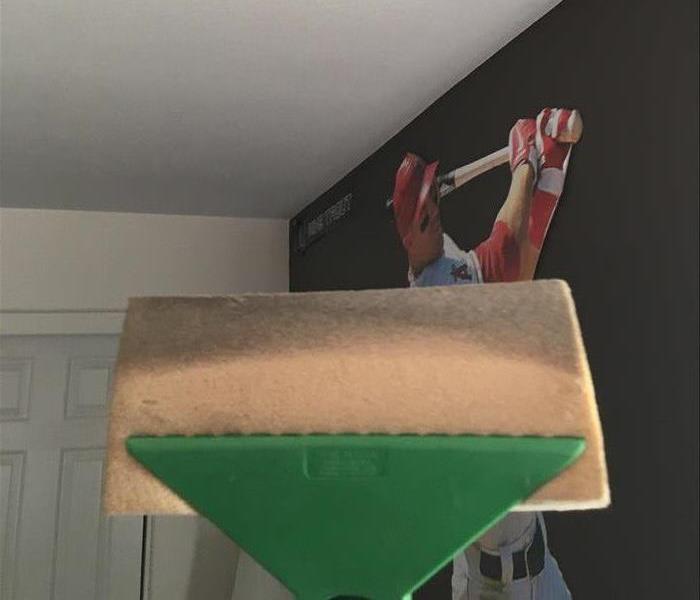 Cleaning a visibly "clean" wall to find heavy amounts of invisible soot on the walls. Have your home professionally cleaned after a smoke damage.
Cleaning a visibly "clean" wall to find heavy amounts of invisible soot on the walls. Have your home professionally cleaned after a smoke damage.
You’re relieved that the fire damage was minimal but shocked to find that the smoke damage is extensive.
It is easy to forget about the destructive power of smoke but we are quickly reminded of it by the horrible odor that is filling your home. The smoky pollutant irritates your eyes and airways, while the sticky residue on scorched walls and the layer of ashes begin to corrode your personal possessions.
The urgency to clear out the smoke sets in as you realize that although the flames did not reach far, the smoke did massive damage. Smoke and ashes travel through doors and vents, reaching your entire home, penetrating your carpet, drapes, and furniture with the odor of smoke.
Even the paint on the wall is not safe! Microscopic molecules of smoke embed deep into the pores and crevices of almost anything.
As you can see, a simple opening of windows, a wipe down with a household cleaner, and the passage of time will not be enough to fix this sort of smoke damage.
So call SERVPRO to come and put your life back together quickly and professionally. 951-351-8033
Dryer Fire Damage
1/30/2018 (Permalink)
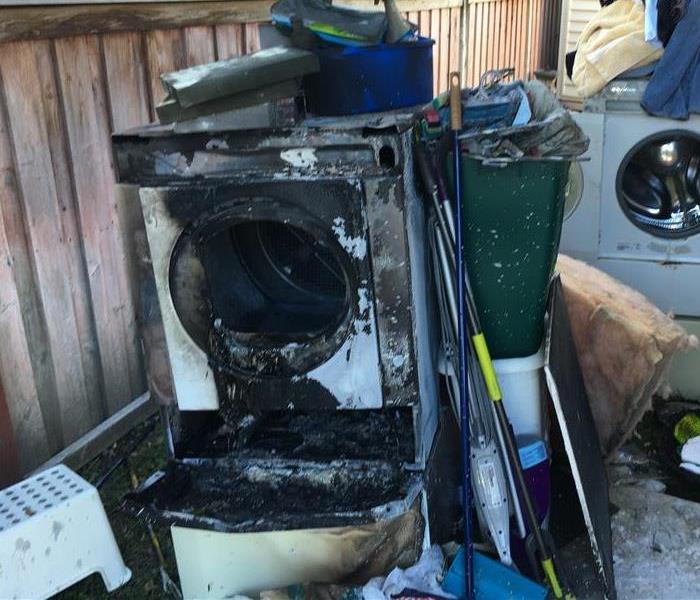 Dryer fires are one of the lead causes of fires in home
Dryer fires are one of the lead causes of fires in home
You may not think of your clothes dryer as a fire hazard, but these appliances account for tens of thousands of house fires each year. The problem most frequently occurs when lint and dust are allowed to build up. Over time, this can cause the dryer vent to become clogged with highly flammable materials, which easily combust when exposed to high temperatures. Your best option for dryer safety is to clean the lint trap each time before you use the dryer, and to inspect and clean the dryer vent area to remove lint buildup and other potential blockages. Regular cleaning can ultimately make all the difference in avoiding a house fire.
Quick statistics: 2,900 home clothes dryer fires are reported each year and cause an estimated 5 deaths, 100 injuries, and $35 million in property loss.
What to do Immediately after a Home Fire
1/30/2018 (Permalink)
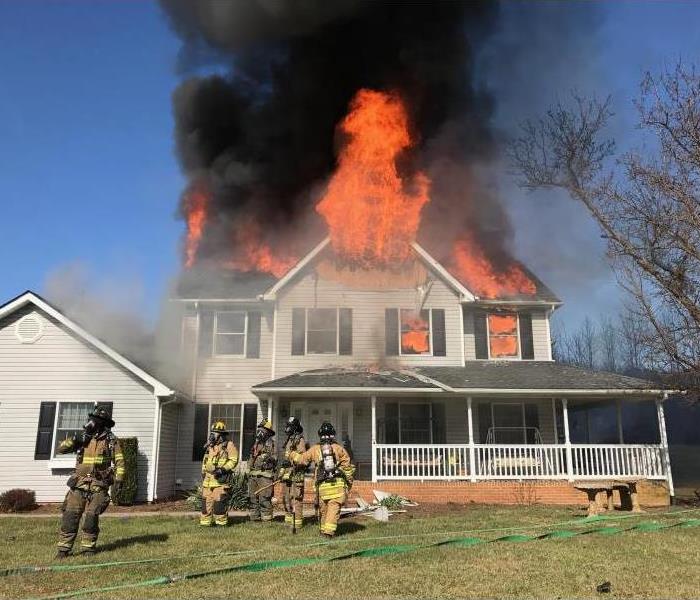 SERVPRO is here to help!
SERVPRO is here to help!
- Ask whether it is safe to enter the home. Do not enter if the fire authorities deem it unsafe. They may establish a safety zone, but never assume a room is safe, until it has been cleared to enter.
- Know who to call.
- Contact family members and let them know you are safe, and unharmed.
- Contact your insurance agent. They will be able to talk you through the necessary steps, including proper documentation and emergency lodging and living expenses (keep all of your receipts!) The insurance company may assist in securing a company to help with clean up options.
- You may request SERVPRO at this time for contents cleaning, restoration etc. Contact SERVPRO.
- Another call may be to your landlord if applicable, and to your local American Red Cross.
- Secure the property to prevent possible looting. SERVPRO is available to assist with securing property/ Board Ups.
- If water hoses were used to exterminate the fire, drying your home is critical. It is best to call the professionals at SERVPRO to do water/ fire cleanups. Water can lead to mold damage if not dried properly. SERVPRO is an approved restoration contractor for many major insurance carriers and adheres to the highest standards in the restoration industry.
- Seek counseling if needed. Children and adults can feel a traumatic sense of loss, and may need help to avoid a lasting sense of sadness and disorientation after a house fire. Don’t be afraid to reach out for help. A house fire is a traumatic event and individuals need to be treated with respect and compassion by those close to the process of rebuilding.
For more information on contents and structural drying, extinguisher residue and soot removal call SERVPRO at 951-351-8033.
How to Prevent Fires Starting from Dryers
1/15/2018 (Permalink)
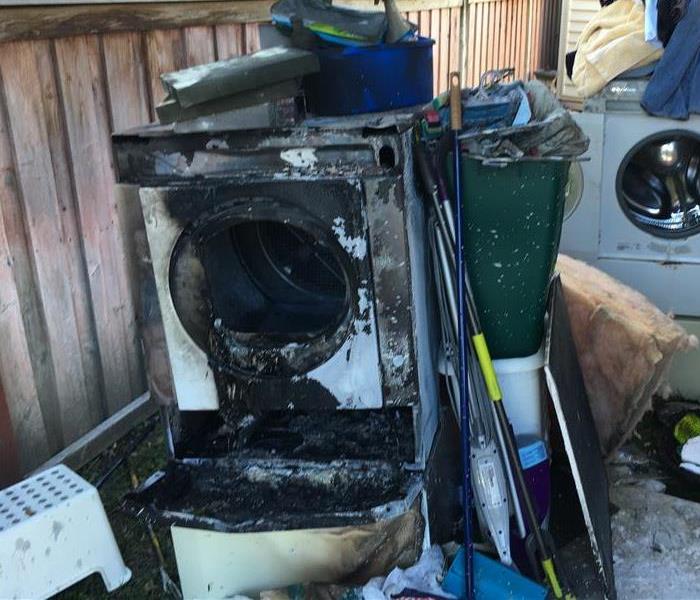 Please clean your dryer vents and ducting regularly for safety.
Please clean your dryer vents and ducting regularly for safety.
In 2010 an estimated 16,800 home fires, involving clothes dryer occurred.
- An estimated 2,900 clothes dryer fires in residential buildings are reported to U.S. fire departments each year and cause an estimated 5 deaths, 100 injuries, and $35 million in property loss.
- Clothes dryer fire incidence in residential buildings was higher in the fall and winter months, peaking in January at 11 percent.
- Failure to clean (34 percent) was the leading factor contributing to the ignition of clothes dryer fires in residential buildings.
- Dust, fiber, and lint (28 percent) and clothing not on a person (27 percent) were, by far, the leading items first ignited in clothes dryer fires in residential buildings.
- Fifty-four percent of clothes dryer fires in residential buildings were confined to the object of origin.
For more information click HERE
Fire Damage From Candle
1/15/2018 (Permalink)
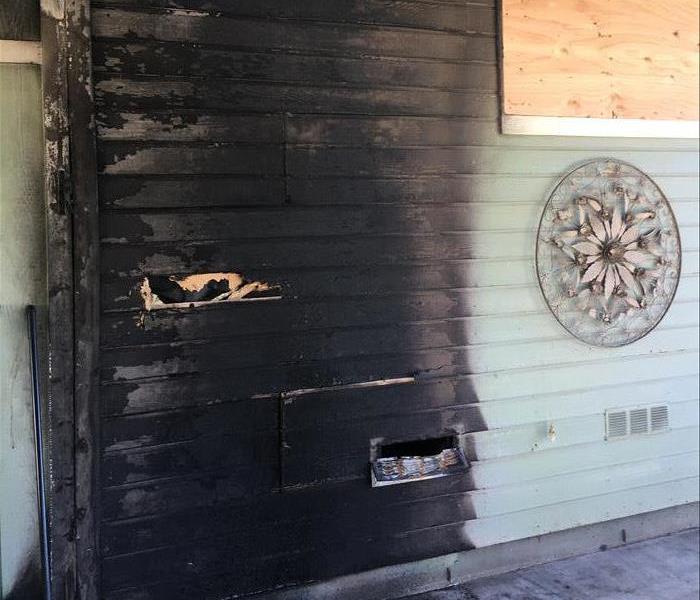 Fire Damage caused by a Candle
Fire Damage caused by a Candle
Smoke damage to walls can come in many forms, from the black sooty deposits that linger after a fire to cigarette smoke. The method used to clean this type of fire damage depends on the type of wall and the nature of the damage. After a house fire, it is always advisable to consult a professional restoration company. They have the tools, experience, and gear to do the job properly.
This home in Riverside was affected by a fire that started with a candle on a table. Read more about fire candle prevention tips here.
All traces of smoke and soot on the walls and furniture after this fire damage was properly cleaned and taken care of by SERVPRO.
If your walls have sustained smoke and fire damage, you can count on SERVPRO to restore them to preloss conditions quickly and efficiently, "Like it never even happened."
Wildfire Preparedness
1/2/2018 (Permalink)
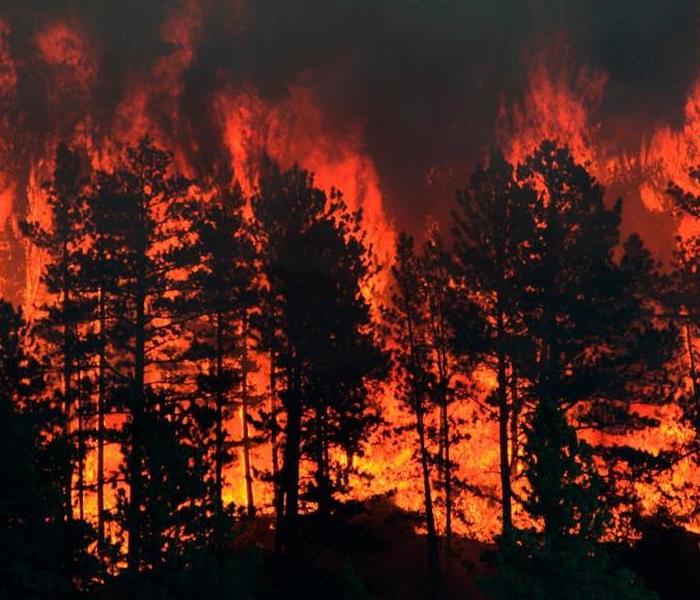 Have Questions about Fire, Smoke, or Soot Damage?
Call SERVPRO today
Have Questions about Fire, Smoke, or Soot Damage?
Call SERVPRO today
What
A wildfire is an unplanned, unwanted fire burning in a natural area, such as a forest, grassland, or prairie. As building development expands into these areas, homes and businesses may be situated in or near areas susceptible to wildfires. This is called the wildland urban interface.
Wildfires can cause death or injury to people and animals, damage or destroy structures, and disrupt community services including transportation, gas, power, communications, and other services. The impact may cover large areas with extensive burning, embers traveling more than a mile away from the wildfire itself, and smoke causing health issues for people far away from the fire. Wildfires damage watersheds leave areas prone to flooding and mudslides for many years.
When
Wildfires can occur at any time throughout the year, but the potential is always higher during periods with little or no rainfall, which make brush, grass, and trees dry and burn more easily. High winds can also contribute to spreading the fire. Your community may have a designated wildfire season when the risk is particularly high.
Before
Make a Wildfire plan
Know your wildfire risk.
- Familiarize yourself with local emergency plans. Know where to go and how to get there should you need to evacuate.
- Make a wildfire emergency plan including an evacuation plan and a communication plan.
- Many communities have text or email alerting systems for emergency notifications. To find out what alerts are available in your area, search the Internet with your town, city, or county name and the word “alerts.”
- Build or restock your emergency preparedness kit, including a flashlight, batteries, cash, and first aid supplies.
- Stay tuned to your phone alerts, TV, or radio, for weather updates, emergency instructions or evacuation orders.
After
Returning Home
Return home only when authorities say it is safe.
For several hours after the fire, maintain a "fire watch." Check and re-check for smoke, sparks or hidden embers throughout the house, including the roof and the attic.
- Use caution when entering burned areas as hazards may still exist, including hot spots, which can flare up without warning. Evacuate immediately if you smell smoke.
Cleaning Your Home
Wear a NIOSH certified-respirator (dust mask) and wet debris down to minimize breathing dust particles.
Discard any food that has been exposed to heat, smoke or soot.
Do NOT use water that you think may be contaminated to wash dishes, brush teeth, prepare food, wash hands, or to make ice or baby formula.
- Photograph damage to your property for insurance purposes.
Here are some more information about wildfires form ready.gov.
Have Questions about Fire, Smoke, or Soot Damage?
Call Us Today – (951) 351-8033
Candle Fire Safety
12/29/2017 (Permalink)
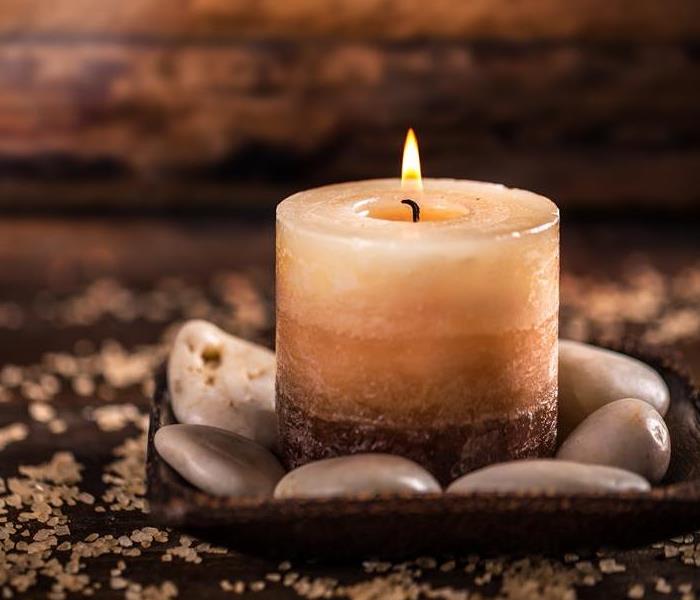 If you experience a fire or smoke damage in your Riverside home, call SERVPRO for fire cleanup.
If you experience a fire or smoke damage in your Riverside home, call SERVPRO for fire cleanup.
The darker winter season is upon us and a lot of us enjoy candles to light up our homes. But did you know that are several thousand home fires every year that is started by candles?
Here are some facts about candles that might make you take extra precautions when it comes to candles in your home.
From 2009-2013, U.S. fire departments responded to an estimated 9,300 home structure fires that were started by candles. These fires caused 86 deaths, 827 injuries and $374 million in direct property damage.
Facts and figures
During the five-year period of 2009-2013:
- December is the peak time of year for home candle fires. In December, 11% of home candle fires began with decorations compared to 4% the rest of the year.
- Roughly one-third (36%) of home candle fires started in bedrooms. These fires caused 32% of the associated deaths and 47% of the associated injuries.
- Falling asleep was a factor in 11% percent of the home candle fires and 30% of the associated deaths.
- On average, 25 home candle fires were reported per day.
- More than half (58%) of home candle fires occurred when some form of combustible material was left or came too close to the candle.
- Candles caused 3% of reported home fires, 3% of home fire deaths, 6% of home fire injuries, and 5% of the direct property damage in home fires.
If you experience a fire or a smoke damage in your Riverside home, don't hesitate to call SERVPRO West Riverside City at 951-351-8033.
Read more here about fire prevention tips.
Smoke Types
10/5/2016 (Permalink)
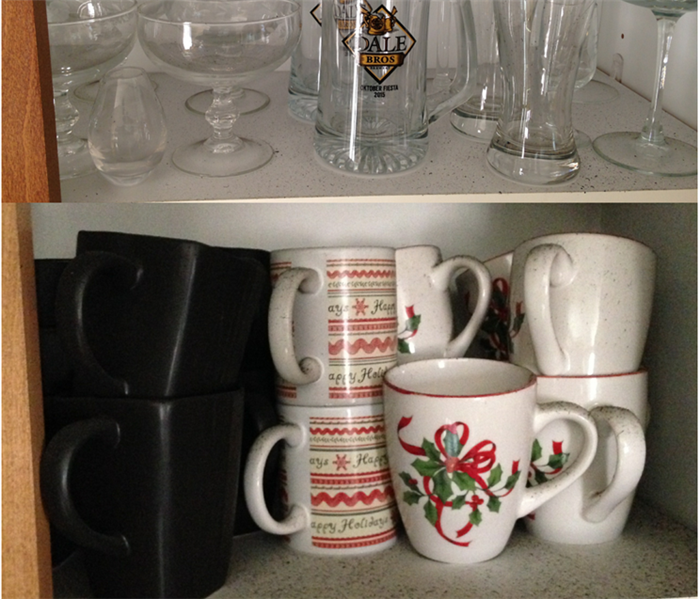 Contents inside cabinets affected by candle fire that created "Wet Smoke" damage in Riverside CA.
Contents inside cabinets affected by candle fire that created "Wet Smoke" damage in Riverside CA.
Let's talk smoke...
So just like everything else, smoke has a few secrets and tricks to it that most people are not aware of, but here at SERVPRO of West Riverside City, it’s our job to know them to properly conduct smoke damage restoration when we get the call.
A client gives us a call after coming home and finding that a small candle that was left lit while they were gone burned down to its end but not before burning its decorative plastic wrapper, a table cloth and a leather phone case. As well as melting other nearby objects like hand lotion bottles. These items produced a type of smoke categorized as “Wet Smoke”. This is because when most plastics and synthetic man made materials burn, they produce a dark, sticky ash that almost behaves like grease. Unfortunately, when our clients got back home, that’s the ash that awaited them and it covered all their belongings. Thankfully, the worst did not happen and their home was not lost or damaged from the fire other than needing an extensive cleaning and painting some of the walls and ceilings.
So why is identifying the smoke type important information for us? Because now we know the kind of cleaning method we will need to utilize when attempting to restore the house to its former glory. “Wet Ash” must be cleaned off the walls with a wet method such as a cloth damped in a special solution to most effectively remove the ash. When something like paper or wood burns, it produces a “Dry Smoke” that can be cleaned with a dry method such as using a special dry sponge that will collect the ash in its pores. Attempting to clean these different ash types with reversed cleaning methods will result in further damage or permanent staining of the surface.
Smoke Types
Wet Smoke - Plastics and Synthetic Materials. Low heat, pugnant odor, sticky residues.
Dry Smoke - Paper and Wood. Fast burning, high temperatures.
Protein Smoke - Food. Virtually invisible residues, discolors paints and varnishes, extreme pugnent odor.
Fire & Smoke Damage Tips
Do:
- Limit movement in the home or work area to prevent soot particles from being embedded into upholstery and carpet.
- Keep hands clean. Soot on hands can further soil upholstery, walls and woodwork.
- Place dry, colorfast towels or old linens on rugs, upholstery and carpet traffics areas.
- If electrical is off, empty freezer and refrigerator completely and prop doors open to help prevent odors.
- Wipe soot from chrome on kitchen and bathroom faucets, trim and appliances, then protect with these surfaces with a light coating of lubricant.
Don’t:
- Attempt to wash any walls or painted surfaces without first consulting a professional.
- Attempt to shampoo carpet or upholstered furniture without first consulting a professional.
- Attempt to clean any electrical appliances (TV sets, radios, etc.) that may have been close to fire, heat or water without first consulting an authorized professional.
- Turn on ceiling fixtures if ceiling is wet. Wiring may be wet or damaged and cause electrical shock, and air movement may create secondary damage.
The Behavior of Smoke
10/27/2015 (Permalink)
A fire loss can result in complex damages because of the unique behavior of smoke. Our professionals know smoke can penetrate various cavities within the structure, causing hidden damage and odor. Here are some facts you may not know about smoke.
Did you know?
8/22/2014 (Permalink)
Fire sprinklers have been saving lives for more than a century! Stopping a fire early may reduce the amount of property damage.
http://www.servprowestriversidecity.com/fire-smoke-damage-restoration
 If clothes are still damp after a normal cycle, the lint screen or exhaust vent may be blocked. Hire a professional to clean your dryer and dryer duct
If clothes are still damp after a normal cycle, the lint screen or exhaust vent may be blocked. Hire a professional to clean your dryer and dryer duct






 24/7 Emergency Service
24/7 Emergency Service

































